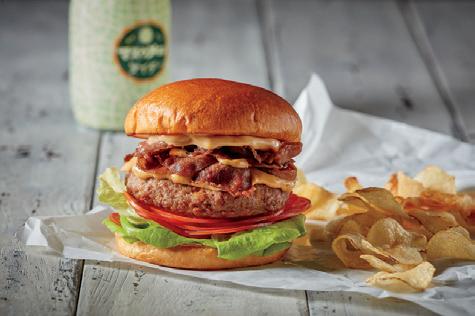FROM FASHION TOCULINARY
THE CASE FOR PLANT-BASED

A NEW WAY OF LOOKING AT MENU TRENDS
GRUMPY’S FRANCHISE EXPANSION
RAISING THE BAR

FROM FASHION TOCULINARY
THE CASE FOR PLANT-BASED

GRUMPY’S FRANCHISE EXPANSION
RAISING THE BAR
LEADERS SHARE INSIGHTSON NAVIGATING THEUNIQUE HOSPITALITY ENVIRONMENT
PLUS
CHEF ROBERT CASSIDY IS ACCELERATING ASIAN FUSION IN SAN DIEGO
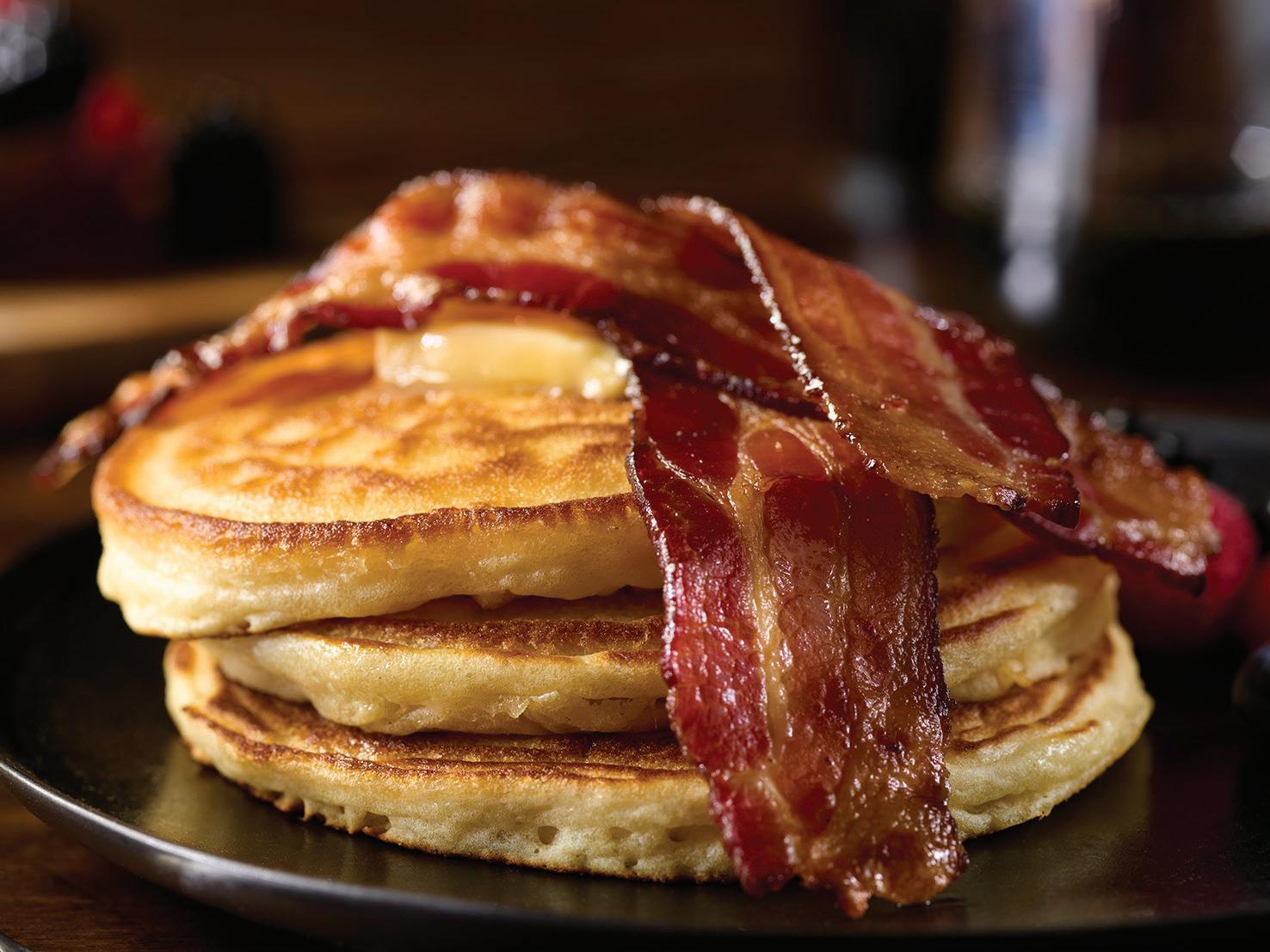

Smithfield Select Fully Cooked Bacon pleases patrons while saving you time, labor and costs back-of-house. It’s premium, thick-cut and crispy, with a golden-brown color edged with a dark ring for visual appeal. While it has a texture and appearance that make it seem as if the bacon was cooked from raw, you can just heat it in the microwave or throw it on the flat top for quick and easy prep. You’ll love its ease. They’ll love its natural, consistent flavor and superior sensory experience. Contact your Smithfield representative or call 1-888-327-6526.














HOTEL AND RESORT RESTAURANT CHEFS ARE TASKED WITH ELEVATING THE HOSPITALITY EXPERIENCE FOR GUESTS EVEN MORE THAN STANDALONE ESTABLISHMENTS.

From operational challenges and writing an appealing menu to managing people and enhancing the guest experience, hotel chefs share their insights on navigating the unique hospitality environment.
As we head into 2025, it’s time to start thinking about trends a little differently and zero in on what resonates with you and your restaurant brand.
CHEFS & INGREDIENTS
Chef Robert Cassidy is serving up a bold fusion of flavors at Cloak & Petal, a Tokyo-inspired speakeasy with innovative eats and drinks in San Diego’s Little Italy.
14 The Case for Plant-Based
Restaurateurs Tara Gilbert and Antonio Brown are changing the landscape of Atlanta’s vegan scene.
LIQUID INTELLIGENCE
17 Raising the Bar
Experts from Bar Louie, COJE, and more sound off on trends, challenges, and opportunities for the world of beverage service.


4 Olive Garden Finally Embraces Delivery
After years of resisting the channel, the casual giant will begin testing the service before rolling it out nationwide.
6 The Biggest Pain Points for Operators
New data from Expert Market’s 2024 F&B Industry report reveals the main challenges for restaurant owners.
57 From Fashion Intern to Culinary Icon
WOMEN IN LEADERSHIP Chef Eileen Andrade continues to push the boundaries of elevated Cuban-Asian cuisine while paying homage to her family’s culinary legacy at her Miami restaurants, Finka Table & Tap and Amelia’s 1931.
59 The Rebirth of Grumpy’s Diner ON THE RISE A finance and franchise expert is breathing new life into the Floridabased breakfast brand with a focus on homestyle cooking and a family atmosphere.
EDITORIAL
VP, EDITORIAL DIRECTORFOOD, RETAIL, & HOSPITALITY
Danny Klein dklein@wtwhmedia.com
FSR EDITOR
Callie Evergreen cevergreen@wtwhmedia.com
QSR EDITOR Ben Coley bcoley@wtwhmedia.com
ASSOCIATE EDITOR Sam Danley sdanley@wtwhmedia.com
ASSOCIATE EDITOR Satyne Doner sdoner@wtwhmedia.com
SVP, AUDIENCE GROWTH Greg Sanders gsanders@wtwhmedia.com
CONTENT STUDIO
VP, CONTENT STUDIO Peggy Carouthers pcarouthers@wtwhmedia.com
WRITER, CONTENT STUDIO Ya’el McLoud ymcloud@wtwhmedia.com
WRITER, CONTENT STUDIO Olivia Schuster oschuster@wtwhmedia.com
DESIGN
ART DIRECTOR Erica Naftolowitz enaftolowitz@wtwhmedia.com
LinkedIn.com/company/ FSR-magazine Instagram.com/FSRmagazine Facebook.com/FSRmag Twitter.com/FSRmag

2024 REGIONAL GOLD AWARD: PUBLICATION DESIGN
2023 NATIONAL GOLD AWARDS: FRONT COVER (PHOTO), BEST USE OF COLOR NATIONAL SILVER AWARD: BEST USE OF TYPOGRAPHY
2016 MAGAZINE OF THE YEAR TOP 10 AWARD
2015 MAGAZINE OF THE YEAR
FOLIO: Eddie Awards
2022 BEST FULL ISSUE HOSPITALITY
2022 BEST SPONSORED CONTENT
2021 BEST PROFILE FEATURE 2017
2013
® SALES & BUSINESS DEVELOPMENT
VP SALES: FOOD, RETAIL, & HOSPITALITY
Lindsay Buck lbuck@wtwhmedia.com
VP, BUSINESS DEVELOPMENT
Eugene Drezner 919-945-0705 edrezner@wtwhmedia.com
NATIONAL SALES DIRECTOR Amber Dobsovic 757-637-8673 adobsovic@wtwhmedia.com
NATIONAL SALES DIRECTOR Edward Richards 216-956-6636 erichards@wtwhmedia.com
NATIONAL SALES MANAGER Mike Weinreich 561-398-2686 mweinreich@wtwhmedia.com
CUSTOMER SERVICE REPRESENTATIVE
Tracy Doubts 919-945-0704 tdoubts@wtwhmedia.com
ADMINISTRATION
919-945-0704 www.fsrmagazine.com/subscribe
FSR is provided without charge upon request to individuals residing in the U.S. who meet subscription criteria as set forth by the publisher.
REPRINTS
THE YGS GROUP 800-290-5460 fax: 717-825-2150 fsrmagazine@theygsgroup.com
Sponsored content in this magazine is provided to the represented company for a fee. Such content is written to be informational and nonpromotional. Comments welcomed at sponsoredcontent@ fsrmagazine.com.
FOUNDER
Webb C. Howell
FULL ISSUE
& BEVERAGE
DESIGN, NEW MAGAZINE

cevergreen@wtwhmedia.com FSRmag @FSRmagazine
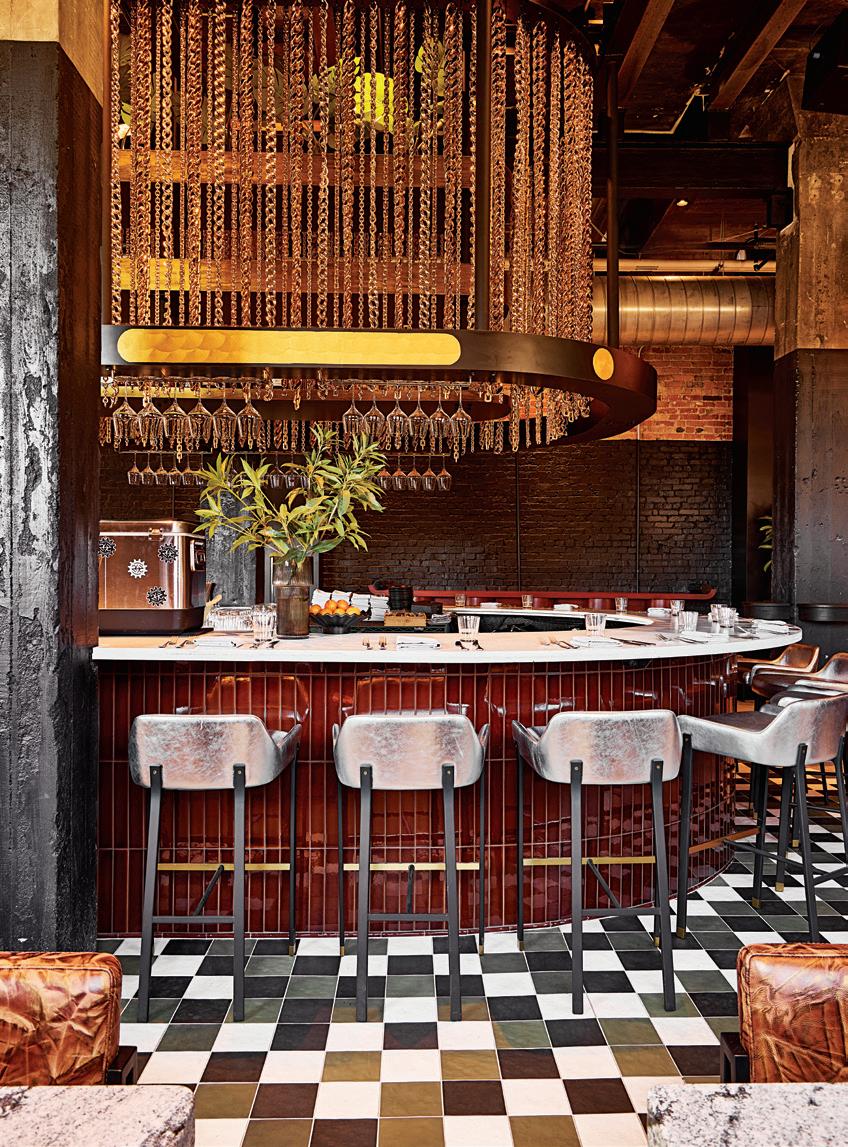
Pictured on our cover is Golden Hour, the flagship wood-fire restaurant led by chef Jacob Sessoms that is located in The Radical boutique hotel in Asheville, North Carolina, which was hit hard by Hurricane Helene in September. Everyone on the team is safe, but The Radical is temporarily closed until further notice. The team will be sharing updates on their socials and website, theradicalavl.com.
AS OF PRESS TIME IN EARLY OCTOBER, the devastation from Hurricane Helene was still being uncovered as the death toll crept north of 200 people, making it one of the deadliest hurricanes to hit the U.S. this century. The storm made landfall along the Florida Gulf Coast in late September with winds above 140 mph and a 15-foot storm surge, which caused historic flooding as it dumped unprecedented amounts of rain. Storm-related fatalities were reported in Florida, Georgia, the Carolinas, Tennessee, and Virginia, with hundreds still missing, according to news reports. Entire coastal communities were swept away, and the town of Asheville, North Carolina, was largely underwater with roads collapsed and inaccessible, and many left desperate for water, food, power, medical care, and cell service to communicate.
In the aftermath, several of the hotel restaurant chefs featured in our November cover story (PAGE 20) were impacted. Helmed by chef Jacob Sessoms, Golden Hour is the flagship wood-fire restaurant located in The Radical boutique hotel in Asheville. Everyone on the team is safe, but The Radical is temporarily closed until further notice and only open to first responders and disaster relief workers. The hotel restaurant was distributing free sandwiches and hot meals in the River Arts District.
Oak Steakhouse at Skyline Lodge in Highlands, North Carolina, is open, and everyone is accounted for and safe, including executive pastry chef Ashley Cannon. The team was offering Wi-fi and coffee to all surrounding residents and those in need.
In the midst of the heartbreak, this gives me hope. You can count on people in the restaurant and hospitality industry to rise up to support each other, their employees, and their communities. Stay tuned for further updates on our website, fsrmagazine.com.
If you’re able and willing to donate to relief efforts for those affected in Western North Carolina, the NC Hospitality Workers Relief Fund is accepting contributions. Managed by the NCRLA Foundation, all funds raised will go directly to support restaurant and hotel employees in Western North Carolina facing significant financial hardship in the aftermath of the storm. You may donate directly to the fund or consider establishing fundraising efforts in your business and remitting proceeds directly to the NC Hospitality Workers Relief Fund. To learn more, you can contact Courtney Hamm at CHAMM@NCRLA.ORG or 919-844-7883
To donate or apply for financial assistance, visit NCRLA.ORG/FOUNDATION/ NC-HOSPITALITY-WORKERS-RELIEF-FUND Any North Carolina restaurant, hotel, tavern, or hospitality-related business in good standing can submit a recommendation for financial assistance for any employee in need at any time.

Callie Evergreen EDITOR

Presently, about 60 percent of Olive Garden’s to-go orders are digital (either online or app). The brand also has 17 million-plus members in its eClub.
BY DANNY KLEIN
After years of resisting the channel, the casual giant will begin testing the service before rolling it out nationwide.
NOBODY IN THE LATE 2010s, as delivery tech really began to unlock the off-premises channel, had clear sight of the category’s future. Darden CEO Rick Cardenas, who began his career with the multiconcept group as a busser and became its fourth top executive in 2021, fig -








nience,” he noted. “It’s a different occasion.”
Olive Garden has offered delivery in a handful of stores in recent years, but resisted from a larger, companywide angle—it elected instead to focus on to-go and employee-fulfilled catering. In those units, however, of which there are “13 to 14,” the guests ordering delivery aren’t the same ones walking inside to eat. It’s a new moment in the purchasing journey. And that lends Darden to believe a wider rollout would drum up fresh business versus slicing from another channel.
In September, Darden announced an exclusive, two-year deal with Uber to begin offering Uber Direct delivery via the company’s own channels. Diners will go direct to Olive Garden, and Uber will handle the delivery through its national network of drivers. The first-party delivery pilot will start with a limited number of
Olive Garden locations in late 2024 in hopes of pressure-testing the technology. If all goes accordingly, Darden’s flagship will roll the service nationally by May 2025.
This decision signals a major turn for Darden after opposing the strategy for years. Darden didn’t want delivery to affect in-restaurant experience (no couriers in the lobby crowding space). In this case, it pulled learnings from the growth of curbside and to-go during the COVID haze. Drivers with delivery are now going to pick up orders curbside in the same fashion to-go guests do today.
Olive Garden will also offer the same everyday menu prices for dine-in, pickup, and delivery. Additionally, delivery is going to come at zero incremental cost to Darden. Olive Garden today does about $1 billion in to-go sales.
Inking an exclusive deal with
New data from Expert Market’s 2024 F&B Industry report (sponsored by hospitality platform Toast) revealed that 56% of U.S. F&B business owners say managing operational costs and maintaining profitability is their main challenge.
More than half of those (52%) are specifically concerned about rental increases. In addition to rent increases, inflation has driven up other expenses, with 37% of respondents identifying ingredient cost fluctuations as their primary operational concern. 52% say economic uncertainty is the second most common challenge.
Despite current woes, the food and beverage industry is optimistic about its future as predictions for 2025 suggest that concern about economic uncertainty will drop from 20% to 16%, according to the report.
Uber versus opening to the aggregator masses will enable Darden to strengthen and defend its competitive advantages of scale and data and insights, Cardenas said. In plain: since guests order via Olive Garden’s portal or mobile app, Darden keeps the data. “Overall, we view this as an incremental long-term sales driver,” he said. “This is a first-party delivery, not third-party delivery marketplace. It will take time for us to build sales.”
Darden does not plan on advertising through Uber Eats for Olive Garden. As it reaches scale, it can leverage other channels to drive consumers to its websites and mobile apps. But when a diner goes to place a To-Go order, they’ll see the option for delivery. Cardenas said a lot of people show up searching for the option. That’s where Olive Garden will start. Delivery is going to be available on the website before expanding to the app.









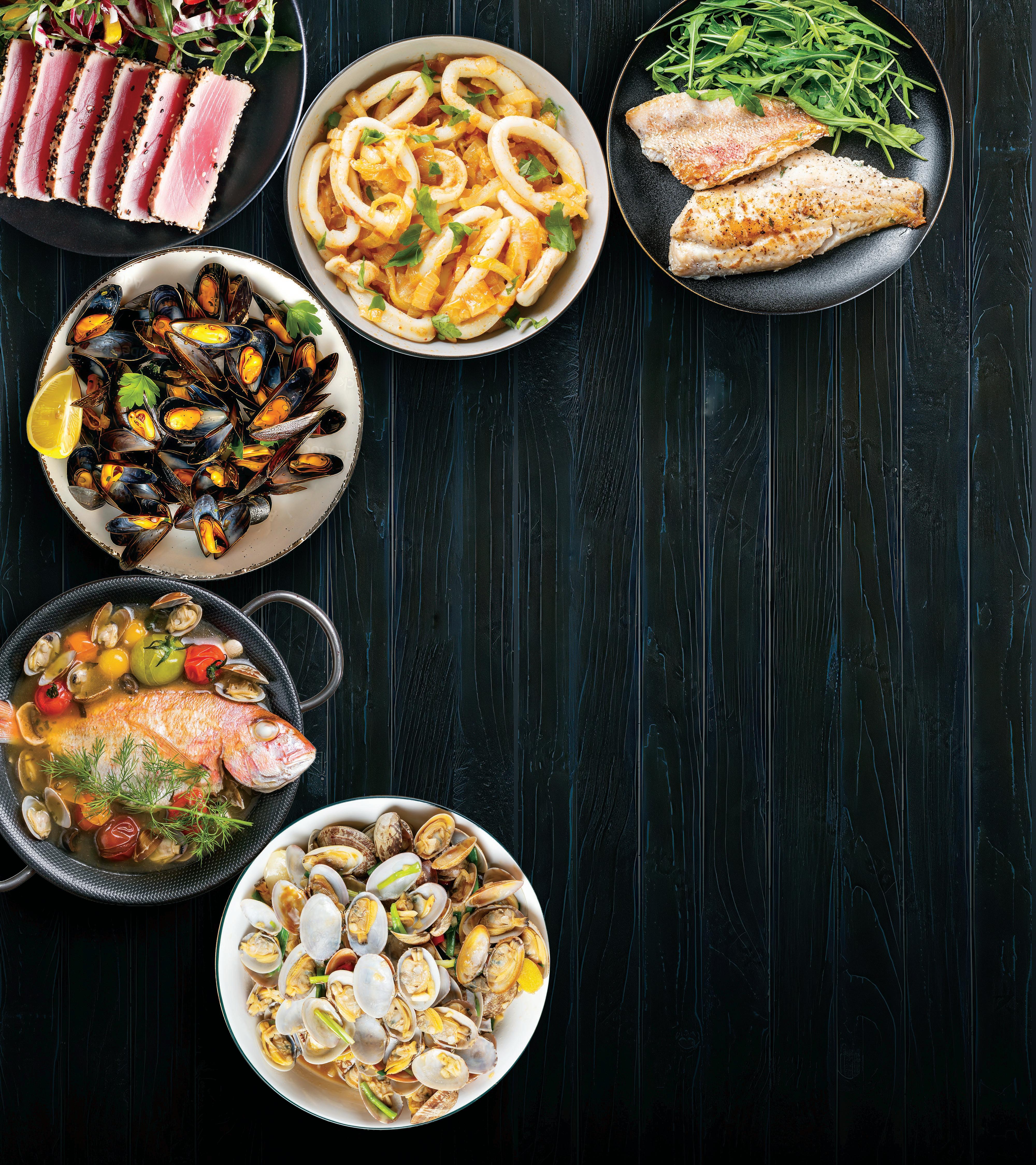

MENTIONED IN THIS SECTION CLOAK & PETAL • • BAR VEGAN • • THE BOUJEE SOUTHERNER
CLOAK & PETAL BLENDS EDGY STREET ART WITH UPSCALE DINING, OFFERING A SENSORY JOURNEY UNLIKE ANY OTHER IN SAN DIEGO’S LITTLE ITALY. THE MOODY, UNDERGROUND VIBE SETS THE STAGE FOR AN IMMERSIVE AND VISUALLY CAPTIVATING DINING EXPERIENCE.

BY CALLIE EVERGREEN
Chef Robert Cassidy is serving up a bold fusion of flavors at Cloak & Petal.
WHEN YOU STEP INTO Cloak & Petal’s speakeasy Shibuya Nights in San Diego’s Little Italy neighborhood, it’s as if you’ve been transported to a Tokyo speakeasy. The towering cherry blossom tree in the bar, the hand-painted wall murals and graffiti art, and the moody, Harajuku-inspired underground vibe all work together to create an immersive dining experience for guests, capturing what Thrillist described as a “see-and-be-seen” destination. At the heart of the kitchen is chef
Robert Cassidy, whose culinary journey has taken him from washing dishes at a sushi bar in college to helming the kitchen at one of San Diego’s most unique Japanese fusion restaurants.
“From my own experience when I first walked into here, you walk in the front doors, it’s a little dark, and then you’re just hit with this huge cherry blossom tree in the bar—it’s beautiful, and you don’t really see it from the street until you walk in,” Cassidy recalls. “When everyone walks in, they’re taking pictures of everything. Our art in the back, or by the bathroom, by the trees; it’s really beautiful in here.”
Keeping the menu up to par with the aesthetics of the artsy restaurant and its vibrant colors and theme is a challenge, Cassidy admits. It helps that it’s not a strictly traditional sushi spot. Case in point: there are speciality roles like “Face it, You’re Basic” has panko shrimp, avocado, krab, tempura crunchy flakes, spicy aioli, and sweet soy reduction; spe -
UNDER THE GLOW OF NEON LIGHTS AND TOWERING CHERRY BLOSSOMS, DINERS AT CLOAK & PETAL ARE TRANSPORTED TO A WORLD OF JAPANESEINSPIRED ELEGANCE AND FLAVOR.

FAVORITE SPICE AT THE MOMENT: Infused salts
ALTERNATIVE PROFESSION: Firefighter
FAVORITE VEGGIE: Radishes
SECRET COMFORT FOOD: In-N-Out Burger
FAVORITE FOODIE DESTINATION: Korea or Las Vegas


ciality sashimi like “Wagyu Mafia” with a wagyu strip, yuzu kosho, Irish white cheddar, chives, spiraled seasoned potatoes, and micro greens; and house rolls like the Philadelphia with salmon, cream cheese, and cucumber.
“What’s really popular in America right now are the rolls. Rolls are very easy to configure different sauces and salt and flavors onto them, and that’s what people are familiar with here,” Cassidy explains.
The extensive, innovative beverage menu also pushes the boundaries, with “Wake Me Up, F*ck Me Up” featuring Mr. Black Coffee liqueur, Starward Two-Fold Whiskey, and demerara sugar; “Oaxacan-Through-Eden” with mezcal, cucumber, celebrity apple syrup, lime, and Genepy herbal liqueur; and “Tea Ceremony” with chamomile-infused vodka, pineapple, honey, and lemon, which can be made into a large-format punch bowl cocktail to be shared.
“I think what separates us from other sushi restaurants is our caliber; we do


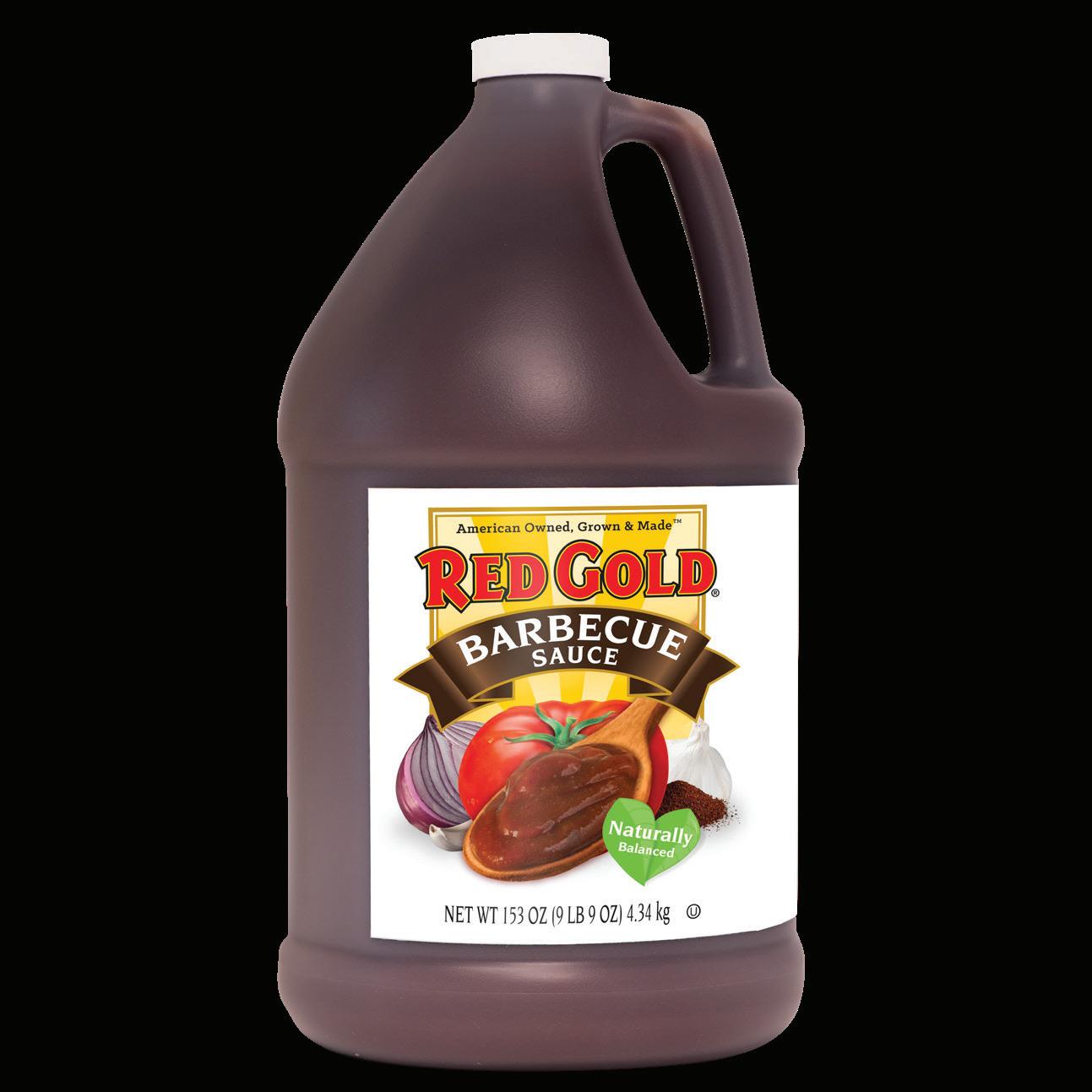

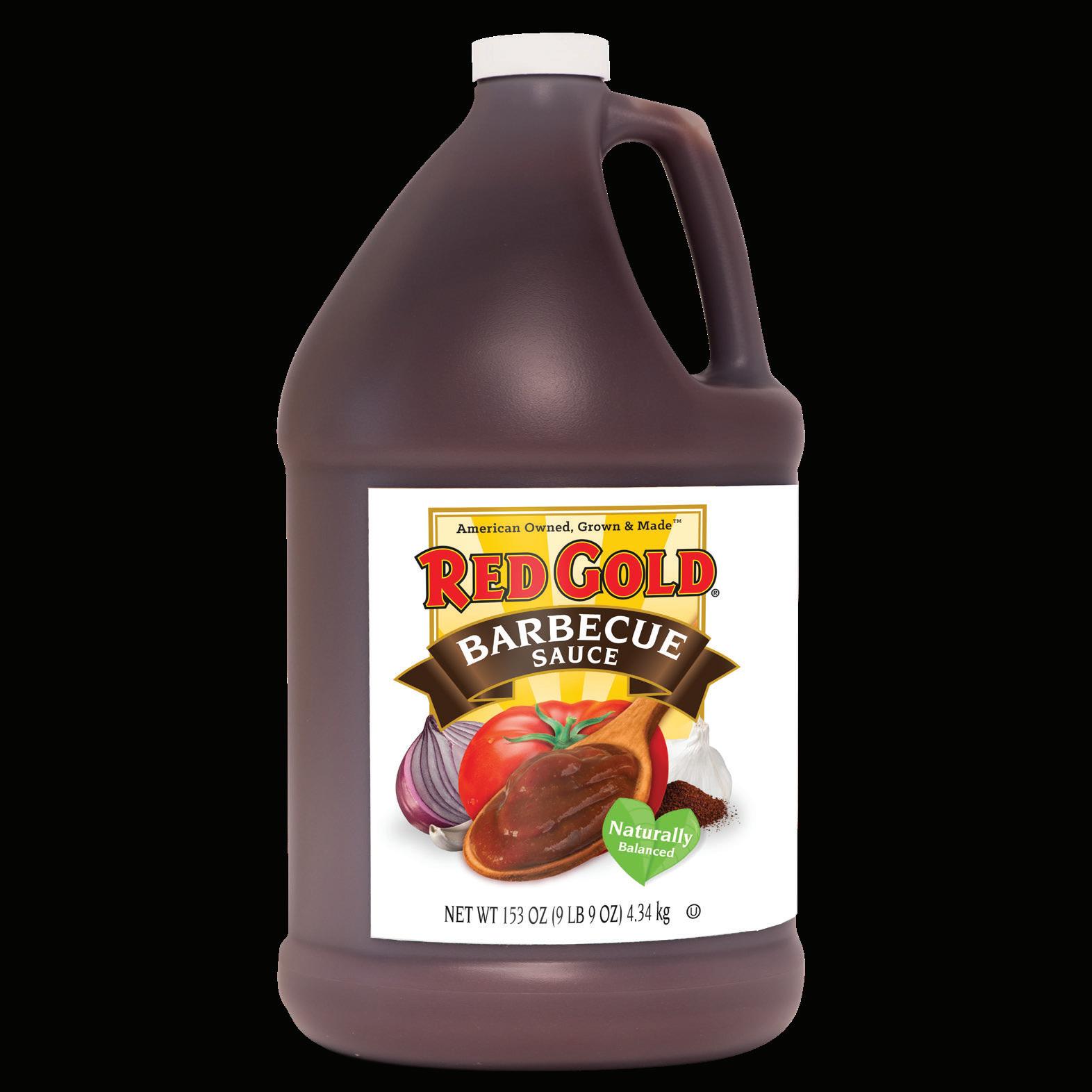



everything in house, scratch sauces— you can buy a lot of stuff pre-made and pre-bottled,” he adds. “We try to give guests an experience of flavors that are familiar, but a little different. I think obviously the freshness of the fish is huge also … it’s familiar dishes, but with just a little edge to them, just to make you want to come back.”
Cassidy honed his skills in traditional Japanese sushi-making techniques while training under renowned sushi chef Paul Johnson at the now-closed Sushi on The Rock in La Jolla, California. “He kind
I’d say in Asian countries, being a chef was kind of like a peasant form of working,” he says. “So I think the culinary

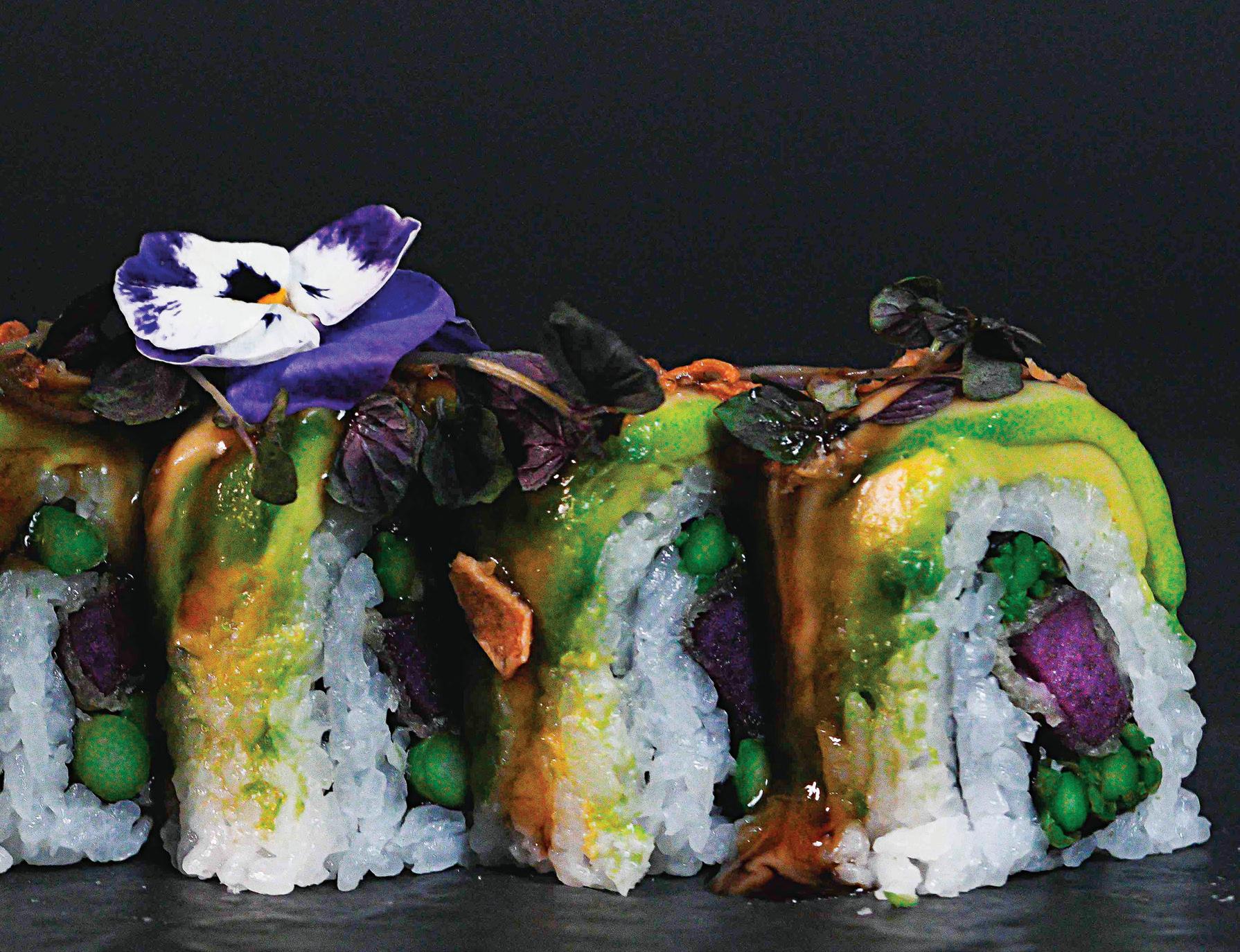
of sculpted me—having the everyday nuances of what it takes and what you’re supposed to be doing,” Cassidy recalls. Johnson taught him “respect for the food, respect for the people you work with; communication is huge.”
From there, Cassidy’s culinary journey took him to San Diego’s Lumi, a Peruvian-Japanese restaurant owned by Michelin-starred chef Akira Back, where he was exposed to the vibrant flavors and global influences that have become a hallmark of his cooking style.
As much success as he has had so far, Cassidy’s career path was not a linear one. “Growing up, a chef was really never a thing that I focused on, or even thought I was going to do; 25 years ago
school instead of being a lawyer. It was a very trendy, cool thing to do.”
“I feel like it’s mellowed out a little bit over the last maybe 10 years, but I do think that people are going into the food business a little more seriously as a form of profession … it’s looked at more as an honorable position working as a chef,” he continues. “When I first started, my mom said, ‘Are you sure you want to do this?’ Because it’s long hours, and I didn’t really know what I was getting into, but I wouldn’t take it back. I love that I’m here and I love what I do every day. And I feel like if you love what you do more than half the time, then you’ve found the right place.”
Cesar Vallin first opened Cloak &
Petal in 2018, and just a couple years ago dreamt of transforming the previ ously unused space in the back room behind the 7,500-square-foot main restaurant area into Shibuya Nights in 2022. Cassidy took the helm as executive chef the following year. “The San Diego food scene, definitely in the last 10 years, has really blossomed,” Cassidy says. “We kind of put our foot on this area with something a little different that you can go to. I think we’ve been very fortunate to be successful, especially in a heavily populated Italian food area.”
Since Cloak & Petal is one of the only sushi restaurants in Little Italy, it’s easy to stand out—but that doesn’t mean they sit back and rest on their laurels. Quarterly menu changes keep things fresh and interesting, plus smaller spe cials for holidays. “I think when you go out to eat, if you’re going to spend money, you want to have a good experience, and you want to walk away from that experi ence saying, ‘that was worth it. I would want to come back there,’” Cassidy notes. “Also, we do run specials to try to incor porate to see if things work, if people like the dishes. And also, too, as a train ing method for the servers and the staff to actually have a visual and also taste.”
Part of Cassidy’s passion lies in build ing a supportive kitchen culture and nur turing the next generation of culinary talent. As a mentor to many young chefs, he emphasizes the importance of keep ing your head down, learning as much as possible, and not being afraid to ask ques tions. “I tell them, if you stop doing this today, would you miss it? And if they say yeah, then that’s your answer,” he says.
Cassidy has built a team that oper ates like a well-oiled machine, with open communication and a shared sense of purpose who help each other out. “Not everyone’s going to be at 100 percent every day, including myself,” he explains. “If you’re able to have respect for the per son next to you and lean on them when you need to, they’ll do it back for you.”
“For myself for the last two years I’ve been here, I’ve evolved and learned a lot and grown a lot as a person,” Cassidy adds.


83% of consumers consider desserts made with Ghirardelli a special treat.* Make stunning and satisfying creations without the hassle of tempering. Ghirardelli Premium Dark Coating Wafers and White Coating Wafers are now available in 5-lb bags.
ghirardelli.com/professional
BY SATYNE DONER
Restaurateurs Tara Gilbert and Antonio Brown are changing the landscape of Atlanta’s vegan scene by championing bold flavors, unique textures, and unexpected fusions.
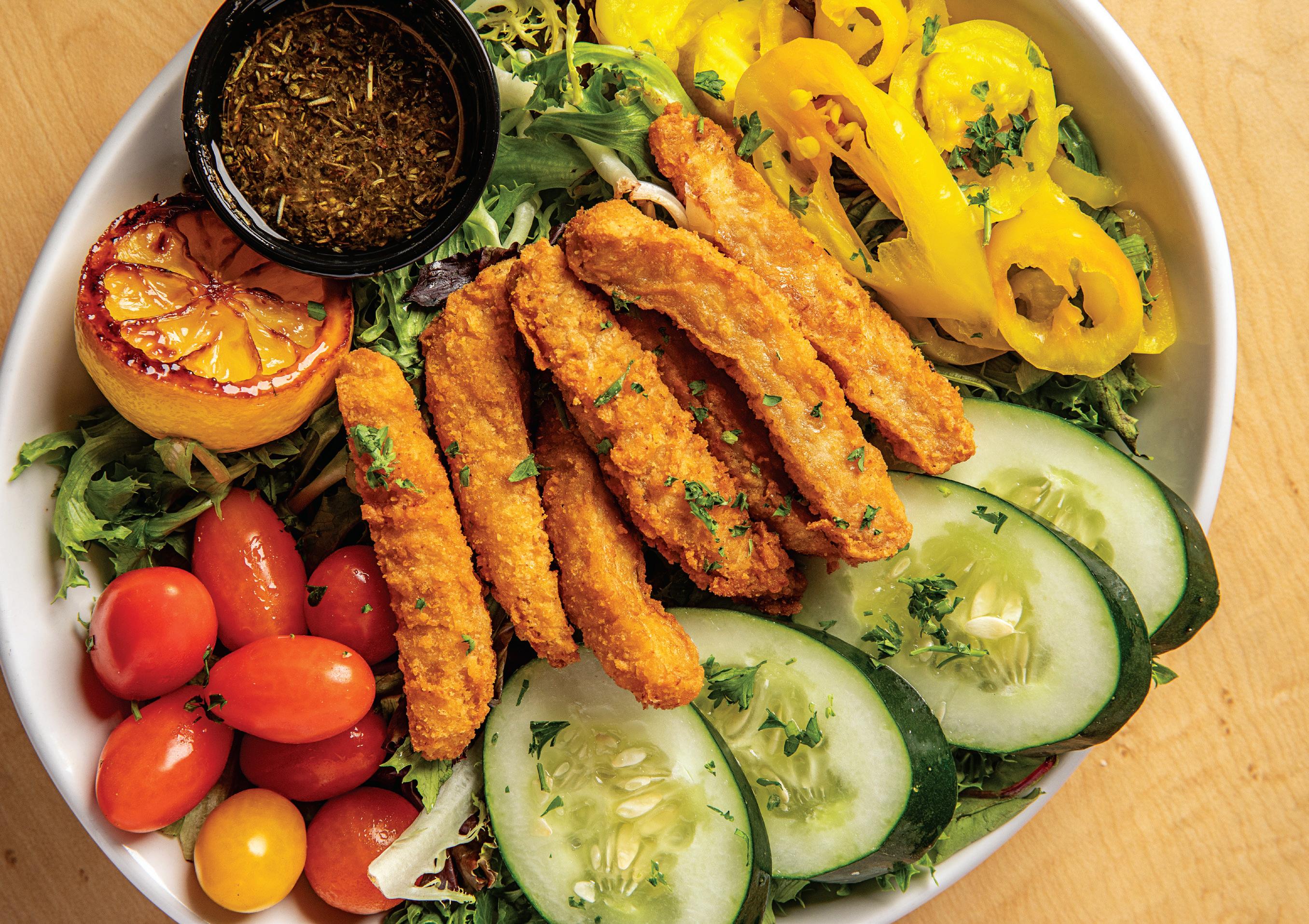
TARA GILBERT’S JOURNEY with veganism started as a health recommendation from an oncologist during her battle with cancer. After three years of finding suitable substitutions for the foods she had the hardest time replacing, she eventually went to culinary school and learned how to recreate them.
She opened The Boujee Southerner in Atlanta at the tail end of 2022 with a plant-based menu of Southern comfort foods. Gilbert understood the deep-
rooted connections between food and culture in the South—but she also knew these eating habits no longer reflected the conditions necessary for the healthy lifestyle many have sought to achieve post-pandemic. “I created a menu and an atmosphere that would pay respect to the past, the food we ate as a part of our culture and survival,” Gilbert says. “We’ll introduce customers to new ways of enjoying the same favorites. Veganism is colorful, it’s flavorful, and enticing.”
Gilbert’s menu, while entirely vegan, incorporates the tastes and textures of traditional soul food; She smokes her seasonings, allowing the collard greens to absorb the smoky flavor traditionally found in meat. She adds dashes of pickled red onions and peppers to incorporate a pop of color and uses olive oil as a healthy fat substitute.
In August, Pinky Cole Hayes, the famed restaurateur behind the popular plant-based restaurants Slutty Vegan and
Bar Vegan, took over The Boujee Southerner and converted it into a second Bar Vegan location in Atlanta. But Gilbert’s cooking was so good that Cole brought her onto the team as an executive chef.
The new Bar Vegan menu is spearheaded by Gilbert, with all the markings of her specific style: maple-glazed Brussels sprouts, street corn ribs, jerk kabobs with grilled oyster mushrooms and sweet pineapple chunks, and Lemon Pepper Chick’n Salad, made from lemonpepper-seasoned plant-based chicken, spring mix salad, tomatoes, cucumbers, and a variety of peppers.
“People want to live longer, simple as that. They want to look and feel better. America is last on the ship for veganism,” Gilbert adds. “A lot of people don’t fully grasp veganism, but as the demand for it rises, we’ll continue to educate them. I love to have vegan conversations… if I could be the Sam’s Club of vegan food, handing out samples, I would.”
Gilbert’s curated Southern-style vegan menu is now available at both of Cole’s Bar Vegan locations in Atlanta as well as the newly opened Maryland restaurant. She continues to advocate for the evolution of vegan food, pushing for the development of this hyper-specific sector.
Fellow Atlanta-based entrepreneur Antonio Brown takes his vegan menu a step further, specializing in both vegan and gluten-free options. After a neardeath experience in 2016, he discovered he was allergic to gluten and was dissatisfied with the lack of options suitable to his diet. One of the only things he could find was stir fry—an Asianinspired dish—and this inspired him to bring the first vegan and gluten-free stir fry concept to Atlanta in May 2024, called Stir House.
“I wanted to provide an opportunity for folks to not allow their allergies to keep them from enjoying what they eat,” Brown says. “I didn’t know what it meant to be gluten-free, and I was very uneducated. But the consciousness is elevating around vegan and gluten-free options, and I created Stir House as both a solution and a brand that provides education around what customers are consuming

and how it will affect their bodies.”
Using a traditional wok-style cooking technique that creates a seared taste and direct farm-to-restaurant ingredients, Brown is very intentional about his menu providing flavor and texture for customers. At Stir House, guests can build a stir fry box with a base of quinoa, noodle, or rice; vegan meat substitutes (like spicy Beyond Sausage or “shrimp” made from konjac root); and toppings of colorful vegetables. Appetizers include the Buddha Cucumber Salad, fried tempura vegetables, fried oyster mushrooms with smoked paprika, and Southernfried soy chicken.
Brown and Gilbert both agree that a common misconception around vegan food is that it’s healthy by default, but that isn’t always the case. Staying true to his mission to bring healthy and sustainable food to guests, Brown takes his menu items a step further, using ingredients like sunflower seed oil and chickpea flour batter to help support the digestive system. All of Stir House’s signature sauces are made from scratch in-house, and Brown says these are a valuable piece of the brand’s success. The Khan, his number-one seller, has a savory Mon-
golian sauce that keeps customers coming back for more.
“I curated the menu myself based on my own experience going through being vegan and gluten-free, and I was very intentional about creating options that would appeal to different customer bases,” Brown says. “We’ve proven that vegan food can be full of seasoning, with an incredible palette of flavors people enjoy. Even skeptics are unexpectedly falling in love with what we’re offering.”
With under a year of running Stir House under his belt, Brown is looking to hone in on his first location before potentially opening another in Atlanta. His ultimate goal is to bring his concept nationwide as consumer preferences skew towards the health-conscious.
“Vegan and gluten-free is going to be the future, and more people are going to move towards plant-based brands,” Brown adds. “People want to understand what they’re putting in their bodies and how it affects their digestive system. As a society, we’re much more aware of what we’re consuming, and based on the pattern of what’s happening in this space, I think you’re going to see major brands starting to pivot.”



MENTIONED IN THIS STORY BAR LOUIE • EASTERN STANDARD • COJE • PARKS HOSPITALITY • SPIRITS IN MOTION

BY SAM DANLEY
Industry experts sound off on trends, challenges, and opportunities for the world of beverage.
DO PREMIUM COCKTAILS face an uphill battle as inflation puts a squeeze on consumer spending?
A group of beverage experts tackled that question and more at FSR ’s NextGen Restaurant Summit ear-
BALANCING YOUR BEVERAGE MENU WITH HIGHER-MARGIN “WORKHORSE” OPTIONS IS KEY TO OFFSETTING HIGHER INPUT COSTS OF MORE PREMIUM DRINKS, ACCORDING TO PHILIP BOLLHOEFER OF PARKS HOSPITALITY GROUP.
lier this fall in Atlanta. They weighed in on how to make cocktails worth the price—either by enhancing their appeal to justify the cost or by finding ways to make them more affordable. “We are in the experience business,
so I’m a big fan of showmanship—the delivery and presentation and really bringing that wow factor,” said Tony Pereyra, owner of The Spirits in Motion, a bar and beverage consultancy. He highlighted trend-forward techniques like fat washing, foams, and layered drinks as ways to elevate a beverage menu. He also pointed to tableside presentations as an effective method for leveling up the guest experience.
“I think that’s huge, and it’s really on a swing back,” Pereyra said. “Being part of the experience business, you should constantly be looking for ways to bring that ‘aha moment’ to the beverage.”
Ian Welby, vice president of beverage and execution at 65-unit neighborhood gastrobar chain Bar Louie, said he’s been leaning deeper into premium spirits. “I think the perceived value is in the product you’re presenting and the experience you’re providing, versus the dollar amount, or the discount, or whatever promotion you’re running,” he said. “Can your margin be larger if you aren’t using a premium tequila? Sure, but the guest also recognizes that.”
When Bar Louie swapped out the vodka in its dirty martini for a higherquality option last year, it brought about a nearly 30 percent increase in sales, with no change to the price, he added.
“If you’re going to come in and pay $13, $14, or $15 for a cocktail, I want to make sure it’s worth it for you,” Welby said. “We want to make sure that the guest knows what they’re getting and that we’re also getting credit for the effort that we’re putting in.”
Being thoughtful about the brands you work with can also add value, according to Jackson Cannon, beverage director at Eastern Standard Hospitality in Boston. “When I use a name brand that I believe in, I can charge a little bit more, and my percentage might suffer, but my cash in hand goes up,” he said. Leveraging those brands helps tell a story, he continued—a key part of marketing a beverage program across bar interactions, social media, and the menu.
“The bigger brands can be great partners in that endeavor of telling the story,
which creates the prestige and allows for that sticker shock to wear off,” Cannon said. “You can still find value in this world where things have skewed up. Sometimes that means going for something more valuable than just trying to strike the lowest price point.”
Philip Bollhoefer, vice president of food and beverage at Parks Hospitality Group, noted that balancing the menu with higher-margin “workhorse” options is key to offsetting the higher input costs of more premium drinks.
“Any kind of house cocktail that’s

going to be at the lower end of your price point is going to satisfy that budget-conscious guest, and it’s going to be a workhorse,” he said. “When you’re selling that $17 old fashioned that you’re running 26 percent beverage cost on, your 18 percent workhorse is really helping to supplement that.”
The panelists also shared strategies for enhancing sustainability, with Bollhoefer offering some easy but impactful examples of ways to upcycle ingredients. “When I talk about sustainability, I like to mirror that with profitability,” he said. “The first thing you should do is go around and look at the trash can to find something that the bar uses and throws away.”
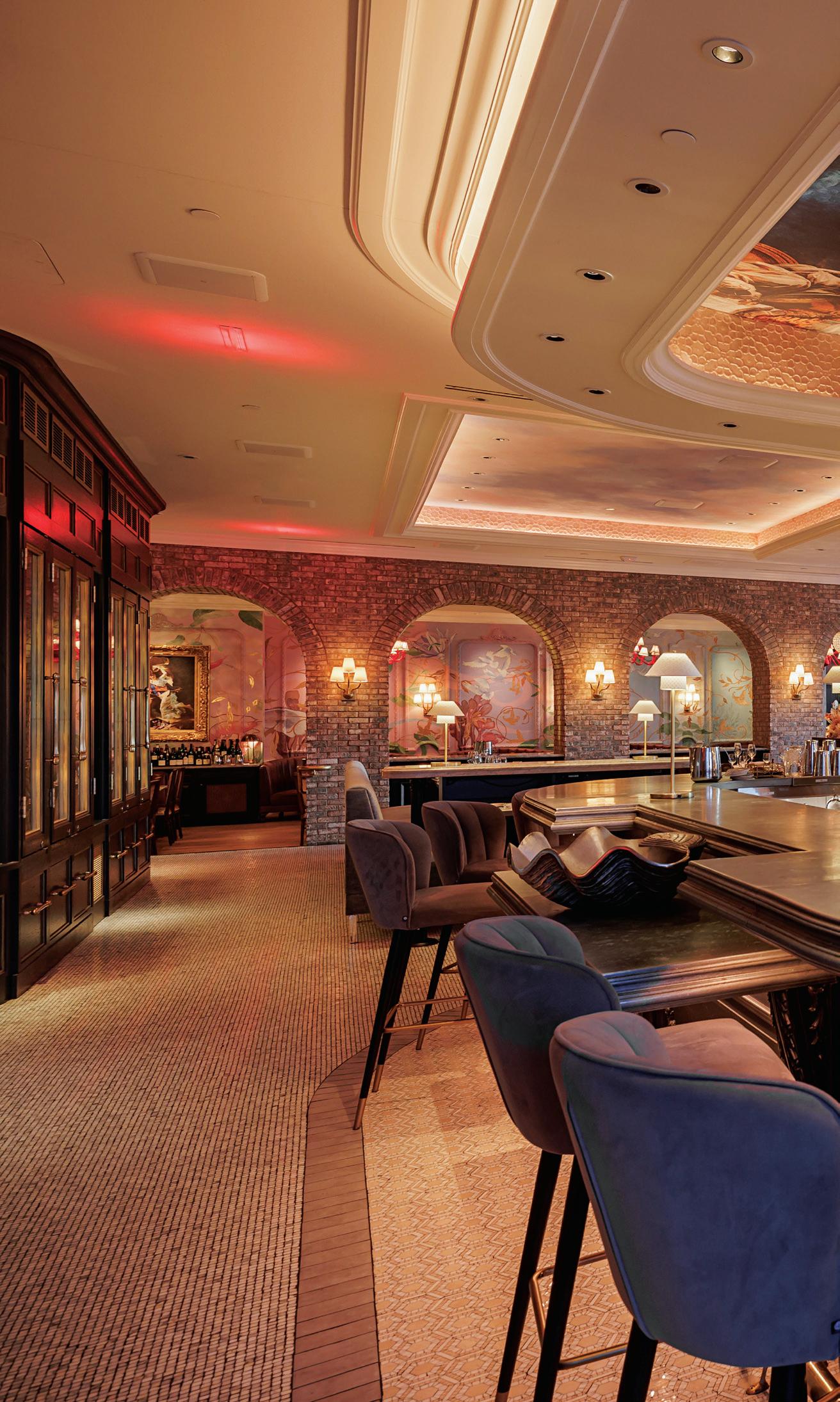
“Once you start that communication and start asking them what they have back there, it creates a lot more cohesiveness. Now, your chefs and your bar teams are utilizing the same ingredients and finding ways to keep stretching them out together.”
Bollhoefer highlighted how his team is putting that mindset into practice at their new Italian concept by repurposing fruit scraps. “We have a cello flight out of Everclear—a very inexpensive alcohol ingredient to purchase—but we’re infusing it with something that would’ve been going into the trash,” he said. “We have a product that people are willing to pay quite a bit for because it’s a homemade limoncello. It’s great because it keeps stuff out of the landfill, but also because it keeps money within our operation.”
His favorite ingredient to upcycle? Bacon fat. “People love a bacon old fashioned. Do a fat wash on your bourbon and put it in the freezer,” Bollhoefer said. “We go one step further with a bourboninfused clarified butter that then goes into our french toast for brunch. There

are quite a few different ways that you can take different ingredients, talk about sustainability, and put more money down to the bottom line.”
Upcycling discarded ingredients also sparks creativity and boosts employee engagement, added Ray Tremblay, corporate beverage director at COJE Man-

agement Group. It provides the bar team with a new challenge and fosters cooperation with kitchen staff, making the work environment more dynamic and collaborative.
“Working with the kitchen is huge, because I think we all know about the battle between back-of-house and frontof-house,” he said. “Once you start that communication and start asking them what they have back there, it creates a lot more cohesiveness. Now, your chefs and your bar teams are utilizing the same ingredients and finding ways to keep stretching them out together.”
As bar and beverage programs adapt to evolving consumer tastes, panelists emphasized the need to equip staff to deliver great guest experiences. It all starts with hiring the right people. “A mixologist needs to be somebody who can be more than just an order taker,” Welby said. “There’s sort of an art to it. You have to be a conversationalist and you have to be talented.”
From there, the experts stressed the importance of giving employees a reason to stay. Bartenders want to feel proud of the drinks they serve, and that comes from well-thought-out, practical training plans that can be put into action.
“Systems are scalable. One good bartender or one good restaurant manager is not,” Bollhoefer said. “So, you have to build out a solid base-level system.”
When it comes to keeping staff motivated, Welby recommended taking a bottom-up rather than top-down approach. “It’s easy for me to put a message out to the other VPs, the directors, and the operations team, but by the time it gets to the bartenders and servers, it’s going to be a completely different message, or at least not as impactful,” he said. “So, I’ll speak directly to hourly employees and motivate them from there.”
Encouraging ongoing improvement, recognizing team members’ skills, and fostering collaboration are all important keys to keeping employees engaged. Bar Louie checks those boxes through initiatives like its national bartender competition. “The more you’re able to do fun stuff like that, the more the team members will be brought in and excited about going to work, and then hopefully tell their friends how awesome it is to work at whatever your company is, and now you’re attracting even better talent,” Welby said.
Cannon echoed that sentiment, urging beverage leaders to move beyond cookie-cutter training programs and focus on “deep education” as both a competitive advantage and long-term investment. Giving rank-and-file bartenders the chance to attend competitions, branded trips, and other in-person industry events is one way to accomplish that.
“Just like everything in life, it’s networking and bonding and creating that foundation, and then giving them the chance to really bring that knowledge back into the workplace with them,” Cannon said. “Then as people learn, they become teachers. It has to be a collaborative process that allows them to grow and track towards leadership. That’s a huge part of how to keep people motivated.”
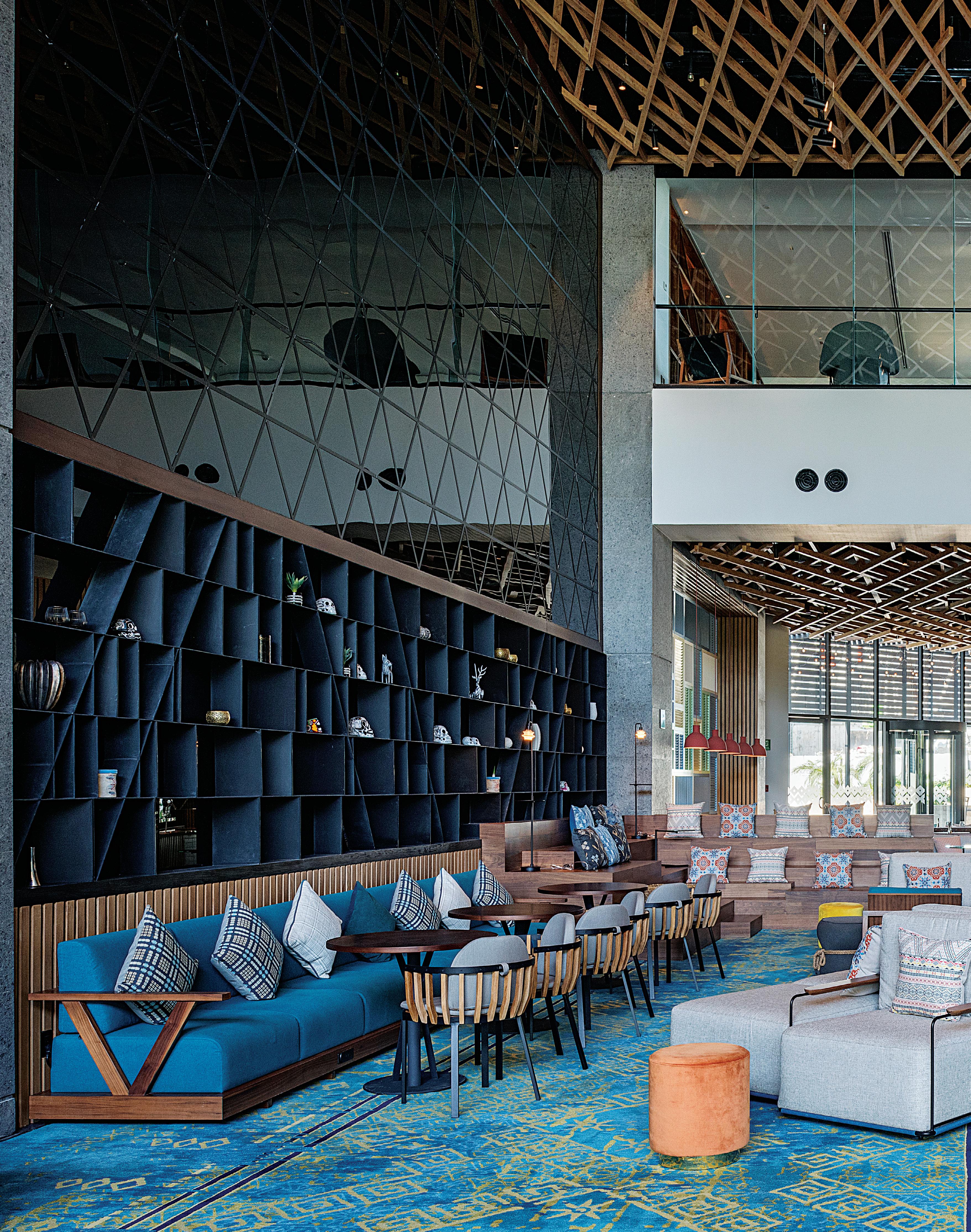
BY CALLIE EVERGREEN
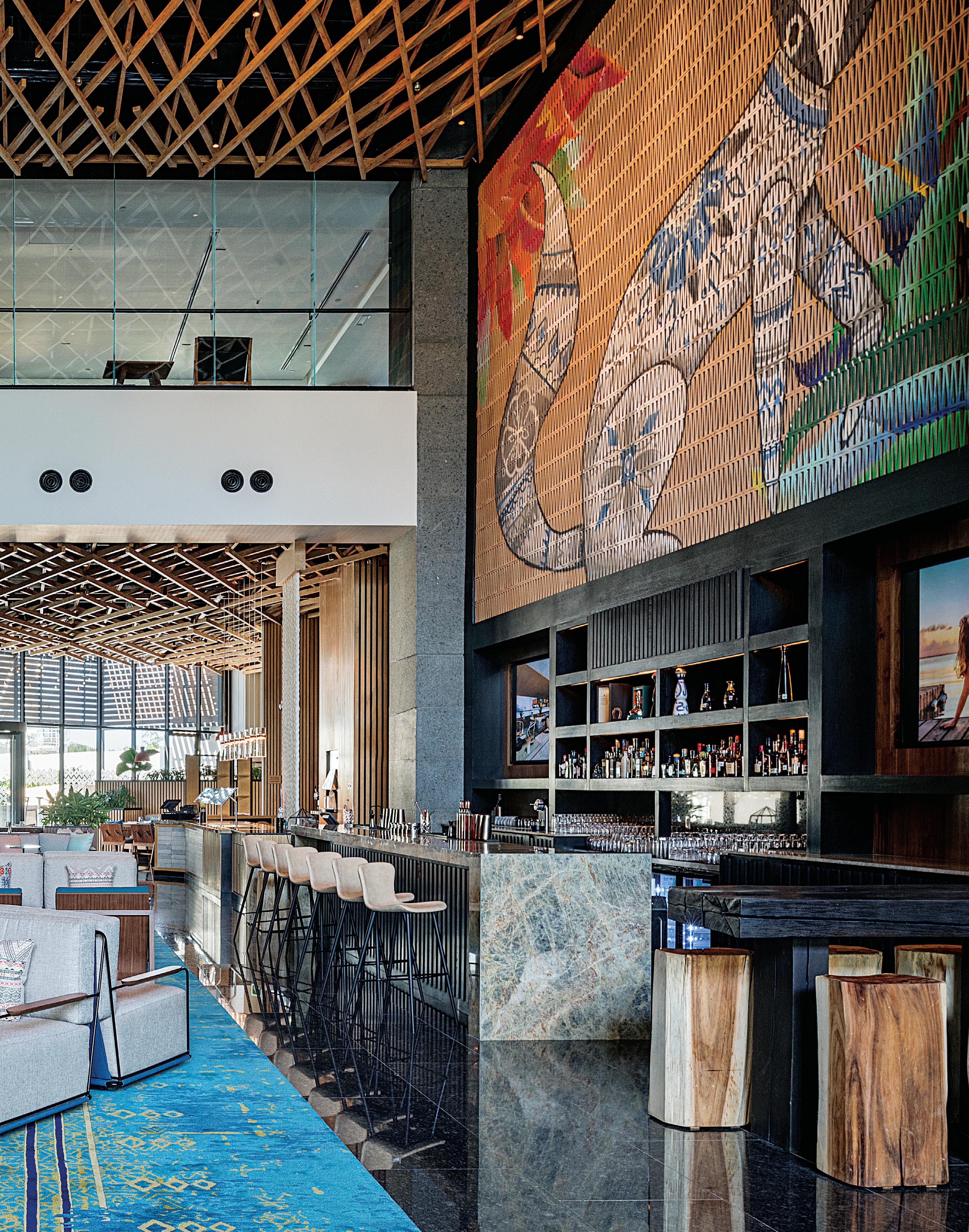
From operational challenges and writing an appealing menu to managing people and enhancing the guest experience, hotel restaurant chefs share their insights and best practices on navigating the unique hospitality environment A
the true measure of success is not about getting awards and accolades, or even creating a personal legacy; rather, it’s about creating an environment where he and his team can find contentment and fulfillment in their work. He’s the founder and chef-partner at Perfectly Ad Hoc Hospitality Group, and opened Golden Hour, a wood-fired chophouse restaurant, a 125-person capacity rooftop bar, and a cafe and bar called Afterglow inside boutique hotel The Radical in Asheville, North Carolina, last October.

Housed in a once-abandoned 1920’s warehouse that was formerly a cereal factory, the hotel has 70 guest rooms. Running three in-house food and beverage concepts in a hotel means Sessoms is a pro at managing many moving parts. “To be on the ground day in and day out and make sure all those pieces fit together, it takes a lot of coordinating, just to make sure that the end result is going to look right, feel right, and work right,” he says. “It’s incredibly intriguing and fun. And just like any other parts of my career and my job, my vocation, it is very much a people process. It is very much about working with very different people, from interior designers in an office in Miami and New York, or the project coordinator with the general contractor who's on the ground with a hammer.”
Opening that level of a dynamic project was a new experience for Sessoms. Previously, he had opened the iconic Asheville restaurant Table in 2005. He compares opening a singleunit restaurant versus what he’s doing at The Radical to “giving birth to one child versus giving birth to triplets. There’s a lot of efficiency in the model of having multiple children at the same time … But the headaches are pretty big.”
From a forward-facing standpoint, Sessoms and his team operate three different concepts, but on the backend, they run the hotel’s food and beverage as one operation, managing orders, inventory, cost and labor analysis, and training managers with the collective power of the whole. “To some degree, it’s the same as being a chef on a line. It’s the same as running a restaurant all day long. You have 90 things you have to do in order to unlock the door at 8 a.m. and have dinner served on the table for 200 guests throughout the course of your evening service,” he says. “That’s just the nature of work, but it’s not really different than having multiple things going on at the same time in any other business. I think you’re either good at
structuring how you think about things or structuring your day, or you’re not.”
When he was younger, Sessoms’ approach was to do as much as he possibly could all the time, as quickly as possible—but that inevitably leads to burnout at some point. Now, at 48 years old, he’s learned that his productivity and ability to work towards profitability is much greater if he slows down and is more intentional about each task, whether that’s managing owners and investors or marketing. “If I slow down and I act with intention, and I keep all that organized in my brain, I’m much better at it. Maybe lots of years of yoga helps, too,” he adds.
At Golden Hour, guests enjoy locally sourced, seasonally inspired plates inspired by Sessoms’ long-standing relationships with area farmers, creameries, and butchers. The beverage program serves craft cocktails with a twist alongside a wine list with around 100 bottles, many of which are from natural, organic, and Biodynamic producers.
While he still relishes the creative process of menu development, he now focuses more on the big-picture operations, staffing, finances, and management. "I am not so much a chef anymore in my career. I am a start-to-finish turnkey restaurateur," Sessoms explains. A key lesson Sessoms has learned is the importance of balancing culinary ambition with business acumen. While he and his Chef de Cuisine Kevin Chrisman are dedicated to serving innovative dishes, they also must cater to the oftentimes more mainstream preferences of hotel guests.
Sessoms spends a lot of time talking and strategizing with Chrisman about what works for The Radical’s customers, and how they can acquire more guests while still serving “some of the coolest food in town,” he says, emphasizing that a dual focus on both creative expression and commercial viability is crucial for any chef looking to
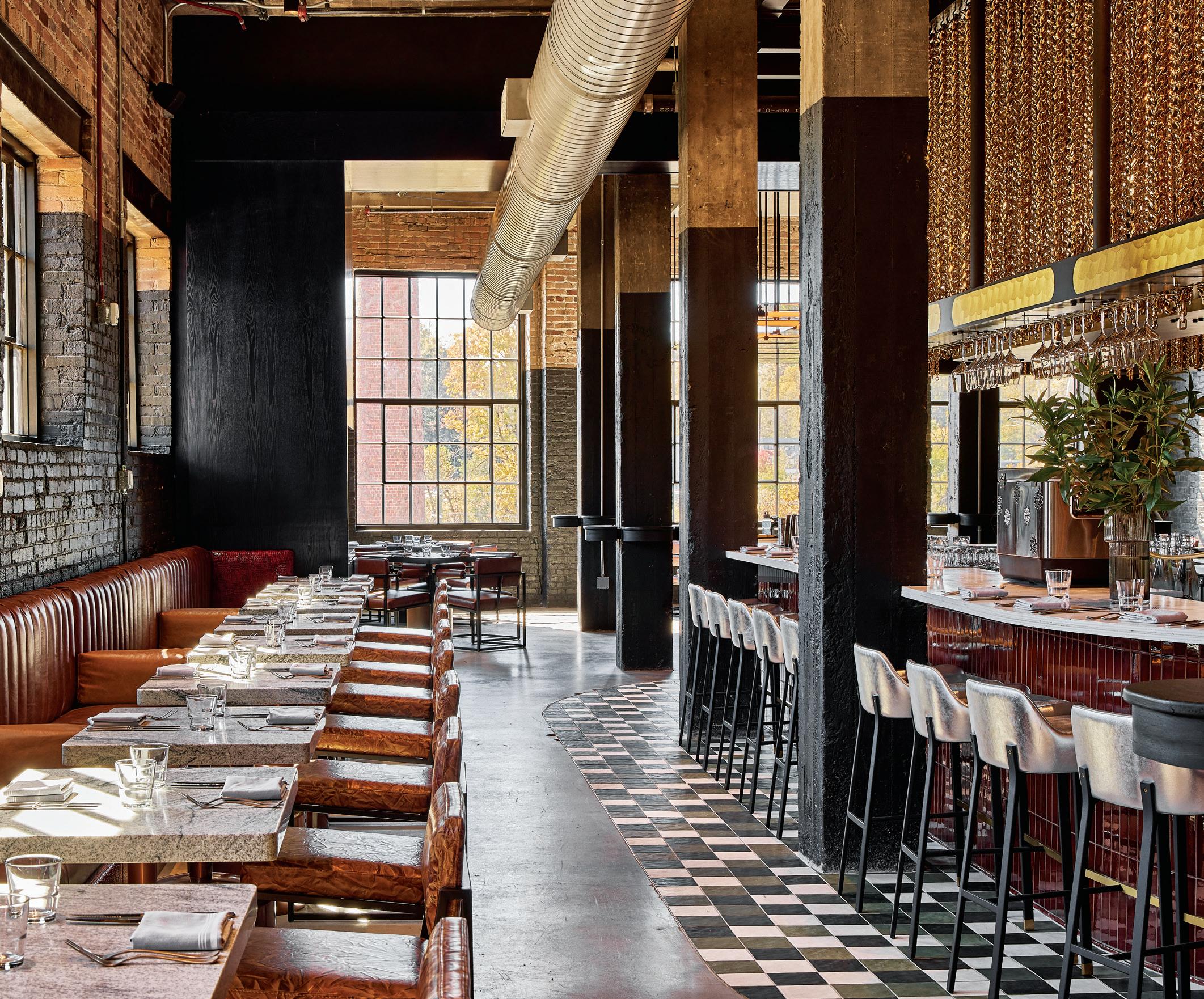
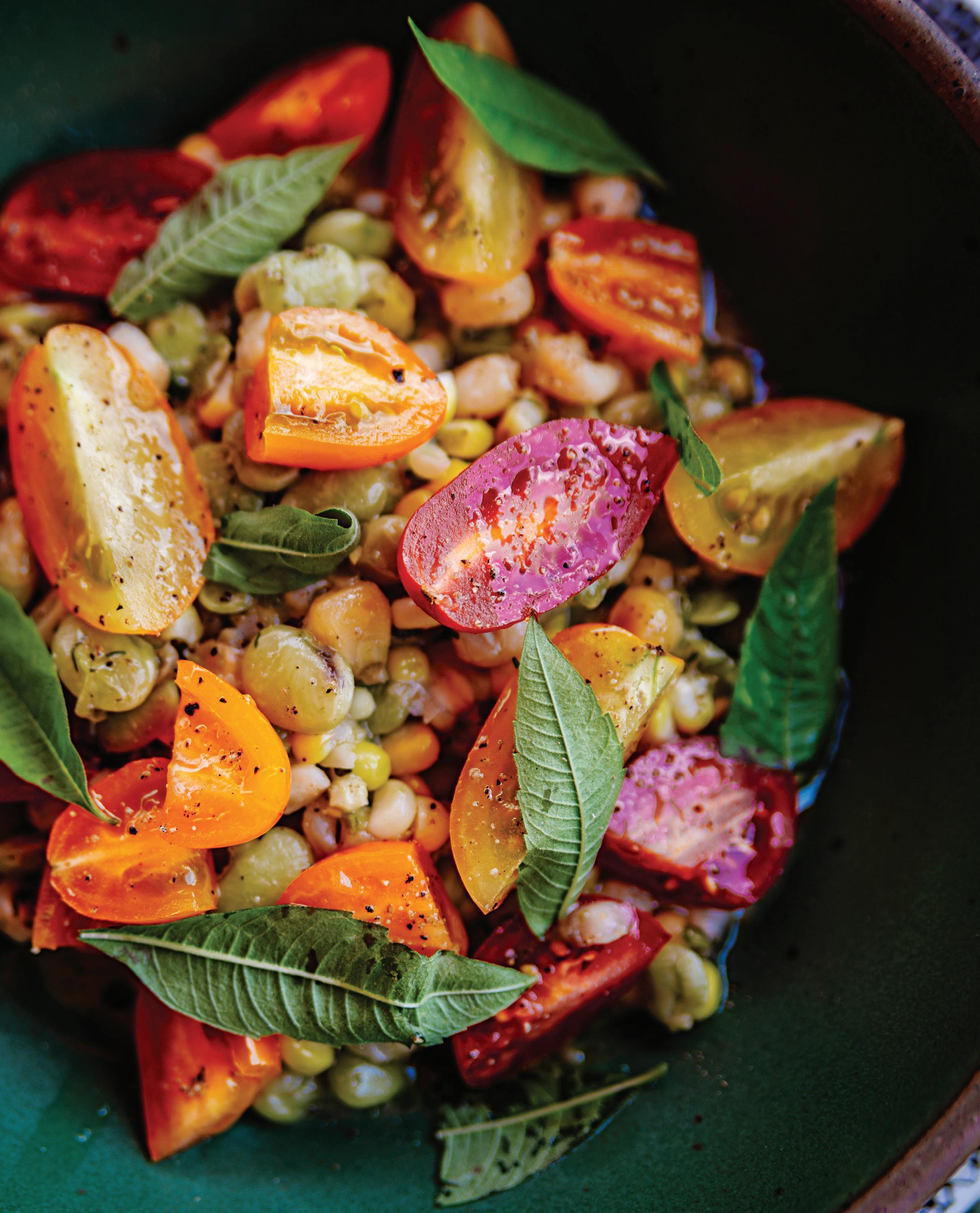
AT ASHEVILLE’S GOLDEN HOUR—HOUSED INSIDE BOUTIQUE HOTEL THE RADICAL—JACOB SESSOMS AND HIS TEAM FOCUS ON CRAFTING A MENU WITH SIMPLE YET CREATIVE OFFERINGS THAT CATER TO BOTH ADVENTUROUS EATERS AND THOSE SEEKING FAMILIAR FLAVORS.
succeed in a hotel setting. "To me, you can't have one without the other. I don't want to open a restaurant or any food service business that I am not proud of the product we're serving. If I'm not proud of the wine list or the cocktail list in a bar, I shouldn't be doing it. If I’m not proud of the menu, if I don’t think the food is good and fun and current, I shouldn’t be doing it.”
So, how do you balance making approachable food to keep a hotel guest that may not be feeling as adventurous, while simultaneously keeping the local foodies from going down the street to their competitors? To a degree, it has to do with how you actually write the menu and communicate with the guest about your dishes, Sessoms notes, “because different words for the same thing can have a very different effect on sales.”
Golden Hour’s menu uses straightfor ward language to communicate dishes, from a pork chop with cauliflower and salsa verde to a whole Sunburst trout with a market greed salad and trout caviar buttermilk. Slow cooked lamb comes with Farm & Sparrow grains and peas 'country captain,' while woodgrilled small plates keep it simple with fall broccolis with cheddar and winter squashes with vegetable salsa. Foodies can go for the wood roasted bone mar row with herb salad and Parker House rolls, and for traditionalists looking for a twist, there’s “A Play on Caesar” salad with greens, vegetables, trout caviar, and Pappy's cornbread.
“We can make exactly the same dishes and we can sell 100 of them in a week, or we can sell five, depending on how we word it,” he explains. “Espe cially the young chef, there’s always a desire to look cool or to look in the know, but writing words on a menu that nobody knows isn’t going to sell food. It’s also not going to get you a James Beard Award. It used to maybe, but it’s not now, and it’s something that I spent years in my career doing. Like, ‘let me see if I can write the most esoteric thing on the menu possible.’ And it’s just kind of immature in a lot of ways.”
Ember Steak’s Executive Chef Cary
“There is no such thing as a perfect menu; no single menu will satisfy the masses adequately. The trick is to learn to accept that and remain flexible with individual wants and needs, especially in a hotel setting.”


CHEF CARY ROY (RIGHT) EMPHASIZES THE IMPORTANCE OF STORYTELLING THROUGH FOOD AT EMBER STEAK, A FINE-DINING CONCEPT AT THE MERITAGE RESORT AND SPA IN NAPA VALLEY. HE AIMS TO BUILD A SOLID IDENTITY FOR THE RESTAURANT THAT LOCALS AND VISITORS WILL TREAT AS “DESTINATION DINING” THAT CAN STAND APART FROM THE HOTEL.
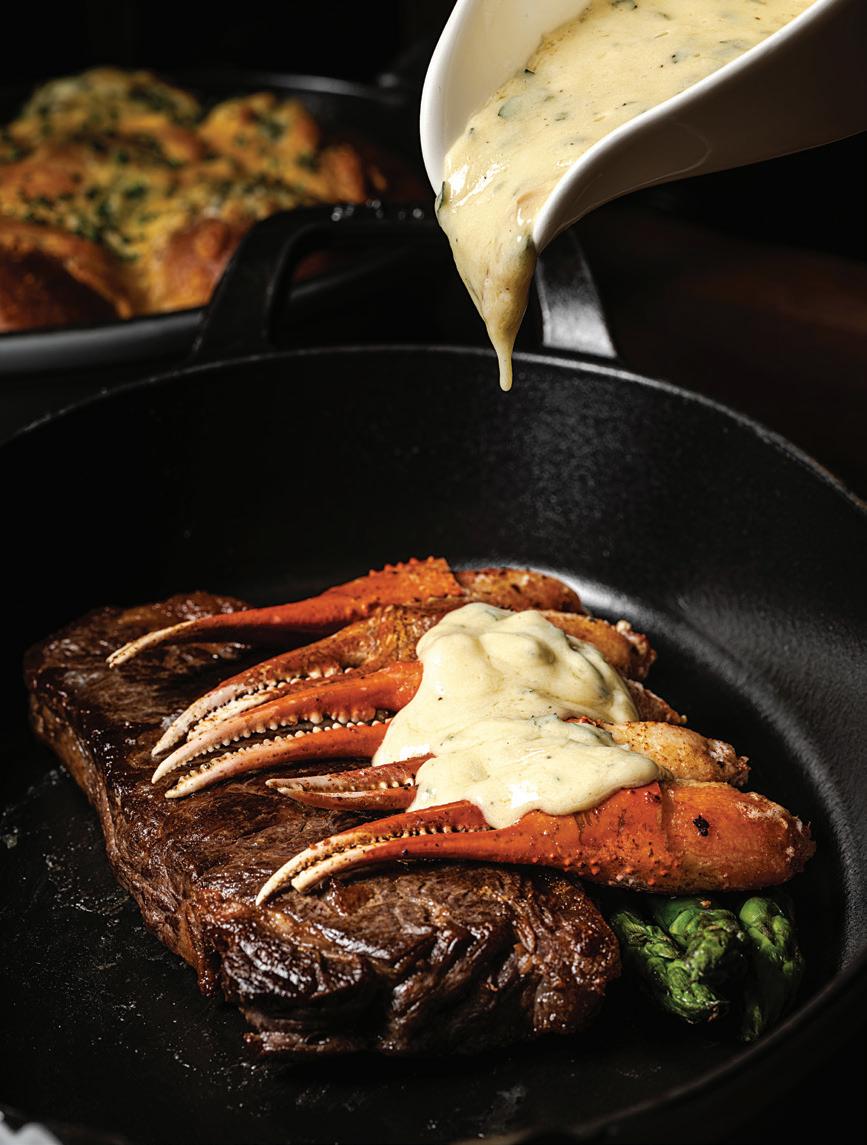
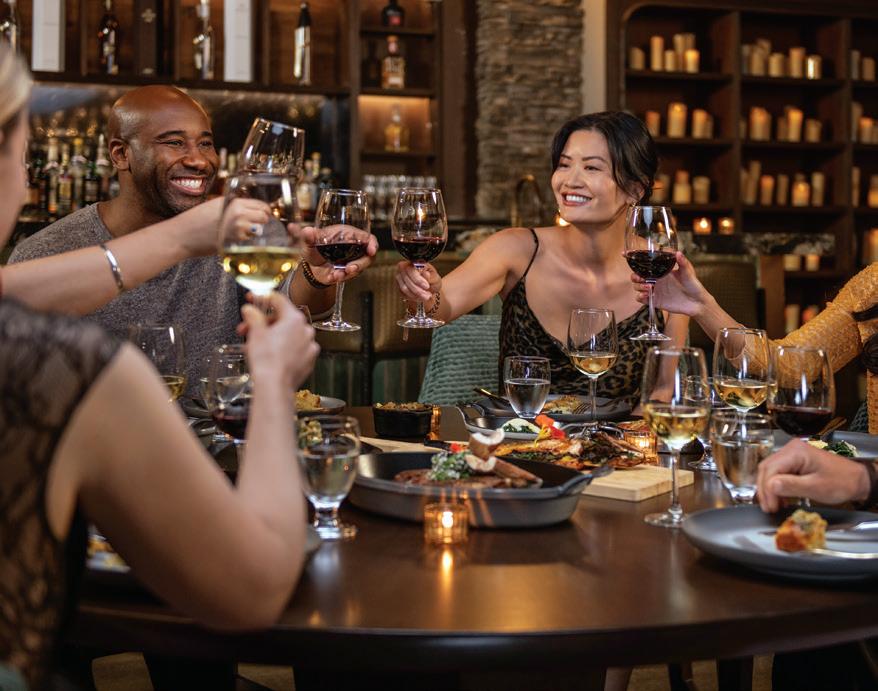


Roy notes, “There is no such thing as a perfect menu; no single menu will satisfy the masses adequately. The trick is to learn to accept that and remain flexible with individual wants and needs, especially in a hotel setting.” Ember Steak is the newest fine-dining concept at The Meritage Resort and Spa in Napa Valley, California. "As basic as it sounds, our shrimp cocktail is a favorite among guests and diners,” Roy adds. “We took a classic steakhouse staple and tried to reimagine it just enough to satisfy everyone. We kept the basic flavor components intact but changed the perception of what a shrimp cocktail can be by altering the textures and sensory stimulation of the dish."
Roy adds, “Little by little, my outlook on the culinary world has changed over the years by adopting principles and ideologies from others who have found a better way to express and convey the idea of genuine hospitality.”
Ashley Cannon, executive pastry chef at Oak Steakhouse at Skyline Lodge in Highlands, North Carolina, echoes Sessoms’ call for simplicity when crafting menus, while still having fun with flavors and highlighting local producers.
“When I create this menu each season, along with looking at the savory components to follow, I think about how each dessert can be celebratory, casual, and simply executed,” she says.
“Each plate should be easy to comprehend, [and] flavors should be familiar or different enough to cause curiosity with familiar components. For example, on our current menu we have an Aperol Spritz sorbet served in a coupe glass with candied lemon peel and fresh basil. I would personally love this as a finish to my Bolognese entree and fresh bread rolls with whipped honey and rosemary butter.”
Tucked away in the mountains, Skyline Lodge offers 39 guest rooms and one suite, and is a renovated boutique property from the team at The Indigo Road Hospitality Group. Opened in July 2021, it marks Indigo Road’s first foray into the hotel industry with a full revitalization of the historic 1930s-era lodge. The
property describes itself as a playful tribute to a bygone era of motor court lodges and motels with mid-century modern design, with details that pay homage to the surrounding nature. Skyline Lodge’s second floor houses Oak Steakhouse, a contemporary steakhouse featuring cuts of Certified Angus Beef and locally sourced produce from area farms.
Opened as the one and only steakhouse in Highlands, Oak Steakhouse has become a go-to for both Skyline Lodge guests and Highlands-area visitors and locals. Personalizing the experience for hotel guests is a key focus, Cannon says, and her team starts taking notes on guest preferences from the moment they check in using OpenTable. Weekly meetings communicate any VIPs coming to the property, and brainstorming sessions on how to make their stay and dinner memorable. “Going the extra mile means a lot to our guests, and it just feels really good knowing you've made someone's day/weekend that much more special,” she says.
Cannon also highlights the role that careful design and offering personal touches can play in elevating the guest experience. “Skyline Lodge is a mid-century modern boutique hotel, and we are very proud of the intimate feel and look we've achieved,” she says. “Small details like wooden boards for bread service bring in the mountain and nature aesthetic. Mini cast irons for side dishes bring in the Southern cuisine feel. Warm fireplaces by the bar bring warmth and the feeling of being away in a cabin enjoying a hot toddy. Hues of teal, forest green, navy, and brass, fill the property with a mid-century modern vibe.”
“One of my personal favorites is the leather-bound menus and placemats for tables,” she continues. “The overall atmosphere is like mountain luxury. In our rooms, we gift housemade trail mix in a cute cup with a QR code that takes you to our activities list encouraging you to take your treat and enjoy a hike or waterfall.”
At Oak Steakhouse, Cannon tries to keep two desserts with tableside features on the menu to add excitement and entertainment for guests. A chocolate souffle is brought out standing tall and mighty and then cut a slit with a metal spoon and a cherry creme anglaise is poured on top. The Toasted almond and peach semifreddo is topped with marshmallows and gets torched tableside, which Cannon hopes encourages guests to have a nightcap out in the courtyard with s’mores by the firepit.
“I think in a standalone restaurant, the expectations are obviously food service-based. When you add a hotel to the mix, the level of hospitality that is expected is much higher,” Cannon says. “I've learned that if a guest has a problem in any area of the property, it may affect their stay overall. Going above and beyond is our goal; if your entree didn't come out like you wanted, we'll most likely comp it and might try to leave a little token in your room. If you're having problems in your room and you're dining, we might try to cheer you up with a charcuterie board or a dessert tray. The bar is set very high with expectations, and we intend to do everything to fulfill all needs.”
Going above and beyond for guests can also sometimes mean taking the time to visually show them something rather than verbalizing it. At Ember Steak, for example, Roy stumbled across some Japanese A-5 striploin and decided to run it as a simple special; nothing fancy, just in its natural form with a bit of sea salt. A guest in the dining room didn’t understand how the beef merited a substantially higher price tag in comparison to a prime-graded cut. “I had some unfabricated primal cuts of each and was able to show the guest a side-by-side comparison where they could see the difference in quality, marbling, diet, yield, etc,” he shares. “It's very simple to verbally explain but to truly understand, you need to touch, smell, and compare with your senses rather than taking someone else’s word for it.”
“People are beginning to care about
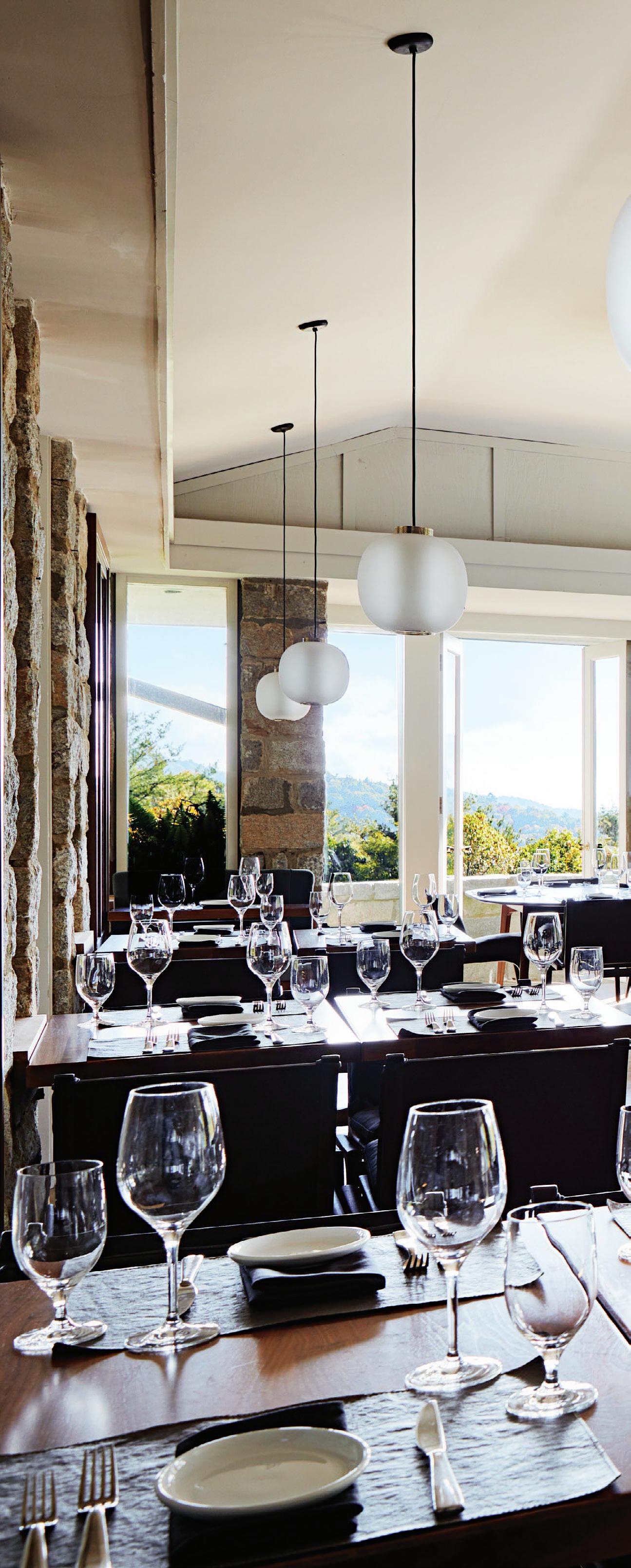


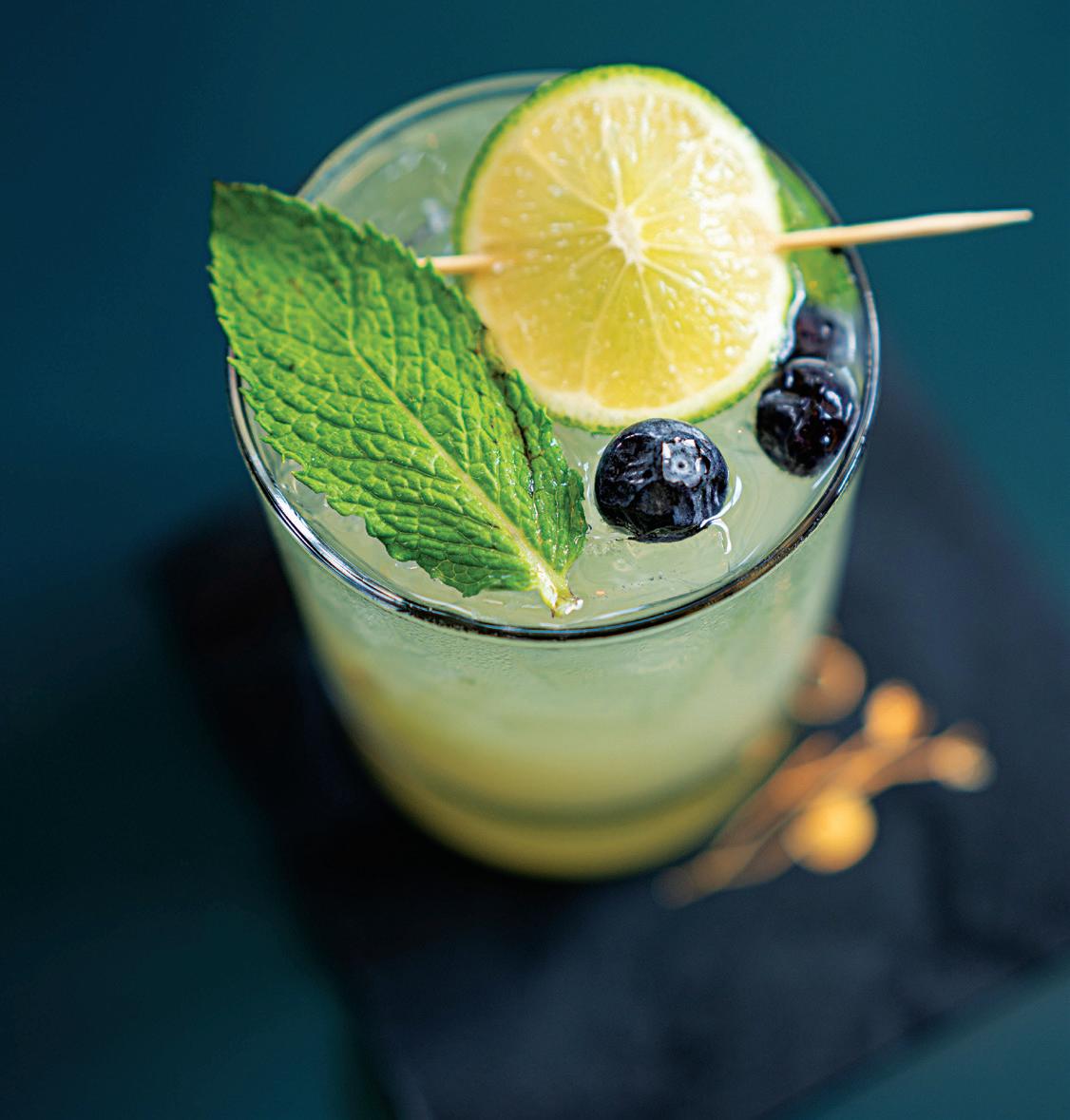

what they eat, how it's prepared, where it came from, was it grass-fed or grainfed… We are trying not just to tell guests these stories, but to show them,” he adds.
A common challenge for hotel restaurants is creating a unique identity and dining destination that can stand apart from the hotel. “It's the difference between ‘I’m going to this restaurant for dinner’ instead of ‘I’m going to this hotel's restaurant for dinner,’” says Roy. “By creating that solid identity, you can build a specific reputation that locals and visitors alike will treat as ‘destination dining,’ and they will typically go to further lengths to ensure they can experience it.”
At Ember Steak, he tries to cultivate the environment of a free-standing restaurant. “We like to compete with other restaurants within our company but also independent restaurants in the area through scores, reviews, check average, cover counts, and other metrics. It keeps the team on their toes, always striving to improve and excel.”
Jorge Negron, the newly appointed executive chef at South Florida’s awardwinning boutique steakhouse located in the Diplomat Beach Resort, envisions Diplomat Prime becoming a “a beacon of culinary innovation and excellence. My goal is to push the boundaries of flavors while maintaining a strong commitment to quality and authenticity,” he says. “In the coming years, I hope to see Diplomat Prime become a more widely known hub for creativity as well as a leader in gastronomic trends and sustainable practices. We are exploring new ways to integrate unique, locally sourced ingredients into our offerings, which I believe will set us apart and resonate with a broader audience.”
With four 4-Diamond Awards from AAA, Diplomat Prime is South Florida’s highest-rated steakhouse. One standout dish is the Curried Florida Corn Chowder, which became a guest favorite as soon as it was first introduced. The curry base is crafted in-house and



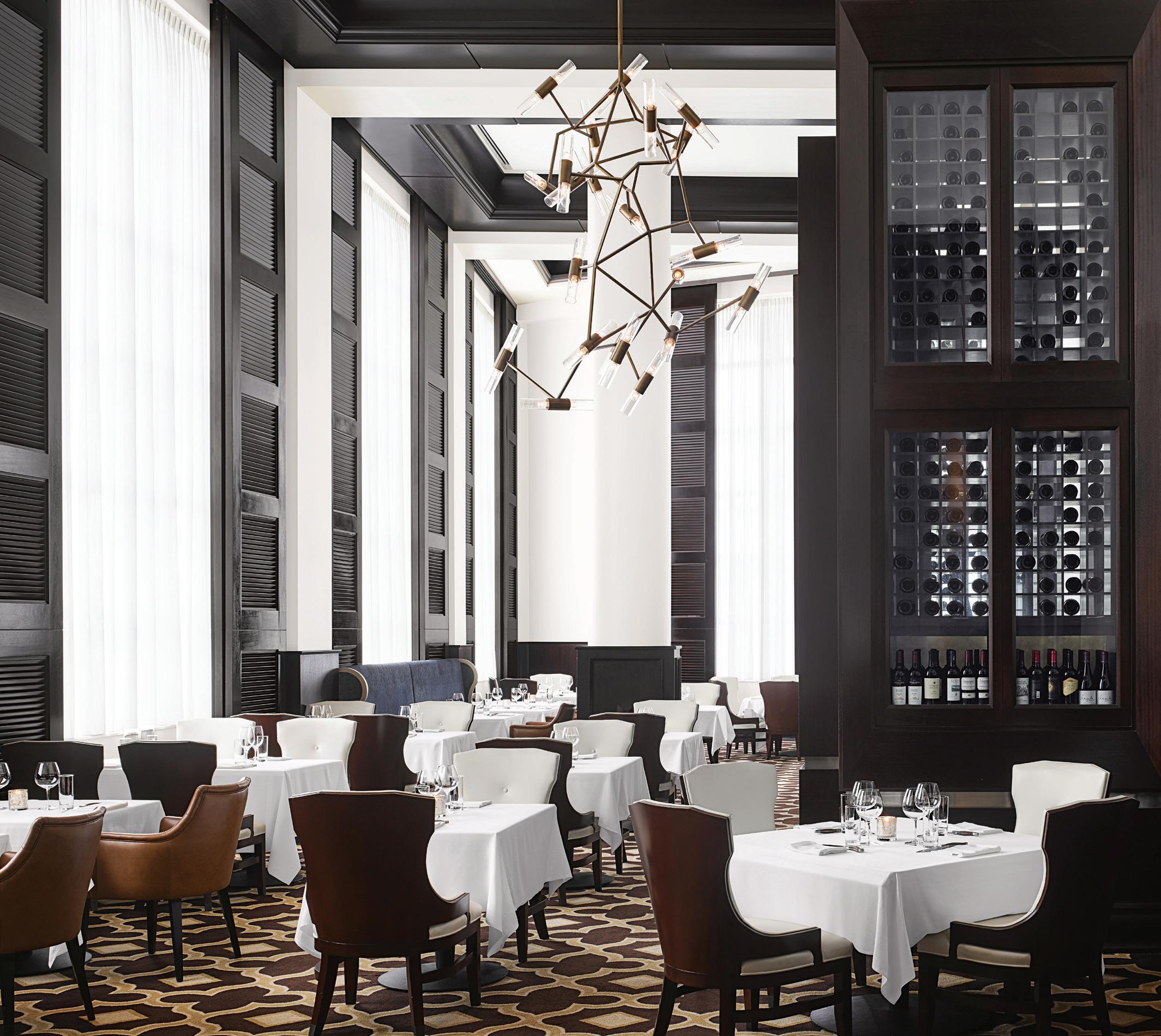
draws inspiration from Balinese curry, but with a unique twist. It’s adapted using local Florida ingredients to create a more subtle and refined flavor profile, Negron shares. “My culinary approach is unique in that I incorporate a variety of Puerto Rican (Caribbean) ingredients into my cooking, beyond the limitations of any specific cuisine,” he says. “My goal is to showcase the best qualities of these ingredients alongside South Florida flavors to deliver bold tastes that create memorable dining experiences; each bite offers something distinct and unique, avoiding repetition in every spoonful.”
Hugo Goodwin, executive chef of The Wild Sage at Jackson Hole’s Iconic Rusty Parrot Lodge & Spa, prides himself on never doing the same thing twice. “I am incredibly proud of the Lamb & Greens on our current menu; it’s a beautiful representation of simple elegance,” he says. “We are sourcing lamb from Fall River Ranch and greens from Canewater Farm. The dish is a classic hearty Italian style braise (my mother is Italian) featuring Castelvetrano olives and aged Spanish chardonnay vinegar, which is then elevated with a rectangular pasta veil that is laminated with encased green herbs. The experience is that of an unveiling, tearing through the herbed pasta sheet to reveal the braise beneath it.”
Goodwin has the unique challenge of reopening a restaurant that was a local institution after a five-year closure. Without ever having eaten at Wild Sage prior to its closure, Goodwin is tasked with how to remain true to what came before and please the diners that have been waiting patiently, while also taking note of new culinary trends and the many new locals of Jackson. “I had to get curious, asking to see old menus, photos, and speaking with the staff members that were employed before 2019. They provided me the informa -
tion needed to ascertain what the old space was like and remain true to the vibe, while also doing my own thing,” he explains. “I also met with as many farmers and producers as possible, so that I could find out what I could source locally and integrate into our menu.”
Classically trained, Goodwin is looking forward to the creative process of developing an ever-changing menu for The Wild Sage that is inspired by the season’s bounty. Offering an intimate atmosphere including outdoor seating and private dining space, Goodwin will also develop a curated cellar for the restaurant that focuses on low-intervention wines from new and old-world producers, to serve alongside unique dishes influenced by the natural surroundings of the Teton and Gros Ventre mountain ranges.
Engage your team and don’t lose sight of the magic
Chef Miguel Estrada was recently appointed to oversee the culinary programming at Canopy by Hilton Cancun La Isla’s two food and beverage concepts, Wander Rooftop and Azulinda Café & Bar. What excites Estrada the most is “creating dishes that tell a story or have a deeper meaning. I incorporate this trend into our menu by designing dishes that reflect our restaurant’s identity and heritage.”
For example, the Rocca shrimp is a favorite among both hotel guests and locals with its bold flavors and presentation, and showcases Estrada’s expertise in oriental cuisine. “Staying in tune with guest feedback helps me adjust and improve our offerings,” he notes.
In addition to providing attentive service to make sure guests have excellent dining experiences, Estrada puts an emphasis on extending that hospitality to his team. He organizes outings to local restaurants to inspire and motivate his staff, and to keep them engaged.




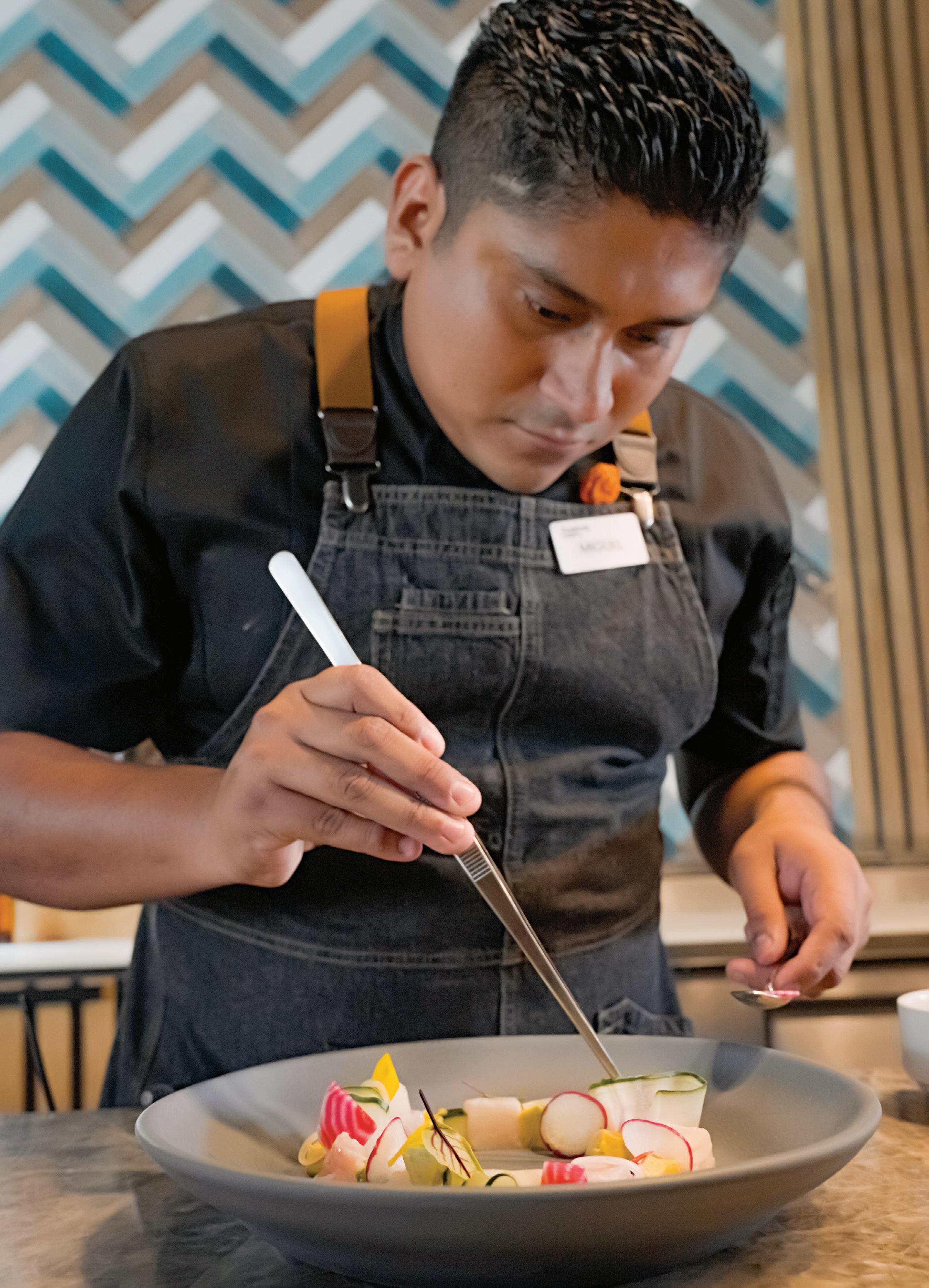

“By creating a supportive and collaborative work environment, I ensure that the team works well together, which helps in managing day-to-day operations smoothly,” he notes.
Goodwin agrees with Estrada, highlighting “It’s all about the people, and by that I mean both the diners and the team. Ask questions, be open to criticism, be kind, be gracious. Treat your team with respect, keep them invested and involved, make sure they feel heard and actively work towards their personal growth, even if it means losing them in the future.”
For aspiring chefs who are looking to excel in the luxury dining segment, particularly in a hotel or resort setting, Negron’s advice is to first ensure it’s truly what you want. “It's not just about enduring the physical demands, but also about handling the broader challenges of this career. Once you're confident, let your drive and passion guide you,” he says. “Always aim to do the right thing and strive for personal improvement—not just compared to your peers, but in relation to who you were yesterday. Don't be discouraged if you don't master something on your first try, and don't shy away from repetitive tasks. Remember, persistence and repetition are essential to mastery.”
Roy says, “Mistakes are a positive thing. They help you grow and lead you to success. Mistakes teach you that the world is fluid and sporadic; not everything will go as planned and yet it doesn’t have to in order to lead to success. Stay loose.”
Cannon adds, “If you are up for the challenge, the restaurant/hotel industry can be for you. Everyone thinks that they have to go to culinary school to gain all the knowledge needed, but hands-on experience is much better in my opinion,” she says. “If you are thinking of training in any one position, talk to everyone … You'll know when you've found your fit and which setting you'll thrive in the most. Trust the process; it's hard, long shifts and lack of sleep for sure but in the end, you're making magic for your guests.”





As we head into 2025, it’s time to start thinking about trends a little differently and zero in on what resonates with you and your restaurant brand.
BY MAEVE WEBSTER AND MIKE KOSTYO

ENGAGE YOUR GUESTS WITH SENSORY-DRIVEN EXPERIENCES THAT GO BEYOND TASTE— FROM AROMATIC COCKTAILS TO VISUALLY STUNNING DISHES.
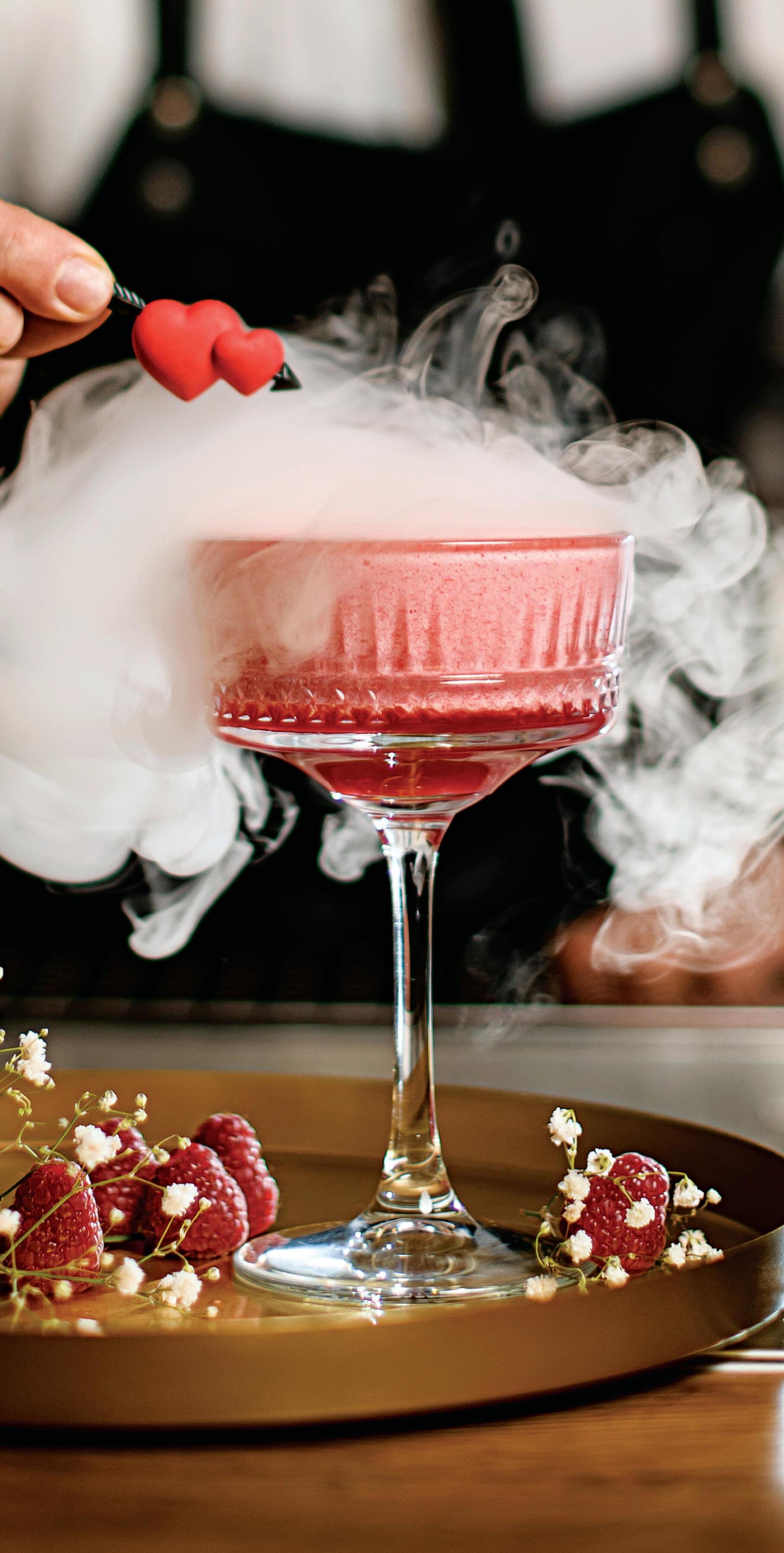
Every year, the food industry collectively scrambles to determine the top trends that will define the months ahead. These are the foods, flavors, ingredients, and dishes that are supposed to keep your concept and menu fresh and exciting in your customer’s eyes—shortcuts to success, you might say. The past decade is filled with the “it” trend of the year: avocado toast, gochujang, ube, birria, etc.
It's not that any of these trends are bad ideas, of course—each one is delicious in its own right. And they were certainly trending, depending on how you measured the trend— an increase in social media mentions, growth on menus, increasing sales, etc. You may have even put some of them on the menu with success in increased sales, mentions, or visitation.
But often we are sold these trends as the solution first, and we then must back into the problem we were trying to solve with that flavor or ingredient, if we think about it at all. When someone says avocado toast is trending, does that mean everyone should immediately put it on the menu? The breathless, ever-quickening pace of the trend cycle means we are constantly bombarded by trends, wondering if we’re missing out on a new consumer want and if the trends are passing us by. We are always sifting through this endless onslaught of trends, deciding if they make sense for our concept, brand, menu, and marketing goals. When we decide we should activate on them, we often feature them for a short amount of time, until that churn-and-burn trend cycle moves onto the next “it” item.
Instead of thinking this way, it’s time to flip the script. Consider this your chance to take a step back, decide what you are truly trying to solve for in the year ahead, and then decide which trends can help you solve those needs. That includes new ways of looking at value beyond just low prices and an endless stream of combo meals. It means giving customers a new way to escape the grind of everyday life, whether that’s through new experiences or global flavors. It’s also about focusing on hospitality again, giving customers the human touch that may be lacking.
As you think through the customer needs in the pages ahead, consider what resonates with you and your brand. Maybe you are looking for ways to give customers fun, exciting flavors and experiences that keep your concept young and fresh. Or maybe you want to incorporate more sensory experiences into the menu, getting your customers excited through smoky cocktails or the “crackling latte” trend. Once you’ve decided which customer needs will be a focus for your brand, it will then be much easier to choose the trends that will help you solve for those needs.
But there is one overarching customer need to keep in mind as we head into 2025: Customers are looking to you for something new. Today, more consumers are experimenting with new foods and flavors at home than they are at restaurants, a momentous change from pre-pandemic times, when customers mainly trusted chefs to introduce them to something new.
So it’s time to give them something fresh. After years of nostalgia and comfort foods, it’s time to get consumers excited again. It’s time to start getting creative, focusing on innovation and showcasing what consumers love about restaurants again.
OVER THE LAST YEAR, food has experienced some of the highest rates of inflation. From skimpflation and shrinkflation to higher prices at restaurants, consumers are feeling the squeeze. The result is increased tensions between consumers and the brands they purchase.
Yes, price is a key contributor to the perceived value of a purchase at foodservice. And extended periods of rising prices on menus has led 43 percent of consumers to want lower prices at restaurants in 2025.
But price isn’t the only factor. True value, value that is sustainable and impactful, is driven by more factors. When value is based on unique experiences, hospitality, consistent quality, and reliability, higher prices are less painful. Value underpinned by more than just cheap prices can and does drive greater patron loyalty, increased traffic, and greater acceptance of price increases.
No one wants to be taken advantage of, and that includes businesses. There are a lot of pressures now forcing prices to increase. Even though consumers may hear about legislation increasing minimum wages or understand food costs are rising, without effective communication they won’t immediately connect the dots. Remember, though, they are being squeezed. Realistically, we are all in this together, and communication with your patrons should focus on that.


How are you building greater value into your patron experience? If compromises on quality must be made, how are you offsetting those compromises to mitigate poor consumer perceptions. If portion sizes decline, can you increase the quality of key ingredients to offset that shrink? Can you improve the atmosphere or the hospitality to help support higher prices? Is technology eliminating pain points to improve the customer experience?
Increased costs must be addressed and tough operational decisions must be made to protect profit margins. These decisions can’t be made in a vacuum, discounting the customer experience. The decisions made to protect your interests should dovetail with improvements for your customers. They may not understand your business dynamics, but they will understand efforts to make their lives easier or better.
Take the time to find, and address, any value pain points. If you don’t, consumers will notice and go elsewhere.


2024 WAS A RECORD YEAR FOR TRAVEL. According to the Transportation Security Administration, the top 10 busiest days in the agency’s history have all occurred this year, with July 7 being the busiest day ever for the TSA as it screened over 3 million airport passengers for the first time.
The demand for experiences and travel has led to unprecedented crowds in some of the most popular travel destinations around the world, as tourists jetted off to London, Greece, Portugal, Japan, Croatia, Mexico City, Italy, Spain, and beyond.
Consumers clearly want to get away. Much of this travel is the result of pent-up demand from the pandemic, but it’s also partly due to the growing purchasing power of generations who prioritize travel and experiences.
That demand for travel also creates a demand for the foods, flavors, and ingredients that consumers discover on their trips or learn about from friends and family who travel. Japan, where a weak yen has made travel more affordable for visitors, has been breaking record after record for travel, welcoming more tourists than ever before in the nation’s history, according to the Japan National Tourism Organization. Visitors have been embracing Japanese food on these trips–and sharing them on social media–creating a booming market in the U.S. for options like matcha, a wide range of sandos, and tanghulu, the candied fruit that has trended on TikTok.
That gives you an opportunity to not only offer even more global foods, flavors, ingredients, dishes, and trends to menus, but to highlight the escapist nature of them. Don’t just put a matcha or cherry blossom latte or baked good on the menu, use evocative terminology like, “Travel to Japan with us this spring with flavors like matcha and Sakura.” Street food or night market menus and LTOs give customers a sense of place and escape in their everyday lives.
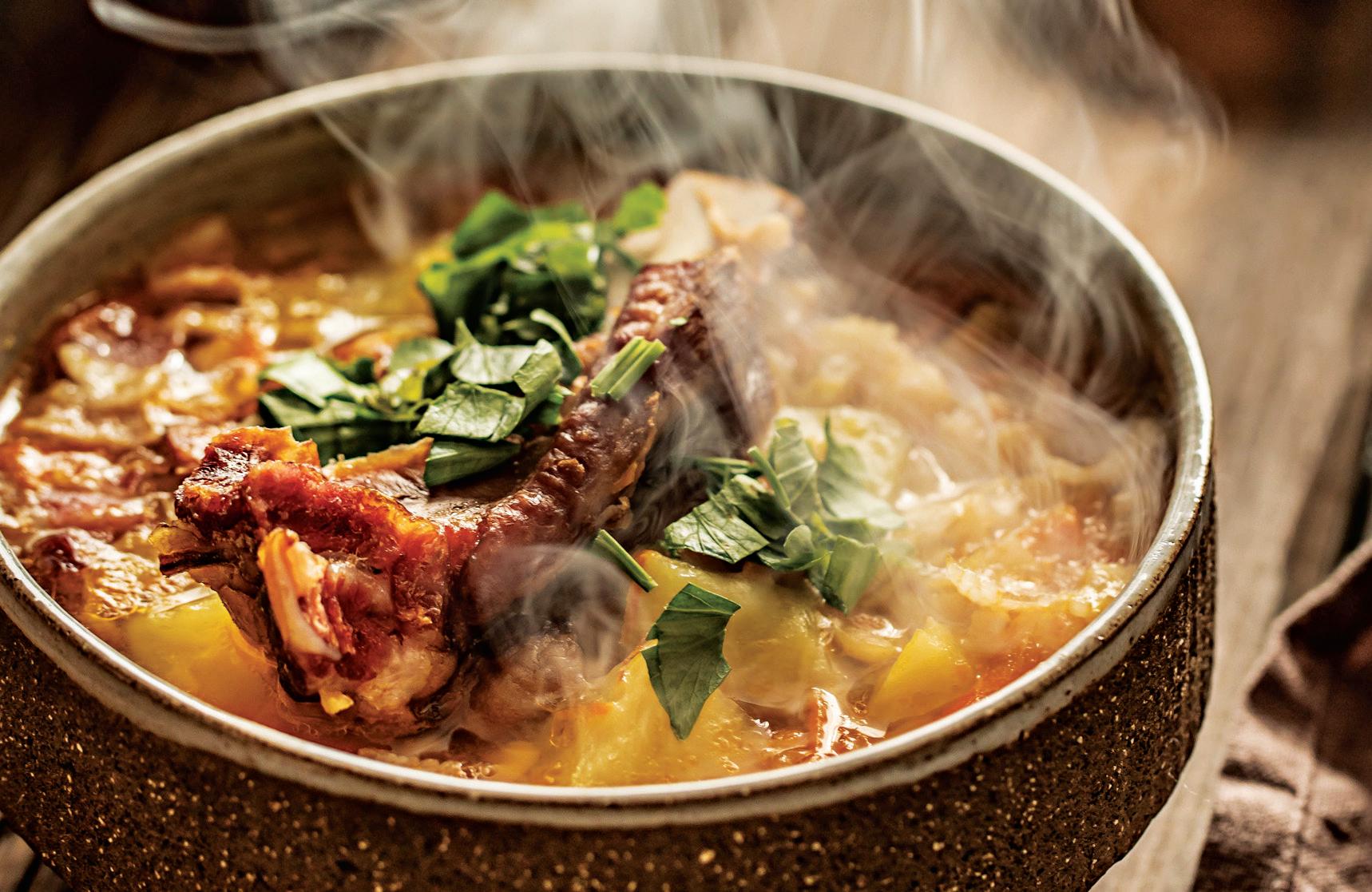
AS CONSUMERS EMBRACE a more optimistic and bolder approach to life, inherent in this is the desire for new sensory experiences. Food and dining away from home are among the few full sensory experiences a consumer can enjoy, alone or with others, and embracing all the senses is the best way for operators to truly connect with their patrons.
When asked to rate their senses in order of importance when selecting foods and beverages, it’s not surprising taste was ranked either No. 1 or No. 2 by 69 percent of consumers. Taste is critical, and taste exploration and experimentation is a key part of new experiences.
After years of focusing on the Instagrammability of foods, you may have guessed that consumers ranked sight second–but that’s not the case. Sixty-one percent ranked smell and aroma second. How effectively is aroma being used to create unique new experiences for consumers? Consciously innovating against aroma can change consumer experiences and reset expectations.
Sensory experiences extend well beyond the foods and beverages, starting when a consumer enters and following through to the end of the meal, which may be off-site or as they leave the property. Remember, all the senses should be engaged and thoughtfully considered to create not only new experiences, but the right sensory experiences unique to an operator’s brand. This includes the hospitality offered by employees and the interactive technology used to enhance or ease a patron’s experience. In the end, sensory experiences elicit emotional responses and emotions resonate far more with consumers than any one trend. What emotions do you want to provoke from your patrons?
Over the past 12 months, consumers have become more focused on sincerity and authenticity, and that’s as true for sensory experiences as it is for marketing and communications. Great food can be undercut by experiences that seem forced, artificial, or too consciously designed to elicit certain emotions. Make sure your experiences are as authentic as your brand voice and strategy.
THE WORD “HOSPITALITY” ITSELF comes from the Latin word “hospitalitas,” meaning to receive or care for a guest or stranger. Yet many consumers say that the hospitality is missing from the guest experience at many restaurants–they don’t feel like they’re being taken care of. Thirty-eight percent of consumers say the value of eating out overall has declined, which means one out of every three customers that walks in the door is primed for a bad experience.
At some restaurant concepts, customers are ordering on their phones, picking up a bag from a series of cubbies, never having to interact with a single person. At full-service restaurants, they may bring up the menu using a QR code and view it on their tiny screen, and they may pay for it using the same phone system. While in the short term these solutions may feel beneficial, in the long term consumers start to lose the human connection–the touch


of hospitality. Picking up a meal from a cubby starts to feel scarcely differentiated from buying a product at the supermarket.
That’s why a key trend for the year ahead will be helping consumers connect again. Operators will start looking for ways to make transactions less, well, transactional and more human and experiential again. In 2023, the U.S. surgeon general declared a loneliness epidemic across the country, comparing the health impacts of loneliness to smoking a dozen cigarettes a day. It’s a widespread issue: over a third of consumers say they didn’t eat a single meal with a friend or family member in the past week.
There is a place for technology, of course: some consumers are in a hurry, it does assist with labor crunches, etc. But when adopting tech solutions, consider the overall impact on the human connection that may be lost in the long term.
In the year ahead, consider ways to balance industry changes with the need to keep hospitality as a central, non-negotiable element of the dining experience. Tech may even be a part of the solution–can you use an app to reach out directly to customers more often, to invite them to an in-person event, to learn where the human connection points may be missing?
The decline in restaurant traffic may in fact be exacerbating the loneliness epidemic in the U.S., as consumers pull back from a place where they might connect.
But, that also means that there are few industries better suited to bringing back that human touch and helping consumers connect again.

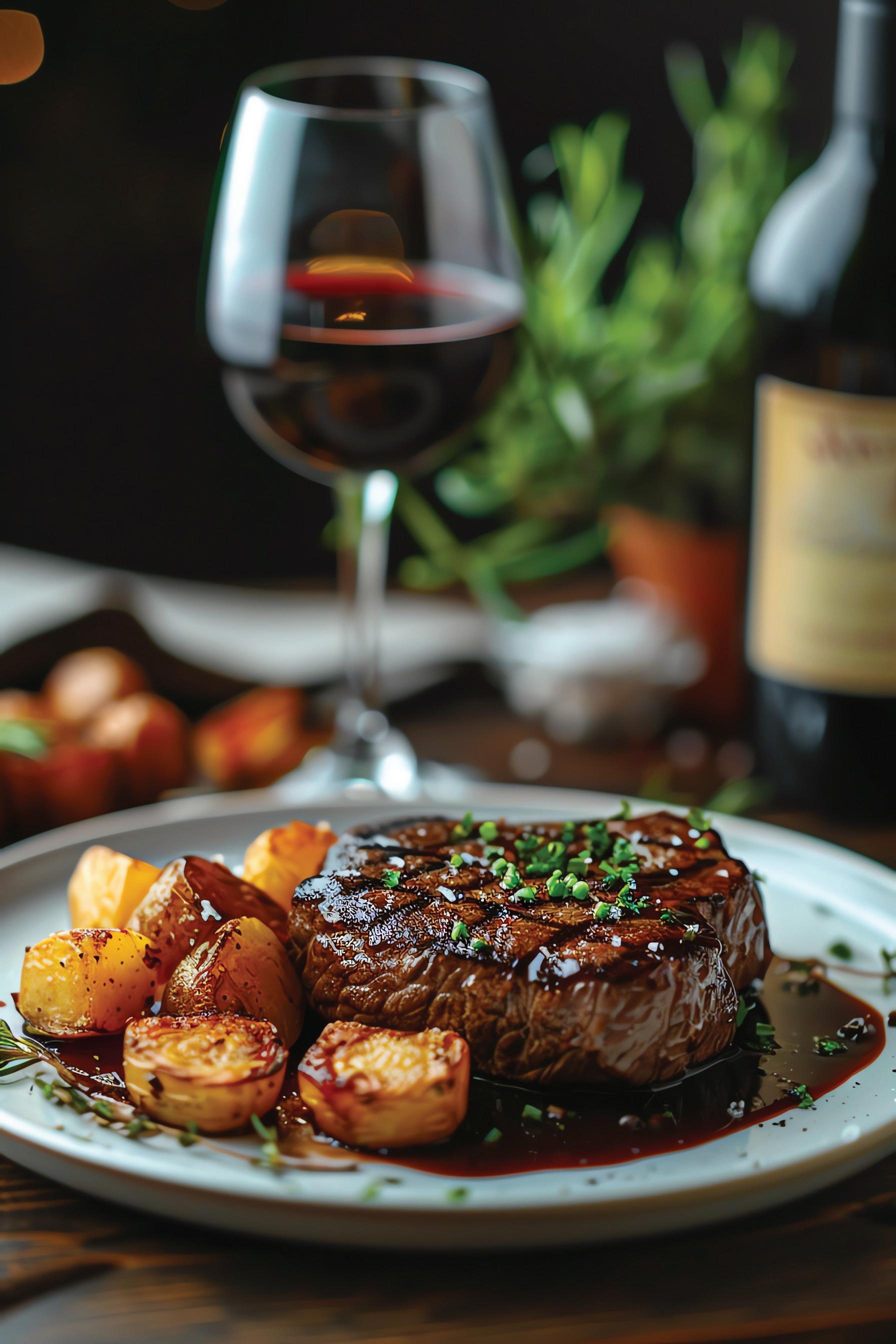
Teys USA, a division of Teys, delivers world-class, consistent grass-fed and grain-fed beef to foodservice operators across North and South America. Backed by decades of industry expertise, we’re committed to providing reliable protein solutions, including our high-quality beef programs like Teys Black, our hand-selected, 100+ day grain-fed beef, and Teys Australian Grassfed Classic beef, a 100% grass-fed brand, underpinned by Certified Humane.

At Teys USA, we offer more than just beef— we deliver a partnership that helps you succeed. Our protein solutions and processing capabilities can help streamline back-of-house operations, optimize waste and labor management, and deliver versatile proteins that elevate your menu. Count on us for an assured supply of consistent, high-quality beef, and solutions that inspire culinary creativity.









IN 2025, customers will continue to seek out the next exciting experience, but their expectations are evolving. It won’t just be about the latest dish or trending flavor, it will be about the story behind the food and the overall dining experience. Consumers will crave menus that offer a balance between familiar comfort and unexpected innovation, with a focus on sustainability and wellness. Incorporating these elements into a restaurant’s offerings will keep menus fresh and relevant and demonstrate a commitment to the values that matter to today’s diners. Staying ahead of these trends will ensure that restaurants remain top of mind and continue to excite loyal customers.
According to Strategic Market Research, 70 percent of U.S. citizens eat plantbased foods. However, the number of people who identify as vegan or vegetarian in the U.S. is lower. About 4 percent of the U.S. population identifies as vegan and about 5 percent as vegetarian.
This means there is a huge demand for vegetable-heavy dishes, but a small percentage want a meal solely of plants. “There is a plant-forward movement,” says Chef Barbara Alexander, a consultant for Real California Milk. “It’s where the focus in the diet is primarily on plants, but being open to animal products like dairy or meat.”

While increasing plant intake can have benefits, plantonly dishes can lack depth of flavor and may leave diners unsatisfied. Adding animal-based ingredients like dairy is an easy way to add flavor and nutrition and increase the perceived value of plant-forward meals.
“Without the richness and depth that comes from fat, these meals may leave diners wanting more. By incorporating dairy, chefs can address this gap,” Alexander says. “California cheese, for example, brings that element of umami, deliciousness, and craveability to plant-forward dishes.”
According to a 2024 California Milk Advisory Board study, 74 percent of operators rank the nutritional content of products as important or extremely important among purchasing factors of dairy products. Dairy products offer a good source of protein and essential nutrients like calcium, vitamin D, and potassium. With these benefits, operators can justify a higher price and attract customers seeking healthier meals.
“I think there are two ways to add perceived value to a dish: either by incorporating luxurious ingredients or by layering flavors,” Alexander says. “Too often, plant-based dishes like chickpea salads are basic, but you can elevate them by adding components like yogurt or cheese, which brings texture and flavor to the next level.”
When sourcing dairy, Real California Milk stands out for
its quality and reliability. With over 1,000 family-owned dairies and USDA-inspected products, California’s dairy industry offers a dependable supply of award-winning dairy year-round. The state’s favorable climate ensures a stable production process, keeping costs and product availability consistent for operators.
“I’m very confident in California dairy,” Alexander says. “I know that when I present it to chefs, they’ll be impressed with the quality.”
Real California Milk offers a diverse selection of over 200 brands, featuring everything from mozzarella and pepper jack to artisanal cheeses and a wide variety of Hispanic-style cheeses.
“Hispanic-style cheeses are often boxed into Latin American cuisine, but they have so many other uses,” Alexander says. “California cotija is a fantastic and inexpensive Parmesan replacement, and California queso fresco can be used as a feta substitute. For example, a watermelon salad with cotija and crema adds a unique twist by pairing sweetness with salty, rich cotija and crema.”
By incorporating Real California dairy products into plant-forward meals, operators can deliver delicious, nutrient-rich dishes that keep customers coming back— proving that plant-forward dining can be indulgent and satisfying. BY
OLIVIA SCHUSTER

CHEF
SHARES THE SECRET OF HIS SIGNATURE DISH!

Elote — F i re roasted cor n with s p icy ma y o, lime an d C a li fornia Cotija cheese a t Elote Ca fe in Sedona, Ariz
PEOPLE L OVE OU R SIGN ATU R E TA K E O N E LO T E SO MUC H … T H E FL AVO R SECRE T IS OU R SPICY COM POU N D M AYO AND C ALIFORNI A

In 2024, restaurants are stepping up their beverage game. Starbucks is the second largest fast-food company worldwide, in terms of brand value in 2022, with a value of 61.7 billion U.S. dollars, according to Statista. For restaurants striving to stay competitive, creating a menu with specialty drinks and flavors catering to younger generations is a smart way to increase profits.
Gen Z and Millennials are particularly drawn to beverages with a caffeine boost, such as coffee and tea. Whether at a cafe, restaurant, or drive thru, consumers are seeking out new and innovative drink options.
Matcha is a green tea powder that can be used to create a variety of caffeinated beverages, from lattes to lemonades. Matcha is predicted to outperform 99 percent of all other food, beverages, and ingredients over the next four years, according to Datassential. “People are always
looking for the next flavor and the next big thing,” says Angela Thompson, senior beverage innovation director at Monin. “I’ve noticed matcha appearing more on restaurant menus. A few years ago, I didn’t think it would be this prevalent, but now it is.”
Traditionally, matcha is a powder that can be difficult to work with. It often requires multiple steps for preparation, including whisking in one container and transferring to another, which can lead to a grainy texture and inconsistent results. This process can be messy and time consuming.
A solution that is opening doors for restaurants is Monin’s Matcha Green Tea Concentrate. The liquid concentrate streamlines matcha preparation so restaurants can more easily craft lattes, smoothies, lemonades, cocktails, and even baked goods.
“Since it’s already mixed and lightly sweetened, operators don’t have to worry about the messiness of powder or the risk of inconsistent mixing,” Thompson says. “It’s always going to be the same—one ounce of matcha concentrate with seven ounces of liquid. This takes out the guesswork and ensures every location serves a consistent and high-quality product, instead of having different recipes or variations depending on the individual making it.”
Monin’s Matcha Green Tea Concentrate has 40mg of caffeine per serving, making it the perfect alternative to coffee. “It still gives you a good kick with about half the amount of caffeine as coffee,” Thompson says. “Gen Z and millennials tend to prefer tea-based drinks, and matcha has a health halo that coffee doesn’t, while adding variety to the menu.” It pairs nicely with coconut and other trending Asian flavors, such as taro and yuzu.
Clean label and made with organic Japanese matcha powder, Monin’s matcha concentrate gives operators the ability to charge a higher price, and consumers are willing to pay. “It is understood that matcha is a luxury item on the menu,” Thompson says. “Highlighting it contains organic matcha is an important point, especially for younger customers like Gen Z and millennials.”
For operators looking to serve more beverage options, offering a trendy, versatile, and caffeinated product like matcha can drive customer interest, and boost profits. “Customers are used to getting premium drinks at specialty shops, now they can get high-quality matcha in more convenient locations,” Thompson says. “It’s nice to see everyone stepping up their game.” BY
OLIVIA SCHUSTER


When inflation bites and supply chains get tangled, some operators cut corners where it counts the most—sacrificing quality and flavor for cost. But choosing cheaper, lower-quality products could mean losing the very thing that keeps customers coming back: real, premium protein and honest-to-goodness taste.
According to the recent TouchBistro Diner Trends Report, 68 percent of diners said food quality is their top priority when deciding where to eat. Today’s consumers crave clean, all-natural, and organic ingredients, and operators are feeling the pressure to deliver without breaking the bank. It’s a delicate balance— sourcing high-caliber, costeffective ingredients that satisfy discerning palates and work across multiple SKUs.
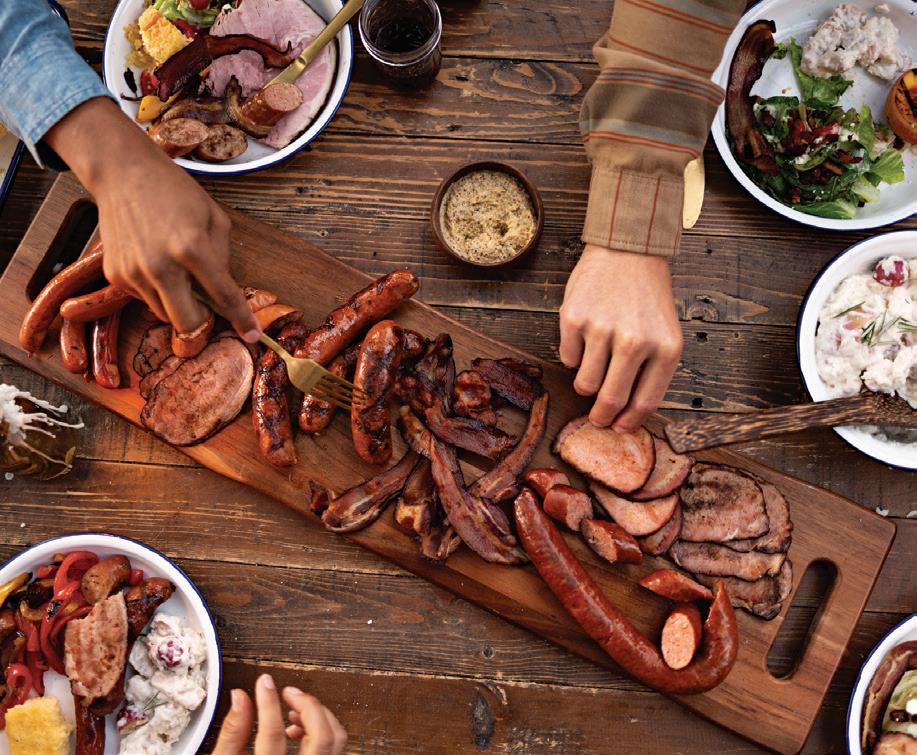

North Country Smokehouse, with its commitment to vertical integration and product excellence, provides a food service solution that ensures high-quality products, stable pricing, and a consistent supply chain.
When it comes to working with pork, particularly bacon, it can be a handful—requiring extensive back-of-house labor from storage to preparation. North Country Smokehouse’s newest innovation, Applewood Smoked Bacon Crumbles®, is designed to address consumers’ growing demand for high-quality proteins without compromising the bottom line.
“There’s no extra work involved,” Mattera says. “Employees simply open the package and plate, keeping operations moving without sacrificing flavor. Operators aren’t giving up anything to save money; they’re leveling up while saving on labor.”
Known for being a premium brand that doesn’t cut corners, North Country sources its pork from its independent, family-run farms. From feed to finishing and further processing, the company controls the entire process. This vertically integrated approach sets the company apart and ensures steady pricing and a seamless supply chain for its customers, while other brands are left riding the waves of market fluctuations.
Finding the right fully-cooked bacon crumble to round out a menu adds value when done right. Traditionally, bacon bits can be dry, dusty, and artificial in flavor and appearance. Many brands are bland and don’t meet the savory, fatty, and satisfying bacon flavor consumers crave.
“What’s most notable about the new crumbles, in particular, is their exceptional flavor and meaty mouthfeel,” says Mattera. “It has the same low and smoked flavor as the signature smoked strips we’re known for.”
In today’s challenging market, sourcing quality ingredients while managing costs is essential for operators looking to remain competitive. North Country Smokehouse, with its commitment to vertical integration and product excellence, provides a food service solution that ensures high-quality products, stable pricing, and a consistent supply chain. By offering premium options like Applewood Smoked Bacon Crumbles®, operators can elevate their menus with products that enhance flavor and satisfy customers’ expectations for quality and customization. ✦
Operators are tired of dry, flaky bits that sort of resemble bacon – but not really. So, we handcrafted a premium yet unpretentious crumble that honors the art of meat mastery. We knew they had to taste just as good as our signature smoked strips and be free from all the fake stuff.
We selected the finest pork bellies from our very own farms and bathed them in our New England made maple syrup brine. Then, we crumbled them into hearty, irregular shaped pieces that actually solve industry challenges. The results are in.
Worlds apart from the bland bits you’re used to, these savory smoked crumbles have a balanced flavor and perfect bite. Better yet, they help to lessen labor costs, enhance menu efficiencies, and will never diminish a dish. Available in humanely raised and organic recipes.
Meaty Mission Accomplished.




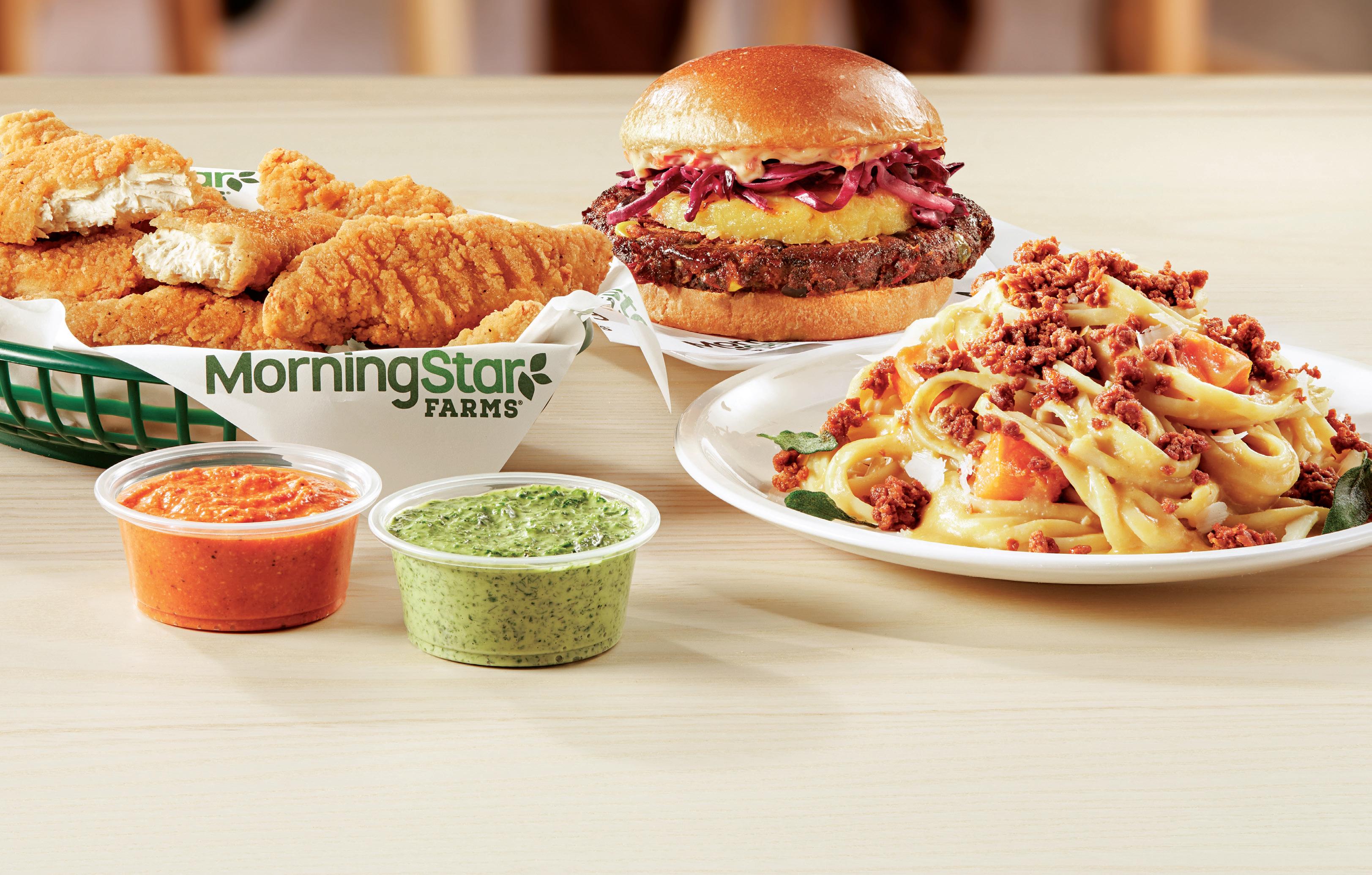
How to cater to younger consumers’ demands in fusion flavors.
As Gen Z and millennials continue to dominate the food market, operators and chefs are under increasing pressure to adapt to their evolving tastes. Favoring bold, innovative, and authentic ethnic flavors while prioritizing sustainability and health, Gen Z and millennials are driving significant changes in how the industry develops menus.
According to a study by Gordon Foodservice, 61 percent of millennials want to try unique and innovative foods. Meanwhile, Gen Z is the most diverse generation, which is reflected in its food preferences. Restaurants must meet this growing demand by offering exciting flavor experiences that captivate customers.
Chef Mitchell Aboujamra—the owner and executive chef at Evette’s, located in Chicago—is a first-generation Lebanese-American who grew up immersed in three food cultures that serve as his foundation: Lebanese, Mexican, and Midwestern. Chef Aboujamra is constantly innovating and offering new dishes to consumers. “My restaurant is a Lebanese and Mexican fusion,” Aboujamra says. “My dad and his friends played a role in everything I learned. The result
is a restaurant that’s 70 percent Lebanese and 30 percent Mexican, with the taco as the vessel for everything else.”
Fusion food restaurants—like Chef Aboujamra’s—are great for highlighting authenticity while providing bold innovations younger consumers are hungry for. Conversations about fusion cuisine have increased more than 18 percent over the past year, with the dominating diet being vegan, according to Tastewise.
A whopping 79 percent of Gen Z reported being “eager to go meatless” a few times a week with 60 percent saying they are ready to base their diets on “plant-forward foods,” according to a new survey by YouGov and WholeFoods Market.
“Introducing plant-based options like MorningStar Farms® just feels like a natural evolution. My mom grew all our vegetables on a farm, so we always had fresh produce,” Aboujamra says. “Meat was important, but there were always natural meat replacements like eggplant and Halloumi in our diet.” Plant-based proteins are a good way for restaurants to indicate they are innovative while offering consumers a familiar format to experiment with plantbased proteins.
For Chef Aboujamra, finding ways to innovate and be creative while remaining true to his brand are at the core
of his fusion offerings and ideals. Because of that and with the rise in demand for plant-based meat alternatives, Aboujamra began the search for a vendor that could cater to consumers’ and his needs as a chef and operator.
“It’s about smart options. I wanted a variety that fit the brand and made sense for what I was doing,” Aboujamra recounts. “Over the years, I’ve introduced something new each year targeting different communities.” This year brings the introduction of MorningStar Farms Plant-Based Chik’n Tenders in October, which Aboujamra will be introducing in multiple formats.
These chik’n tenders will be incorporated into his menu, catering to a variety of palates while staying consistent with his brand’s unique fusion style. “Consumers are looking for ways to safely experiment with new foods, and brand recognition is key, especially with vegan and vegetarian options,” Aboujamra says. “It makes it easier to introduce new options when the brand is trusted.”
Aboujamra’s strategy of incorporating plant-based options into his offerings has proven successful in the past. “When we launched falafel, it took off more than I could have anticipated,” Aboujamra says. “We’re going through more and more every month, and the same happened with our sweet potato fries. I think this new option with MorningStar Farms will follow a similar path.”
The rising demand for plant-based options isn’t just a passing trend—it’s becoming a permanent fixture in menus across the foodservice industry, especially as Gen Z and millennial consumers increasingly seek out alterna-

tive proteins. Restaurants that cater to this demand are attracting these younger consumers but also positioning themselves as forward-thinking and adaptable.
For Chef Aboujamra, adding MorningStar Farms products to his menu is about maintaining the authenticity of his brand while giving diners the choice to enjoy familiar dishes in plant-based formats. “MorningStar Farms fits perfectly into that approach, giving me more options without compromising on the brand’s identity,” Aboujamra says. “It’s all about giving everyone the same experience with just a different protein choice.” This approach ensures his menu appeals to a wide range of dietary preferences while maintaining the core identity of his Lebanese-Mexican fusion concept.
The versatility of MorningStar Farms products also allows for creativity in the kitchen, something that’s important for chefs looking to expand their offerings without dramatically altering their operational flow. “We’re using those chik’n tenders as an option for everything, and I hope, after October, this becomes permanent,” Aboujamra says. He plans to incorporate the MorningStar Farms Plant-Based Chik’n Tenders in a variety of dishes, from tacos to bowls, offering consumers the same flavorful experience they’ve come to expect from his restaurant, but with a plant-based twist.
Aboujamra emphasizes that the texture and quality of plant-based products play a critical role in their success. “I think the best options will start to stand out as the trend grows. For me, it’s about the quality and texture, which MorningStar Farms nails. The versatility of their products makes it easier for me as a restaurateur to create something that resonates with my customers while keeping loss low,” he explains.
As plant-based eating continues to rise in popularity, chefs like Aboujamra are paving the way for its seamless integration into menus without compromising on taste or quality. Consumers—especially younger consumers making up a larger portion of the market than ever before— are demanding options and innovations that suit their lifestyles. For Aboujamra, it’s all about balance—offering bold, innovative dishes that reflect his heritage while providing smart, plant-based alternatives that cater to modern dietary preferences.
With the plant-based trend gaining traction, it’s clear that chefs and restaurateurs who embrace this movement will not only attract a broader customer base but also strengthen their brand’s reputation for innovation and sustainability. As Aboujamra continues to experiment with new ingredients and products like MorningStar Farms, his restaurant serves as a model for how to offer inclusive and exciting dining experiences that meet the evolving tastes of today’s consumers. ✦







BY OLIVIA SCHUSTER
“Customers return to an operation because they like the experience. Whether it’s food or drinks, if the experience is unreliable, it can impact traffic, repeat purchases, and eventually, profitability.”

Boost profitability with a consistent beverage program.
In the restaurant industry, operators constantly seek new ways to meet customer demand for variety and quality. Hand-crafted beverages like coffee, tea, and lemonade have become a valuable offering, helping restaurants elevate their menus and provide unique experiences. Operators are also looking to add unique offerings to their bever -
age program without additionally taxing their back of house, like training employees or adding time and complexity with measurements and mixing.
“Consistency is a challenge for many operations,” says Emily Wood Forehand, senior vice president of strategic marketing at Red Diamond. “That’s true for beverages as well as food. For example, tra-
ditionally employees will brew tea and then mix sugar directly into the urn. At face value, it’s a relatively simple process, but with the reality of labor shortages and training challenges, we’ve seen recipes vary by day, location, and sometimes even by brew.”
When it comes to drinks, consumers crave consistency. If they know their





































































reddiamondbevservice.com/sample-kit/





























morning coffee or afternoon tea will have the perfect flavor and sweetness every time, they’ll keep coming back for more.
“Customers return to an operation because they like the experience,” Forehand says. “Whether it’s food or drinks, if the experience is unreliable, it can impact traffic, repeat purchases, and eventually, profitability.”
fee and tea can stand alone or be customized to create signature beverages. Operators benefit from both a higher check as well as a unique and differentiated beverage experience.”
Red Diamond’s senior vice president of the Away From Home division, Will Bowron, highlights that beverage categories are becoming more crowded and
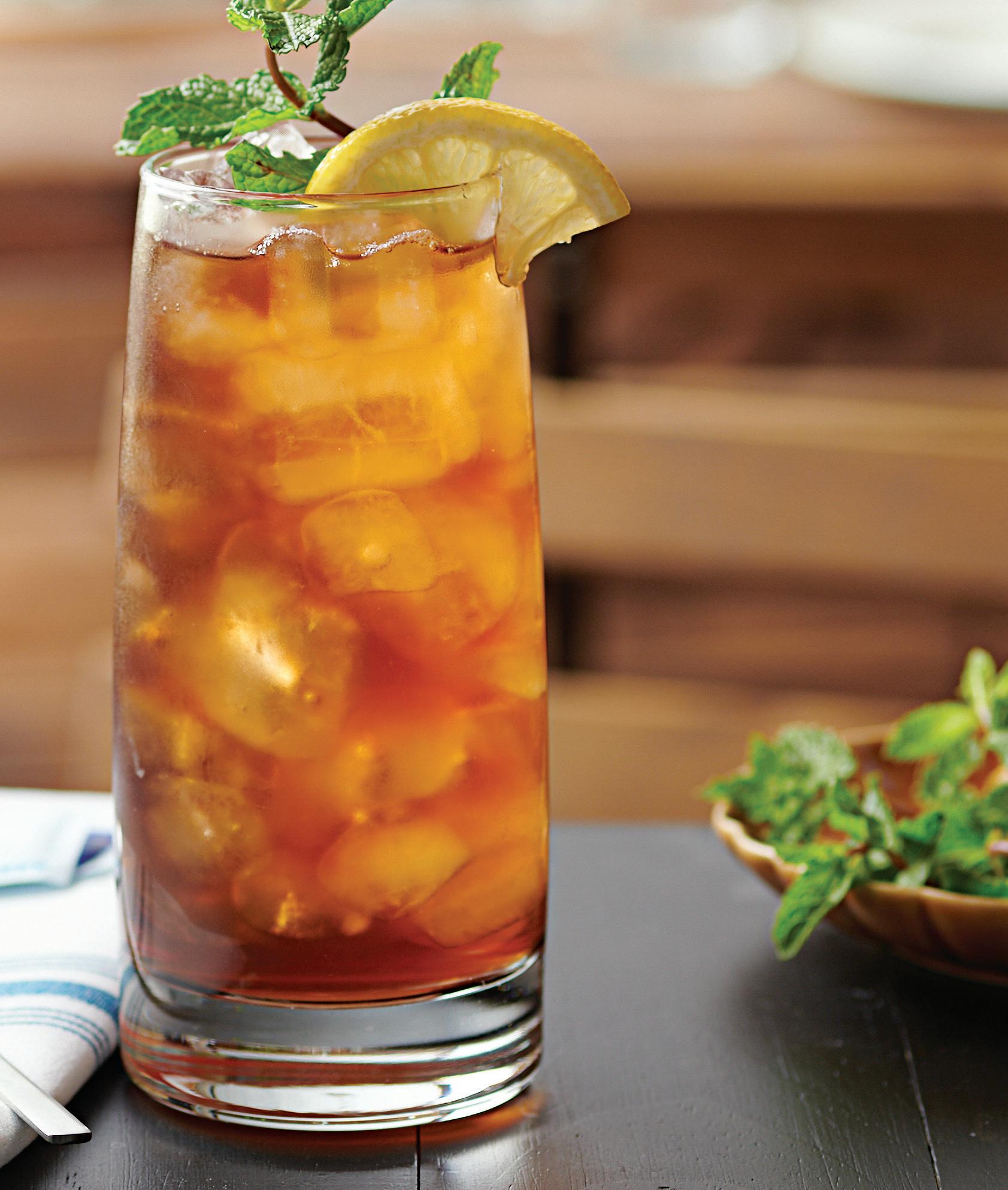
Beverage programs play a vital role in a restaurant’s financial success, often contributing significantly to its gross profit. According to the Nationwide Caterers Association, one cup of coffee can have a profit margin of up to 95 percent, which is higher than the 60 percent margin for food.
“Outside of alcohol, coffee and tea are the most profitable items on an operator’s menu,” Forehand says. “They’re often an upsell from water, and both cof-
“Outside of alcohol, coffee and tea are the most profitable items on an operator’s menu. They’re often an upsell from water, and both coffee and tea can stand alone or be customized to create signature beverages.”
competitive with new product offerings constantly becoming available. “It’s important for operators to identify what products are going to resonate with their consumers, while also being easy for them to add to their beverage menus”, Bowron says.
Red Diamond’s Simple Sweet line answers those operational needs. With Red Diamond Premium Tea or Lemonade and cane sugar pre-mixed in a filter pack, you can brew and sweeten at the same time.
“Our Simple Sweet line of products solves consistency issues by adding premeasured sugar directly into the filter pack,” Bowron says. “This guarantees a consistent recipe with each brew and alleviates the need for additional training or labor. It’s been so successful we’re constantly adding to the line. We now have an Extra Sweet Simple Sweet Tea as well as a Simple Sweet Lemonade with real lemon pieces.”
As the popularity of cocktails and mocktails continues to rise, Red Diamond’s tea and lemonade also provide operators with an easy way to introduce new and trending flavors to their drink menus. Additionally, Red Diamond’s new Iced Coffee can also be brewed on the same equipment as their Simple Sweet products, allowing operators to save counter space, ensure consistency and reduce labor.
When iced coffee is brewed hot and poured over ice, it tends to become diluted and lose its flavor. However, if made correctly, it becomes a fan favorite and a profitable beverage. According to the latest National Coffee Drinking Trends report, 45 percent of coffee cups consumed yesterday by those 18-24 were cold. “Our iced coffee offering is designed to brew 1.5 gallons of finished product,” Forehand says. “It is intentionally crafted to be poured over ice and is cooled during the brewing process for a rich, delicious flavor.”
Red Diamond has been an innovator and leader in crafting quality coffees and teas since 1906. Partnering with Red Diamond means partnering with a team focused on customer service and quality, ensuring customers are always enjoying a perfect beverage experience.
“Our Simple Sweet line, and new Red Diamond Iced Coffee are the perfect answer for operators looking to grow or expand their beverage program,” Forehand says. “Not only do our new products benefit back-of-house operations, they also keep your customers coming back for more.”































Red Diamond® is focused on providing innovative product solutions to answer the needs of your operation. Our newest program is designed to help you enter multiple beverage categories with limited space and equipment investment. With Red Diamond, you can serve up the freshbrewed flavor your guests demand with the back-of-house efficiency you need.














A collection more than 100 years in the making, Morris & Park® is a curated selection of hot teas crafted from the finest tea leaves, herbs and spices from around the world. Treat your guests to the unparalleled quality and exceptional flavor you’ve come to expect from Red Diamond.













TRY PERFECTION (ON US)
reddiamondbevservice.com/sample-kit/











• Simple Sweet Tea®













• Extra Sweet Simple Sweet Tea
• Red Diamond® Unsweet Tea















• Simple Sweet™ Lemonade (NEW!)
• Red Diamond Iced Coffee (NEW!)













































• Nitro cold brew is the top trending coffee variety, experiencing the highest four-year growth at 72%.
• Iced tea is featured on the menus of 55.1% of restaurants.
• Raspberry and peach are among the most popular flavors, with raspberry at 13.1% and peach at 9.8% on restaurant menus.

• Chai has seen significant growth over the past four years, with a 19% increase in menu presence.
• The coffee flavor cocoa has declined in popularity, with a 14% decrease.
MATCHA LATTE Beverage consisting of matcha powder (made wfrom green tea leaves), water, milk, and sweetener, that can be served hot or cold.
CONSUMERS:
MENU EXAMPLE:
Strawberry Matcha Latte: Smooth and creamy latte made with milk, fresh strawberries, and premium matcha imported from Japan.
85 Degrees C Bakery Cafe // CYPRESS, CA


KOMBUCHA TEA A tangy, effervescent beverage produced through the fermentation of sweetened tea with a symbiotic culture of bacteria and yeast, offering potential probiotic benefits.
CONSUMERS:
MENU EXAMPLE:
Local and Organic Kombucha on Tap: Probiotic raw organic, microbrewed in Vermont. Caravan of Dreams // NEW YORK CITY






























































































NITRO COLD BREW Coffee is infused with nitrogen, which gives it a unique, creamy texture.
CONSUMERS:
MENU EXAMPLE:
Spiced Honey Pistachio Cold Brew: Honey cardamom syrup, cinnamon, cream, cold brew. topped with sweet cream cold foam and ground pistachios.
Avalon Cafe And Bakery // DETROIT, MI
INCEPTION Trends start here. Found in mostly fine-dining and ethnic independents, inception-stage trends exemplify originality in flavor, preparation, and presentation.
1. Micro Roasting
2. Australian Iced Coffee
Lavender 4. CBD Oil
ADOPTION Found at fast-casual and casual independent restaurants, adoption-stage trends grow their base via lower price points and simpler prep methods. Still differentiated, these trends often feature premium and generally authentic ingredients.
1. Coffee Lemonade/Laura Palmer 2. Bubble Tea

SWEET TEA A popular Southern beverage that consists of black tea brewed strong and sweetened with sugar, often served over ice for a refreshing, sweet, and slightly astringent drink.
CONSUMERS:
It
MENU EXAMPLE:
Sweet Tea: Southern sweet iced tea made in a special recipe with filtered water and cane sugar.
Country’s Barbecue // COLUMBUS, GA

PROLIFERATION Proliferation-stage trends show up at casual and quick-service restaurants. They are adjusted for mainstream appeal. Often combined with popular applications (burgers, pastas, etc.), these trends have become familiar to many.
Cinnamon 2. Cold Foam
4. UBIQUITY Ubiquity-stage trends are found everywhere—these trends have reached maturity and can be found across all sectors of the food industry. Though often diluted by this point, their inception-stage roots are still recognizable.
Chef Eileen Andrade continues to push the boundaries of elevated Cuban-Asian cuisine while paying homage to her family’s culinary legacy at her Miami restaurants, Finka Table & Tap and Amelia’s 1931.
FOLLOWING A SUCCESSFUL restau rant career in Cuba, Eileen Andrade’s grandfather settled in Miami, where he opened one of the city’s most wellknown Cuban restaurants, Islas Canar ias, in 1977. Andrade grew up working in the kitchen and quickly recognized her creative flair.
“It’s embedded in [my family’s] blood to be hospitable. We love to cook, we love to serve others, and you either have it or you don’t,” Andrade says. “This is a career you have to love because the busi ness can be draining, and cooking can be incredibly laborious. But I grew up loving what hospitality was at its core.”
In college, Andrade channeled her creativity into Miami’s budding fashion industry, accepting an unpaid internship with a top stylist. She initially veered away from the demanding restaurant life of her parents, which offered little work-life balance.
This stab at fashion didn’t last long. Low on cash, she returned to Islas Canarias as an official employee instead of a teenage helper, starting as a dish washer and working her way through every position—busser, server, baker,

cook, and working both the front and back of the house.
Her mother asked, “What do you like the most?” Andrade responded with a newfound passion for both leading a team and cooking, learning from Islas Canarias executive chef Omar Caycho as she ventured deeper into her culinary career.
“I fed my creativity into cooking, and eventually, I had to quit my internship with the stylist,” Andrade recalls. “He took it as an insult—that I would leave the fashion industry to make Cuban steak sandwiches. I got so mad … those sandwiches paid for the car that drove us around, my school, my clothes, my everything.”

In 2011, at age 21, Andrade and her brother opened a food truck called Cuban Cube. She calls it her version of culinary school; it taught her to think on her feet, resolve operational issues quickly with a small team, and battle Miami’s hot, rainy atmosphere. Despite its closure, Cuban Cube built a steady following and became the first of many concepts in Andrade’s portfolio.
A 2013 trip to South Korea sparked Andrade’s curiosity. At Islas Canarias, she had already immersed herself in Peruvian and Cuban cuisine, but after taking cooking classes with a retired Korean woman, new inspirations took root.
Next came Andrade’s first official fullservice venture, Finka Table & Tap, in 2014. The 222-seat restaurant, inspired by Korean, Peruvian, and Cuban flavors, was a far cry from the food truck and brought eclectic cuisine to the suburbs of West Kendall in Miami. Here, Andrade blended her globally-infused creativity with an homage to her family’s roots through rustic interior design, craft cocktails, and scratch-made food.
“Finka means ‘farm’ in Spanish, and because my grandfather grew up on a farm, I wanted to honor him in that way. There are a few dishes on the menu that were his favorites,” Andrade says. “It’s been busy since we opened the doors. I was fortunate to receive such a great response from the community.”
“The most important thing [for young chefs] is to truly love what they do. It’s not about being trendy or cool; it’s about cooking for people and making them happy. As long as that’s your passion, the rest will follow.”
In 2017, Andrade opened Amelia’s 1931, renovating her grandmother Amelia’s diner. During the pandemic, she acquired the dry cleaner next door, adding a full bar and increasing the seat count to 150. Amelia was a seamstress when she came to the U.S., so guests walk through rows of dry cleaning and pass a washing machine upon entering. This nod to her grandmother’s legacy is underscored by the presence of Amelia’s original sewing machine, along with sentimental furniture and knickknacks.
Like Finka, Amelia’s 1931 offers elevated Cuban flavors, enhanced by Asian and Peruvian influences. However, the atmosphere differs; there’s a dress code, and Andrade describes it as a moody, sexy cocktail lounge with the charm of a hidden gem. Amelia’s 1931 represents a woman who enjoyed dressing in her finery and going out on the town—and
that is the energy Andrade seeks to cultivate with this newest concept.
“I wanted guests to feel like they’re stepping into another era or country when they walk through the doors,” Andrade says. “I want people to forget their problems and sit down to eat and drink with others. Amelia’s 1931 is a very special space to me.”
Andrade’s journey from her family’s kitchen to two upscale concepts at a young age solidifies her love for the industry and her community. Along the way, she’s learned to invest heavily in her staff, break the stigma around work-life balance, and live as her true, authentic self. Through mentorship and advocacy, she’s passionate about creating a safe space for the LGBTQIA+ community in her restaurants. While she says it’s part of her identity, it doesn’t define her entirely. Andrade often speaks at her old high school’s career days and regularly receives messages from young girls who look up to her.
“The most important thing [for young chefs] is to truly love what they do. It’s not about being trendy or cool; it’s about cooking for people and making them happy. As long as that’s your passion, the rest will follow,” Andrade says. “You have to work alongside your crew, not above them. You have to be willing to get your hands dirty … This job comes with long hours and nights, and you need to stay passionate and find balance.”
Andrade looks forward to strengthening her presence in Miami with the continued success of Finka Table & Tap and Amelia’s 1931. While opening a smaller bar concept isn’t off the table, for now, she remains focused on investing in her current staff and community, honoring her roots, and continuing to innovate with her Cuban-Asian cuisine.

A finance and franchise expert is breathing new life into the Florida-based breakfast brand with a focus on homestyle cooking and a family atmosphere.
DANIEL D e LEON, who now sits as Grumpy’s Restaurant president and CEO, began his career in finance.
“I thought it was going to be like Wolf of Wall Street,” he says, but he felt that he needed something beyond the cubicle life. He has been a franchise owner for a decade, but yearned for a full-service startup experience.
Grumpy’s first opened in 1999, the post-retirement brainchild of an ex-U.S. Navy chef, lovingly referred to by his community as “Chef Grumpy.” After two years of owning and operating the single location, Chef Grumpy stepped down, resulting in 15 years of uncertainty. During this period, says DeLeon, the restaurant was handed off six different times. The concept’s theme, ambiance, and core identity also waffled during this time, with one year spent serving French-style cuisine and the next as a dinner service. The Jacksonville, Florida, eatery could not find a brand DNA that stuck.
“When we purchased [Grumpy’s in 2017], it was really like a lease takeover, and a really small purchase because the business wasn’t doing well,” says DeLeon. He and his wife Morgan rebranded,
OWNERS: Daniel and Morgan DeLeon
HQ: Orange Park, FL
CUISINE: Breakfast/ Lunch

UNITS: 5
YEAR FOUNDED: 1999, franchising since 2019
relaunched, and revamped
Grumpy’s, and eventually decided to keep its original essence—serving American diner classics at a “working man’s price.”
“This wasn’t something where we came in with a group of executives … It was really bootstrapped, with me and my wife really taking it, developing, making the changes, instituting the policies and procedures,” DeLeon says. “Coming from ground zero, we changed literally everything.” After carefully pulling the restaurant from the grip of a possible foreclosure, his neighborhood passion project has paid off.
With his personal background in multi-unit franchise operations and franchise consultation, a franchise pro -
gram was launched, resulting in four new locations across Northern Florida.
While the flagship Grumpy’s in Jacksonville’s Orange Park suburb has tripled in size, so has its menu. The restaurant began with a concise 10-item menu, whereas now, “we have more items than that in our omelet section,” DeLeon says.
The continual support of their franchisees is what DeLeon cites as a main factor in their current success; “That is the number one thing we do do that differentiates us from most franchise concepts … that we will be as supportive and active with a franchisee as they would like us to, and that’s everything from wanting us to be on-site more often, weekly calls, [or] biweekly calls.” While some of Grumpy’s franchisees have ten-
ured experience in the space, others prefer “assistance in smaller, more daily operational areas.”
“We really run this with a sense of family,” says DeLeon, elaborating that the Grumpy’s team does not discriminate between corporate-run or franchised restaurants and runs them both the same. Rather, they talk frequently on DeLeon’s personal phone line or during in-person visits.
During his past as a multi-unit franchisee, DeLeon notes that communication and assistance from the corporate team were scant; “One of the brands I was with I didn’t hear from or see a rep for four years,” he says.
DeLeon’s experience led him to pursue a more hands-on relationship with his franchisees. They use third-party companies for inspections and audits, but the CEO still loves to dine in at a location to check in with the staff to help everyone “get to the next level.”
Cooking from scratch has become part of Grumpy’s philosophy, which means the kitchen is heavily led by prep cooks and line cooks—a difficult business model, especially when it comes to franchising. But DeLeon affirms the systems and process is very teachable, and oversees that franchisees with operations or business backgrounds learn the correct kitchen procedures. “We don’t do anything too complex or fancy,” he says, “but we do quality all the time.”
“From a customer standpoint, we are committed to the traditional Americana,” says DeLeon. “We serve a working person’s portion at a working class price, and we really try to stick to that.”
Spanning across North Florida, all Grumpy’s locations receive their ingredients from the same distributor. Everything at Grumpy’s is made from scratch— an entire turkey is roasted daily, and soups are created in-house each morning. While creating everything in-house is more expensive than using frozen or pre-made concoctions, Grumpy’s doesn’t cut any corners. “We refuse to do it. Our customers just demand that homemade, made from scratch product,” DeLeon says.
Some of the brand’s most popu -

“From a customer standpoint, we are committed to the traditional Americana. We serve a working person’s portion at a working class price, and we really try to stick to that.”
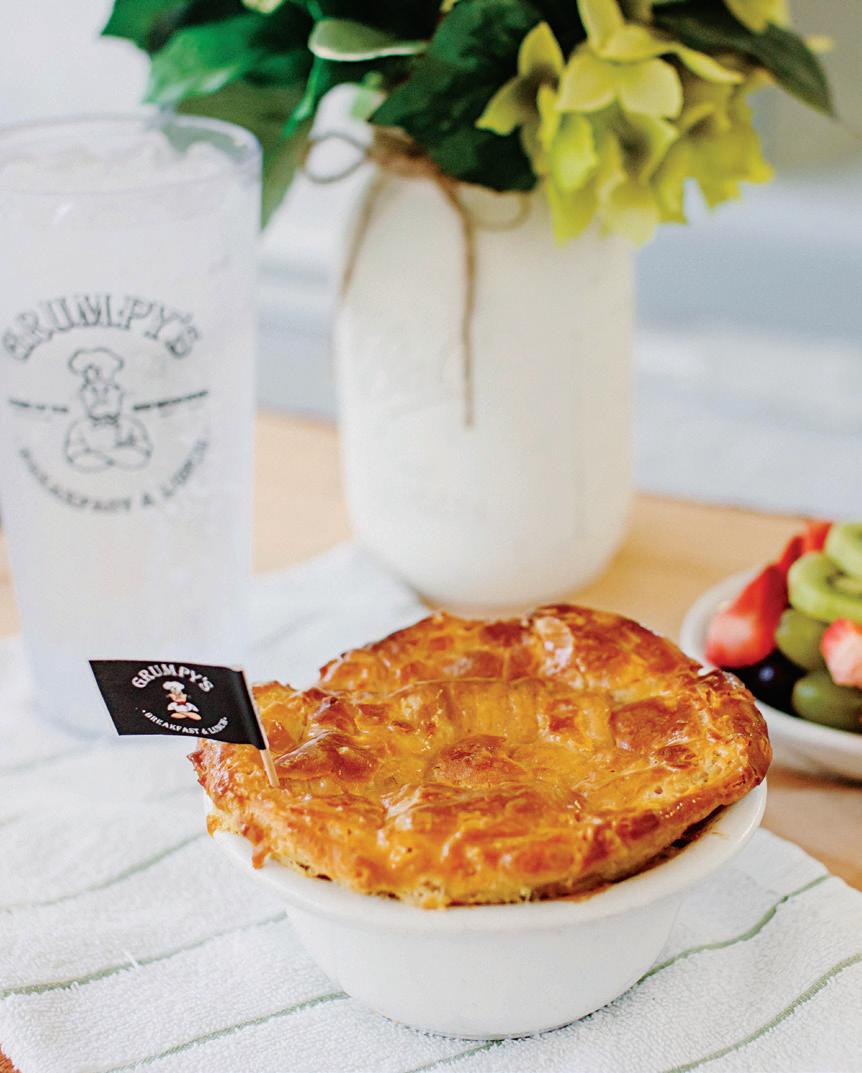
lar meals include Grumpy’s Country Breakfast, served up with two eggs your way, a choice of meat, and either pancakes, French toast, or a waffle. However, Grumpy’s is also renowned for its crazy waffle creations, which are churned out daily. A recent special included a golden brown Belgian waffle topped with a full slice of cheesecake, dripping with strawberry and blueberry compote.
At Grumpy’s, the customer can enjoy a
big breakfast of bacon, hashbrowns, buttermilk pancakes, and a hot coffee without having to dirty all the pans at home, says DeLeon; “we can get that out to you in six minutes, and it’s phenomenal.”
The menu spans over four pages, and has a lot of variety beyond their most popular homestyle favorites, including multiple Eggs Benedict adaptations, avocado toast, and a roasted turkey plate.
DeLeon says that their motto for the kitchen is, “If you can see the plate, it’s not big enough.” The brand’s portions are huge, he attests; “It’s very much a working person’s breakfast—you’re ready for the day when you leave.” What’s more truly American than that?
On maintaining the aura of a local neighborhood breakfast spot while still functioning as a franchise, DeLeon says that securing the best operators for each individual market coupled with nestling locations into suburban areas is how they overcome the challenge. “We want to be with the families and catch people on their way to work,” DeLeon says, “and then on the weekends, be very approachable and in a good location for the family to come dine. You hit a little bit of both worlds there.”
The ambience represents a neighborhood diner feel. Grumpy’s units do not have TVs lining the walls; rather, DeLeon believes “the main source of entertainment is engaging with your server.”
“Our average customer visits us multiple times a week, and it’s all built off of that rapport and that comfortability with the staff in the restaurant,” he says.
“It’s very much a family and friend environment, that we facilitate and drive.”
The tenet of engaging with customers is held so highly that store managers purposely have small offices so they are more tempted to immerse themselves in the restaurant and socialize with guests. Even though some locations do not serve alcoholic beverages, they have kept the counter to assist with the solo diner/bartender relationship. With the tagline “No one leaves Grumpy!”, the emerging breakfast brand seeks to eliminate the morning grogginess for every customer who comes through the door.
Barilla 31 www.barillafs.com
California Milk Board
www.realcaliforniamilk.com/foodservice
Ghirardelli
888-402-6262 | www.ghirardelli.com/professional
Monin
www.monin.com
NAFEM
thenafemshow.org/attend
NorthAmerican Bancard
866-481-4606 | www.NYNAB.com
North Country Smokehouse
www.NCSmokehouse.com
Progressive Commercial
888-806-9598 | www.ProgressiveCommercial.com
Red Diamond 51,
www.reddiamondbevservice.com/sample-kit/
Red Gold 11
866-729-7187 | www.redgoldfoodservice.com
Ruggiero 8 www.ruggieroseafood.com
Smithfield
www.smithfieldselect.com
Stratas .
www.stratasfoods.com
Teys USA
www.TEYSUSA.com
The Lamb Company
856-276-9700
Vito Fryfilter
847-859-0398 | shop.vitofryfilter.com
BRANDED CONTENT
Morningstar Farms . .
46, 47 www.morningstarfarmsfoodservice.com
MEAT & LIVESTOCK AUSTRALIA FLIP SUPPLEMENT
Meat & Livestock Australia flip inside front cover, 1-10, flip back cover
Eugene Drezner
VP, BUSINESS DEVELOPMENT edrezner@wtwhmedia.com | (919) 945-0705
Amber Dobsovic
NATIONAL SALES DIRECTOR adobsovic@wtwhmedia.com | (757) 637-8673
Edward Richards
NATIONAL SALES DIRECTOR erichards@wtwhmedia.com | (216) 956-6636
Mike Weinreich
NATIONAL SALES MANAGER mweinreich@wtwhmedia.com | (561) 398-2686





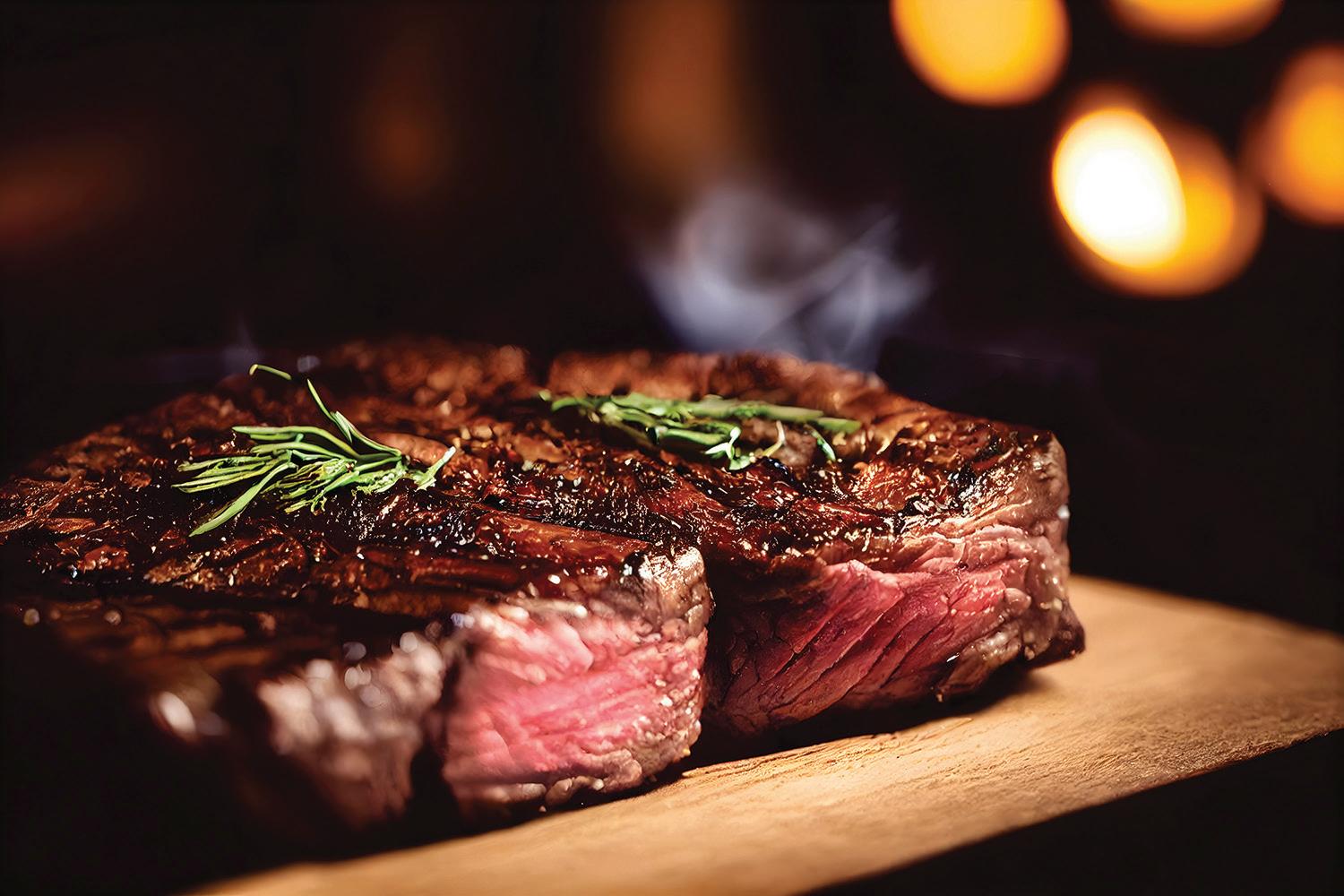

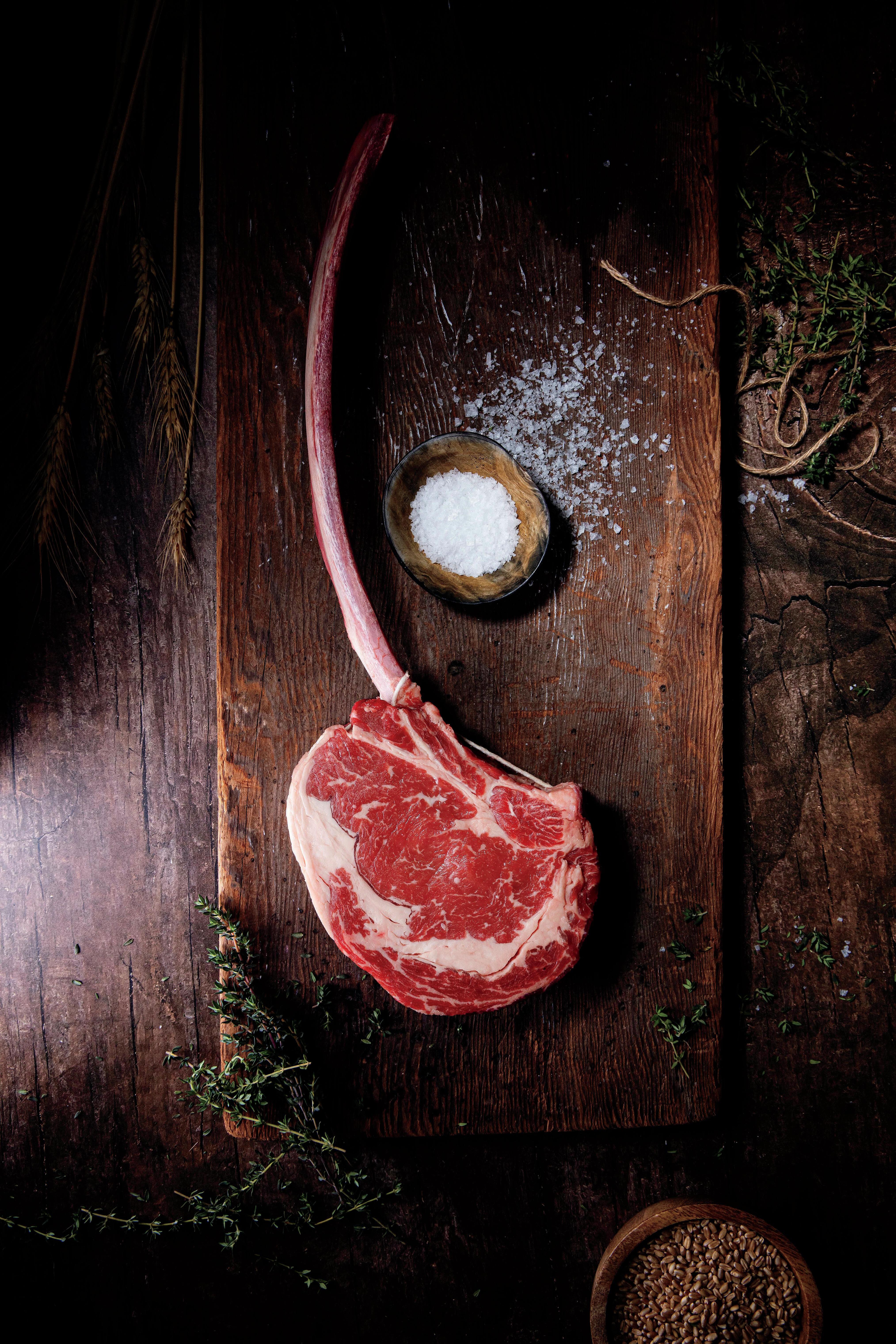
QUALITY MEETS SUSTAINABILITY
CHEFS CHOICE

CHEF & REGISTERED DIETICIAN, PAM SMITH, WEIGHS IN ON CONSUMER INTEREST IN GRASS-FED BEEF.
THE AUSSIE DIFFERENCE
LUXURY PROTEINS
®
WHY CHEFS WORLDWIDE ARE CHOOSING AUSTRALIAN MEATS FOR FLAVOR, QUALITY, AND SUSTAINABILITY. WHY WAGYU AND LAMB ARE HAVING A MOMENT

Beef and Lamb from Australia ticks all the boxes for today’s operator.
As a world-leading red meat producer and exporter, Australia delivers much more than just meat. We also deliver real advantages to foodservice professionals around the globe.
ALL YOUR RED MEAT NEEDS:





Consistent, high quality
Year-round supply of chilled and frozen cuts
Trimmed to spec for maximum yield

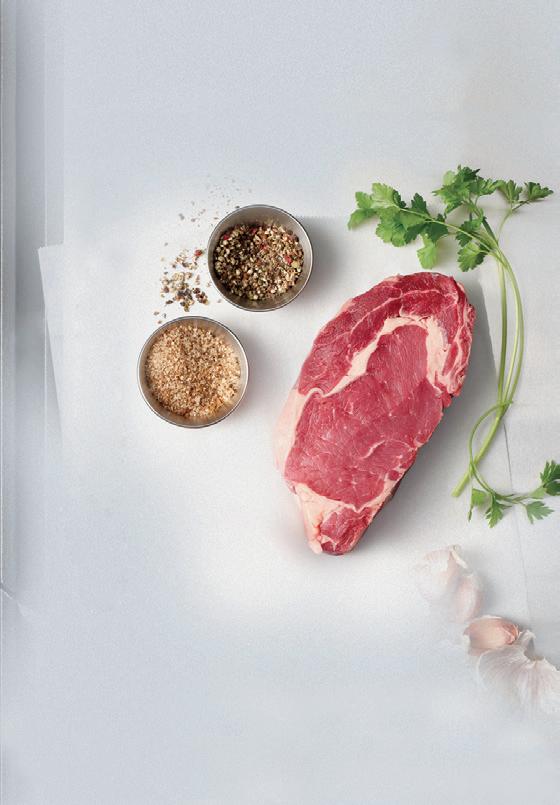
World-leading traceability systems
Operational and marketing support
Availability in US supply chains
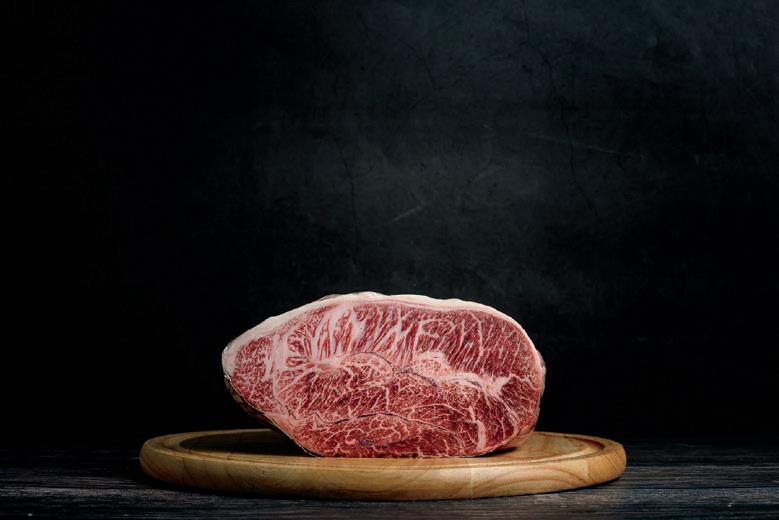

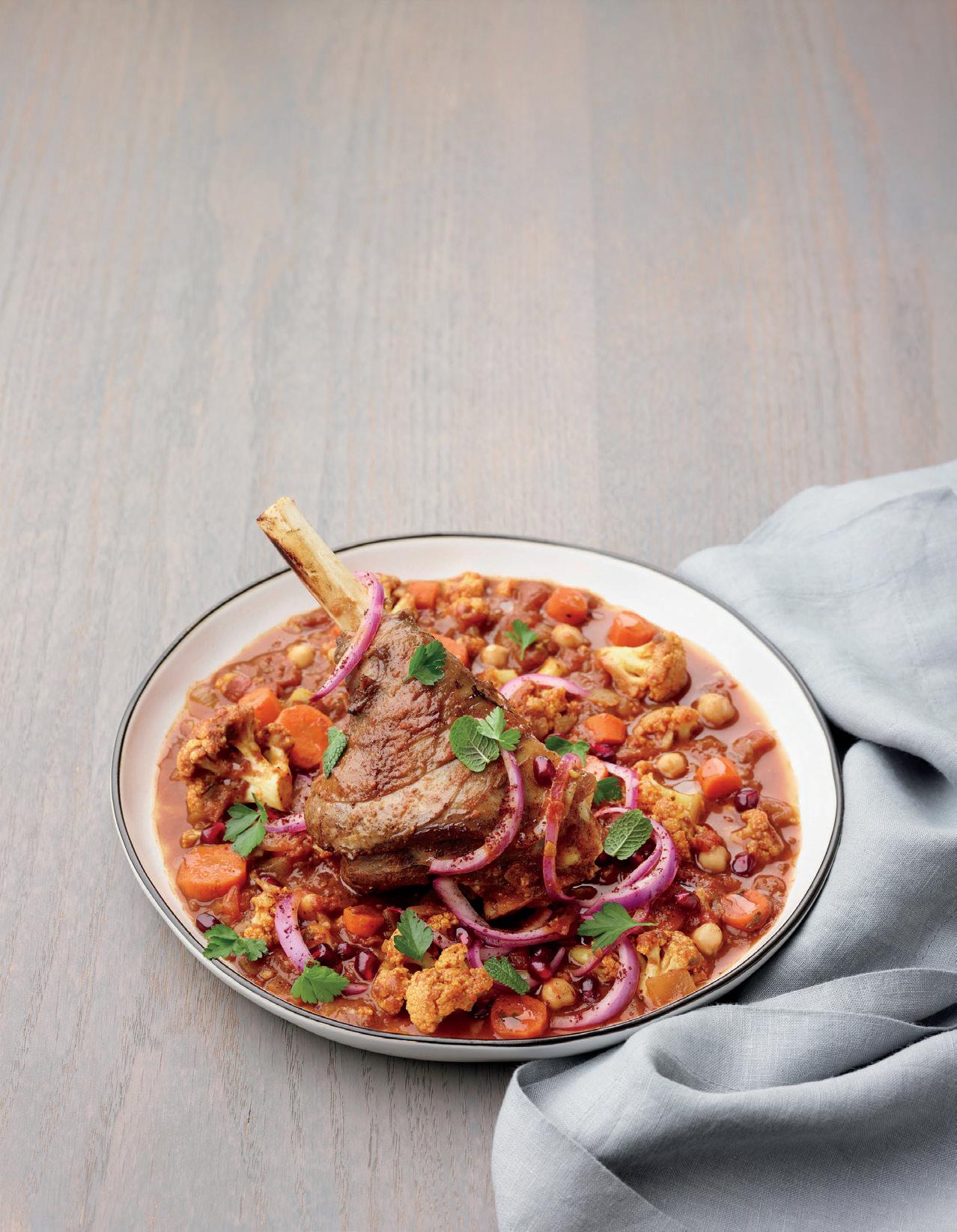




Why chefs across the world rely on Australian Wagyu for consistent quality.
BY YA’EL M c LOUD
WAGYU BEEF —a Japanese breed of cattle, renowned for its rich flavor, and marbling—has long been favored by chefs and consumers for its unparalleled taste, tenderness, and quality. However, as consumer interest grows around this beef, operators are challenged on the best way to source it. Consumers care about quality and are willing to pay more for natural, high-quality beef even as inflation is forcing them to scale back restaurant visits.
The Wagyu market is growing rapidly, with a CAGR of 7.4 percent, it is poised to grow to $3.5 billion by 2026, according to a recent study by Technavio. While only 34 percent of respondents in one study had reported having eaten Wagyu, according to the 2023 Consumer Steak Report, the popularity of Wagyu has increased as consumers seek out the quality, which Wagyu is known for.
Operators and chefs must perform their due diligence in sourcing the highest-quality beef. L.A. Chef Jason Fullilove shares his recent experience visiting Australian farmers down under. “It really was an amazing experience, and I’m still talking about it unprompted all the time,” Fullilove says. “What stands

out the most is the care and attention put into the animals at every stage. That care shows up in the quality, it’s truly a cut above the rest.” This is not surprising since Aussie Beef & Lamb brags the largest Wagyu herd outside of Japan, and some of the best Wagyu genetics.
Aussie farmers’ transparency with chefs and consumers allows for greater confidence in how Wagyu is produced. “One moment I go back to—we were at the Stockyard feedlot, and they were feeding the Wagyu cows fresh steamed oats and barley,” Fullilove says. This high-quality diet can be tasted in the finished product because Aussie Beef & Lamb doesn’t feed corn or soy the meat carries a richer, umami flavor that consumers and chefs love.
Fullilove, like many chefs, was eager to highlight Aussie Wagyu in his restaurants. “I have Aussie Wagyu striploin on the Norma menu now,” Fullilove says. “It’s excellent on its
own. I like to keep it super simple –just salt and pepper, either grilled or seared in cast iron and surrounded by the right accompaniments. I want consumers to taste the natural, deep beef flavor, and get the pure experience.”
Chefs can use various Wagyu cuts to increase dish prices and heighten consumer interest. From steak cuts to braising cuts—imagine Wagyu brisket bacon, Wagyu skirt steak frites, and even ground Wagyu for burgers— the luxury appeal of Wagyu beef can be highlighted in various dishes and relied on by chefs to drive positivemargin innovation across the menu.
Furthermore, chefs and operators can discover a full range of marble scores from 0—9 plus to find the cut and price point that suits their menu. With the market for Wagyu beef poised for significant growth in the coming years, sourcing from Australia allows operators to offer a dining experience that is truly exceptional and repeatable. ❖

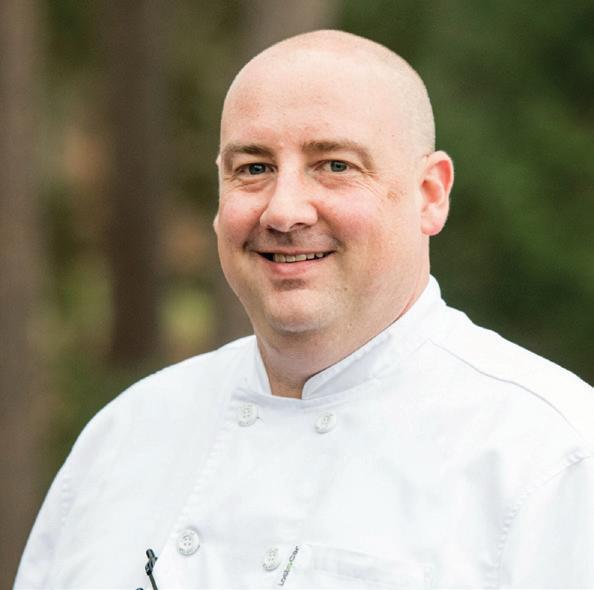
From luxury to sustainable and healthy, see how chefs are menuing red meat.
BY YA’EL M c LOUD
EVEN IN THE FACE OF INFLATION, diners are spending more dining out than in previous years. Americans spent $1.5 trillion in 2023 outpacing food-at-home spending by half a trillion dollars, according to the US Department of Agriculture’s Economic Research Service. However, consumers are not becoming any less distinguishing in their preferences or tastes, and value is at the forefront of every consumer's mind. Forty-five percent of consumers reported get-
ting the most value for their money as the most important factor for a good dining experience, according to a 2023 survey from Ipsos. Operators must serve high-quality food that meets consumers' mounting expectations to remain competitive.
Protein is the center of most dishes and not something operators can afford to skimp on when it comes to quality. Chefs worldwide depend on Australian meat from grass- and grain-fed beef to premium proteins like Wagyu, and lamb. Americans love beef, a well-known fact, but are looking for premium meats when they choose to dine out and are willing to spend extra to achieve this goal. In fact “steak” topped the list on a recent Menu Matters consumer study
that asked what item they wouldn’t compromise on.
“People are looking for little luxuries and indulgences for a host of reasons; escapism, self-care, or just a bit of joy in a stressful time,” explains Maeve Webster, president of Menu Matters. “Food is a great outlet for that. For meat eaters, a protein upgrade is well worth the expense. They’ll happily trade up for the Wagyu or the Australian lamb to get a more exclusive experience.”
Australian lamb and beef have long been regarded as quality protein amongst chefs and consumers. Now more than ever consumers are seeking out memorable experiences when they dine out, splurging on Australian Wagyu is not surprising. Sustainable supply is vital in these cases, and with Australia having the largest Wagyu herds outside of Japan, and some of the best Wagyu genetics, North American chefs have a dependable source.
Chef James Patterson, corporate chef of McConnell Golf, explains the changes he has seen in consumer preferences when they dine out. “Especially in the dinner dayp-
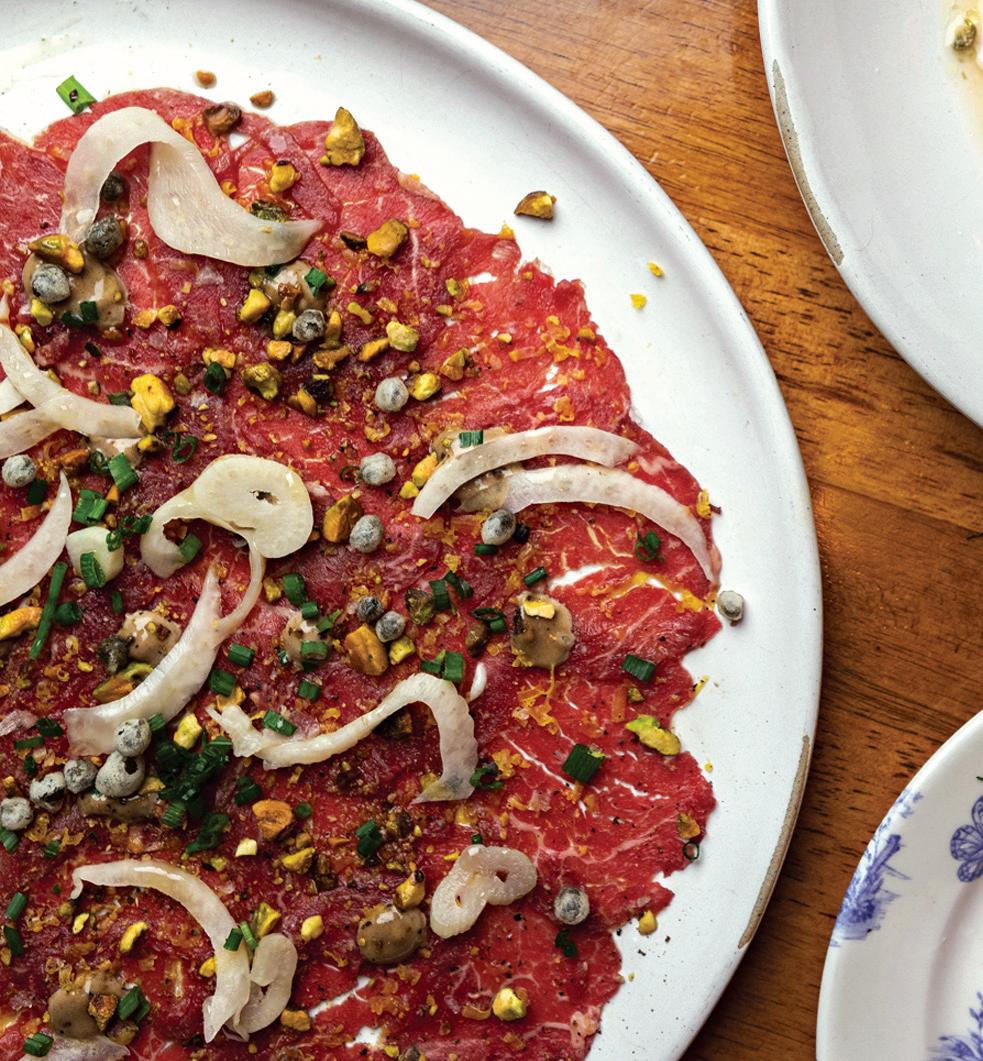
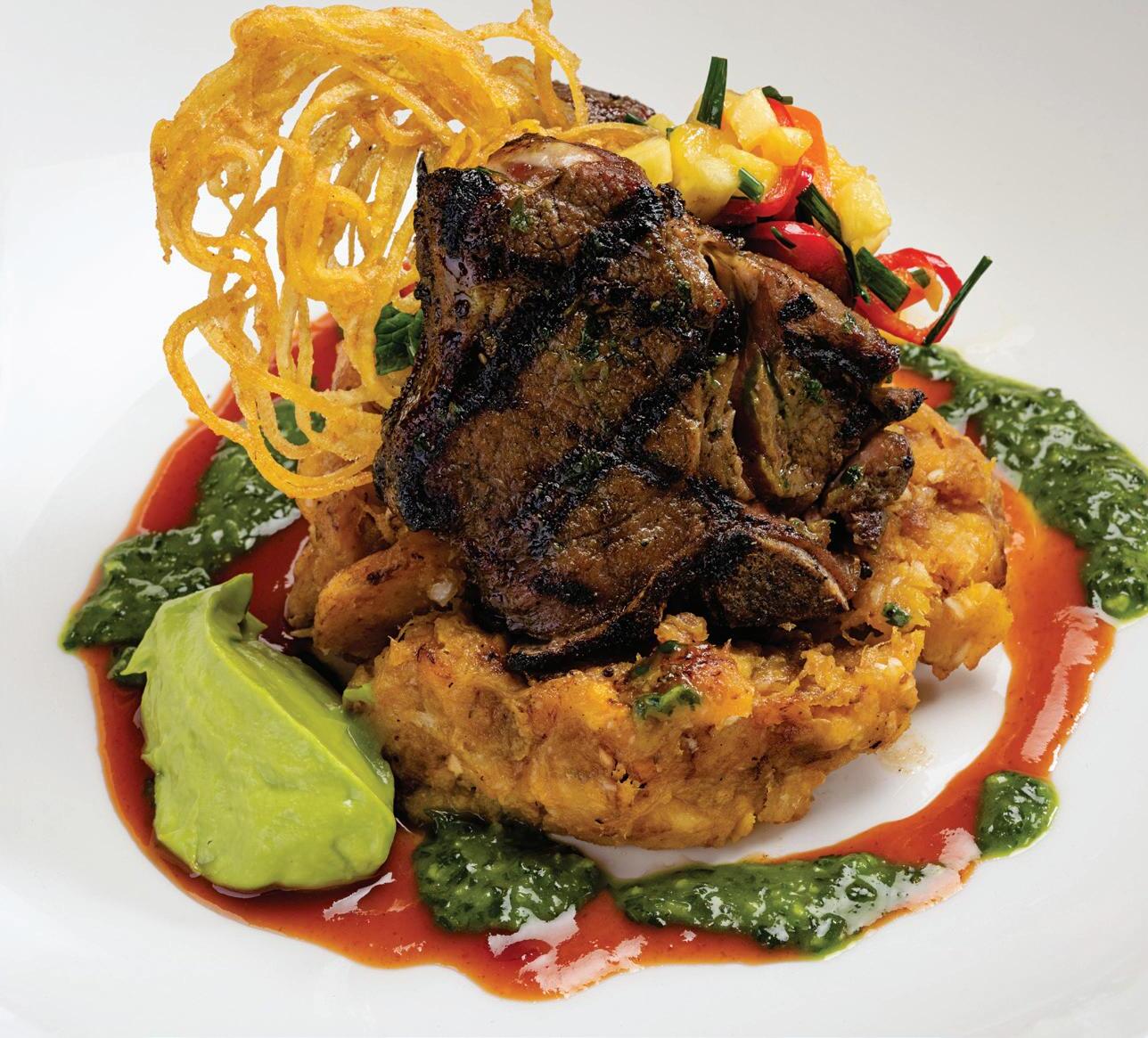

art, our guests are looking for more than a meal; guests want an experience and something a cut above the everyday choices. That means premium proteins like lamb and Wagyu from Australia. It also means tableside service, and action stations at catered events.”
Younger consumers are not only looking for luxury, they are looking for restaurants that can provide premium proteins being served in bold ways with consideration for flavor, health, and sustainability claims.


chef for the Gibsons Restaurant Group, meeting younger consumers where they are by offering clean, natural, animal-welfare-friendly meats they can feel good about ordering is key. When operators and chefs can deliver meat that is “good for me, good for the planet, good for the animals,” everyone wins, and beef & lamb from Australia, with its worldleading standards of care, meets those criteria.
Chef Nelson Millán of Texas’ renowned Vaquero Club was able to


visit Aussie farms in person and was further impressed by the care once he was able to see the livestock and operations. “I’ve been to many farms all over, especially here in Texas, the land of beef, so it was going to take a lot to impress me! I would say Australia has it down to a science,” Millán says. “From the embryos and genetics to the health of the animals, every detail is carefully managed, including rotational grazing and specific feeds, all to ensure a product that’s not only better to eat but better for the planet too.”
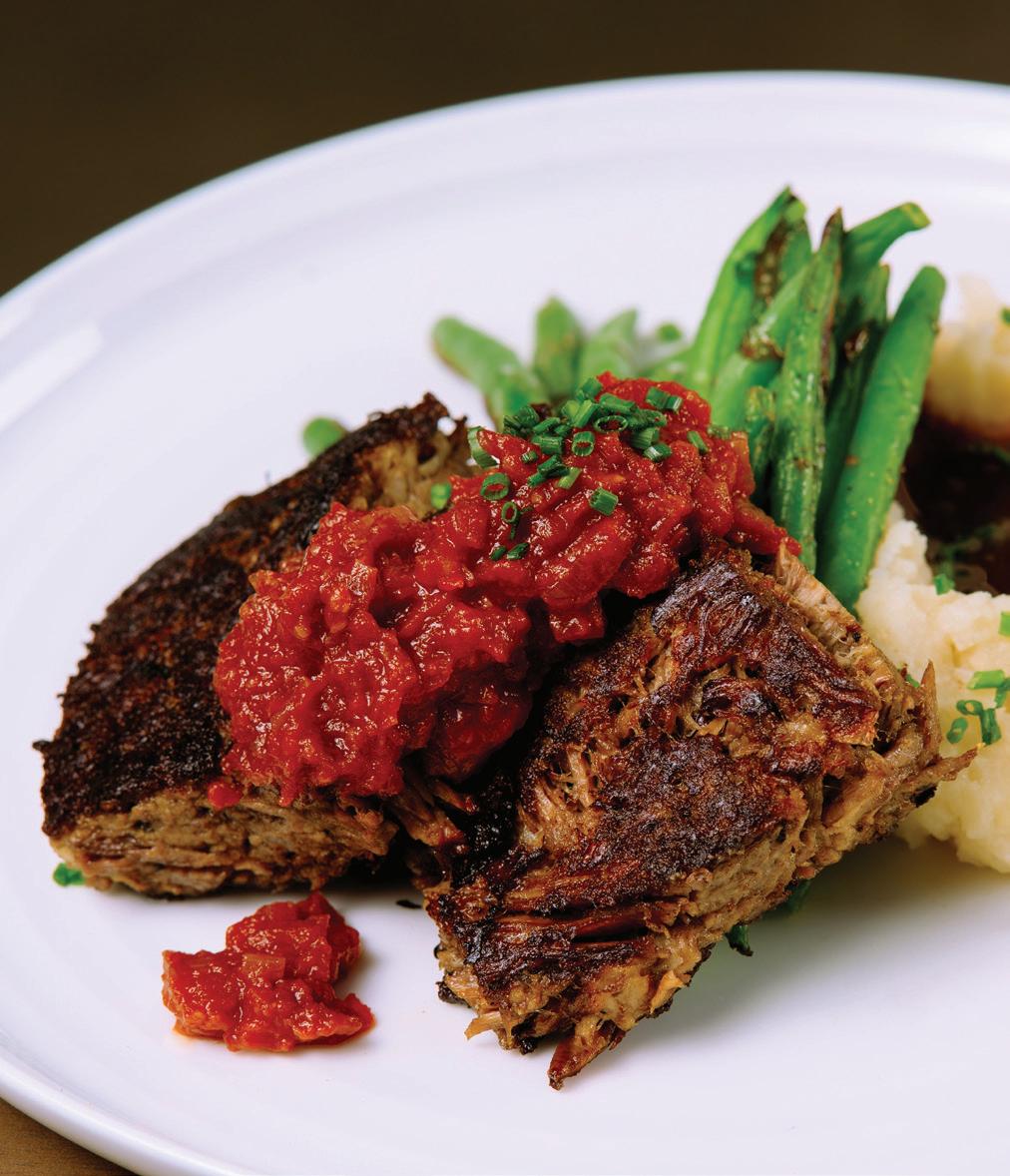
That need for consistency is exactly why chefs and consumers around the world trust Aussie beef & lamb to deliver on key attributes. “The grassfed product out of Australia is just built different,” says Miami chef and Top Chef Alum Jeff McInnis. “It’s got excellent marbling, it’s tender, and has that true beefy flavor that we’re looking for. Wearing my procurement hat, Aussie cuts are so well trimmed that I get great utilization, around 90 percent. It’s clean and export systems are so good, I can bring in whole primals and not worry about shrink.”
In a dining landscape where value, quality, and experience reign supreme, operators must rise to meet evolving consumer expectations. Diners are willing to spend more, but they demand premium offerings, particularly when it comes to protein.
According to Dan Huebschmann,
At the end of the day, chefs and operators need to know that this is a product that will have consistency from inventory to yield and quality.
Australian beef & lamb, with their reputation for excellence, is perfectly positioned to satisfy this craving for indulgence and distinction. Whether through grass-fed beef, luxurious Wagyu, or tender lamb, these proteins offer the premium quality that today’s diners seek. By incorporating bold flavors, celebrating sustainable practices, and elevating dining experiences, operators can meet consumer demands and create lasting, memorable meals that keep guests coming back for more. ❖
Australia’s world-leading meat grading system, Meat Standards Australia (MSA), is the only eating quality grading system that couples eating quality prediction of individual red meat cuts with recommended cooking methods. By using MSA graded product along with the recommended cooking methods, you can rest assured that you will meet consumer expectations around the world.
KEY POINTS
Allows you to extract more value out of each cut by confidently purchasing fit-for-purpose products and segregating on quality.
If a cut doesn’t meet a minimum level of quality, it doesn’t receive an MSA grade.
MSA-backed Australian brands consistently deliver the same high-quality taste, juiciness and tenderness.


Millions of consumer taste tests around the world have shown that consumers consider taste, tenderness and juiciness to be vital when determining eating quality of red meat.
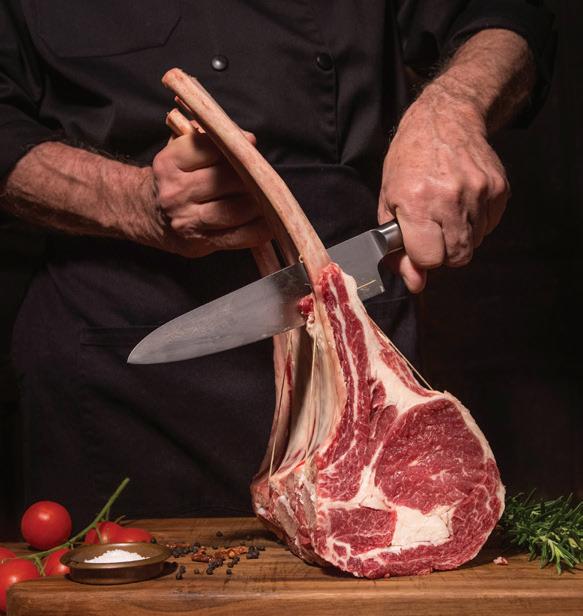
Marbling only accounts for 15% of a consumer’s eating experience – that’s why we measure and include 1 traits in the MSA model.












The key differences between MSA and USDA grading include; 1) the USDA system only measures two factors that directly impact eating quality, compared to MSA’s fourteen factors, and 2) USDA grading applies a blanket grade across an entire carcase while MSA accounts for variation between cuts and grades individual cuts on their predicted eating quality.


MSA is the world’s most accurate meat grading system to predict and guarantee the consumer’s eating experience for tenderness, juiciness, flavour and overall liking.
Most Australian beef processors are licensed to participate in the MSA program.

Scan the code to search the MSA | Australian Exporters Database
Whole carcasse quality grade based on marbling and maturity (ossification)
Producer-focused grading to justify carcase value
All primals receive the same grade = less ability to differentiate quality.
Individual cut-based eating quality prediction – accounts for aging and cooking method
Considers 14 factors from paddock to plate that influence eating quality
Individual primals receive their own grade – extract more value out of each cut
THERE ARE MANY DIFFERENT INPUTS THAT IMPACT EATING QUALITY (IT’S NOT JUST MARBLING)...
MSA incorporates these factors that affect eating quality when grading beef.

expecting more high-quality lamb options from restaurants.
ent applications that are appropriate in every setting from quick service to fine dining.
Brooks, an Australian native, is currently opening up a new restaurant, Sunnys Steakhouse, where he is eager to showcase lamb on the menu. “On the menu for my new restaurant, we are doing a new cut of lamb—the saddle—which is the loin, belly, and tenderloin. We process it, break it down, and use the belly to wrap it, then it is roasted whole,” Brooks shares. “Our guests are going to love it.”
Lamb from Australia is a cut above due to their high-quality genetics, free range, and natural diet, and stress-free lifestyle. This is important as it is a growing concern for consumers who want leaner meats with a grass-fed diet, and chefs looking for product with graded, consistent eating quality to serve to their clientele. All Australian lamb in the U.S. is also halal, a certification that’s gained a lot of importance in recent years.
BY YA’EL M c LOUD
BEEF HAS LONG BEEN the protein of choice for Americans, however, a different red meat is growing in popularity as it is discovered by more diners. Lamb is increasing in sales and across menus. In fact, lamb imports are expected to reach 305 million pounds in 2024, a 7 percent increase from last year, according to the USDA.
The increased familiarity with lamb is, in part, due to popular fast-casual brands like CAVA menuing the protein. Due to this familiarity, consumers are
Aussie lamb is the number one source of quality lamb in the U.S., and stands out as a prime example of quality production, husbandry, and sustainability. Aaron Brooks, formerly the executive chef for the Four Seasons Hotel in Miami, Florida, and a specialist in preparing lamb, shares why Aussie lamb is his first choice.
“Lamb is a flavor and protein that I grew up eating,” Brooks says. “There are some great proteins in the U.S., but the consistency in the Australian lamb is fantastic. The marbling, tenderness, and care from animal husbandry to processing is unmatched.”
Furthermore, lamb’s versatility is key for chefs as they can use it in differ-
Furthermore, Aussie lamb provides chefs with the opportunity to serve a uniquely flavored protein option to consumers who are looking for internationally influenced flavors and cuisines. “I think chefs and operators should give lamb a try because lamb takes a lot of flavor, spice, and heat,” Brooks says. “It is a flavor-forward protein that consumers like once they try.”
As consumer demand for highquality lamb continues to rise, operators have a valuable opportunity to differentiate and meet that growing interest in global cuisines by offering lamb dishes. Aussie lamb, with its unmatched, tenderness, mild flavor, and sustainable practices, provides a reliable and flavorful option. With top chefs like Aaron Brooks showcasing innovative lamb preparations on their menus, and multi-unit brands making lamb mainstream, Australia is wellpositioned to help restaurants satisfy evolving consumer preferences and elevate their protein offerings. ❖
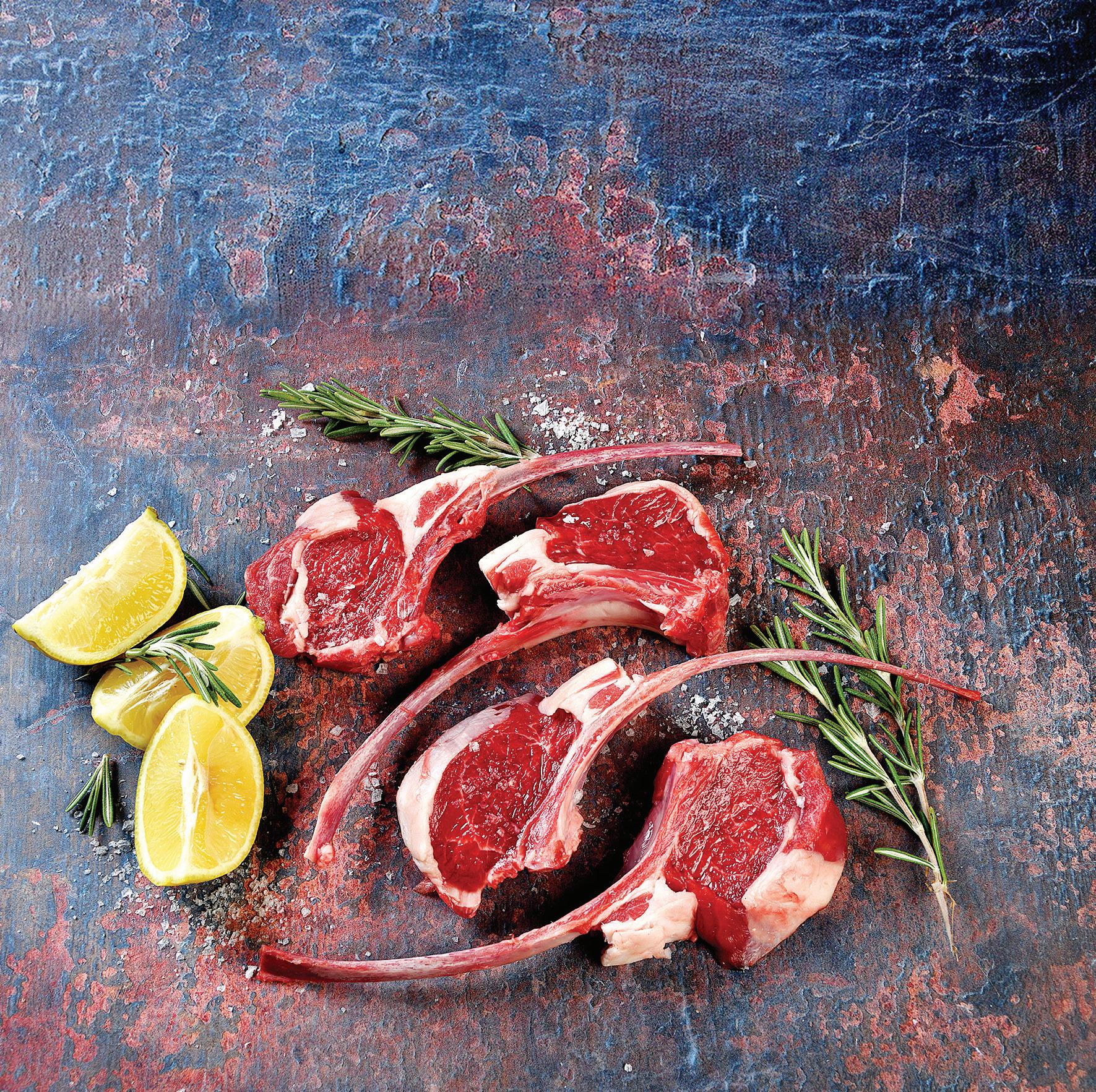
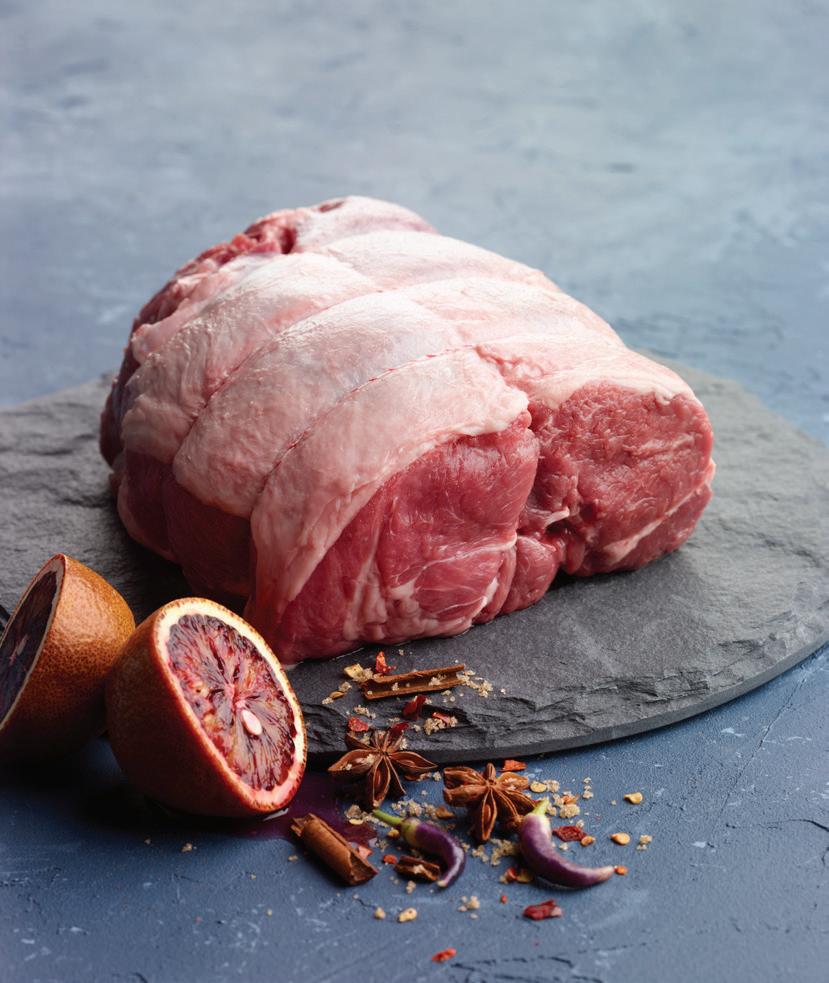
Meat aging occurs as muscle fibres are slowly broken down by naturally occurring enzymes, resulting in more tender beef with improved eating quality.
The aging process doesn’t affect the appearance or safety of the meat, as the breakdown of muscle fibres occurs at a microscopic level with no visible change in the product.

Beef and Lamb exported from Australia is Halal eligible, and Australia is a trusted supplier of halal beef and lamb to more than 70 countries around the world, including the Middle East.
Certified by the Australian Government Authorised Halal Production System (AGAHP), which includes product identification, and
processing and segregation controls, you can be sure you’re getting clean and safe Halal meat from livestock raised in a natural, stress-free environment with clean air, sunlight, lush pastures and fresh water.

This means the journey from Australia improves the eating quality of your beef and lamb as it makes its way to you.
Fresh beef and lamb are vacuum packaged to maintain quality, inhibit bacterial growth and ensure extended shelf life that you can count on.
For more information about the AGAHP program scan the QR code.
foodservice.aussiebeefandlamb.com
@aussiebeeflamb











Increased consumer concern for health leads to demand for grass-fed beef.
BY YA’EL M c LOUD
from their beef than ever before. Beyond typical attributes like taste and texture, animal welfare and social responsibility are now part of the calculus, and they are interested in where their food comes from and how animals are raised. According to a study from The Food Industry Association, approximately 83 percent of consumers take into account environmental, animal welfare, social responsibility, or a mix of the three when buying meat and poultry.
Menuing grass-fed beef is a simple way for chefs and operators to respond to that demand for healthier, responsibly sourced beef. Health claims drive younger consumers in particular who prefer grass-fed beef, in fact, 56 percent of millennials prefer grass-fed beef in large part due to its health halo, according to studies by the Food Marketing Institute. Chef and registered dietician Pam Smith weighs in on these claims and shares how consumers are enjoying grass-fed beef across menus from Disney to Firebirds Wood Fired Grill.
“As a nutritionist, I love it. It’s a nutrient-dense package—not only a high-quality protein, but one naturally rich in zinc, iron, omega-3’s,
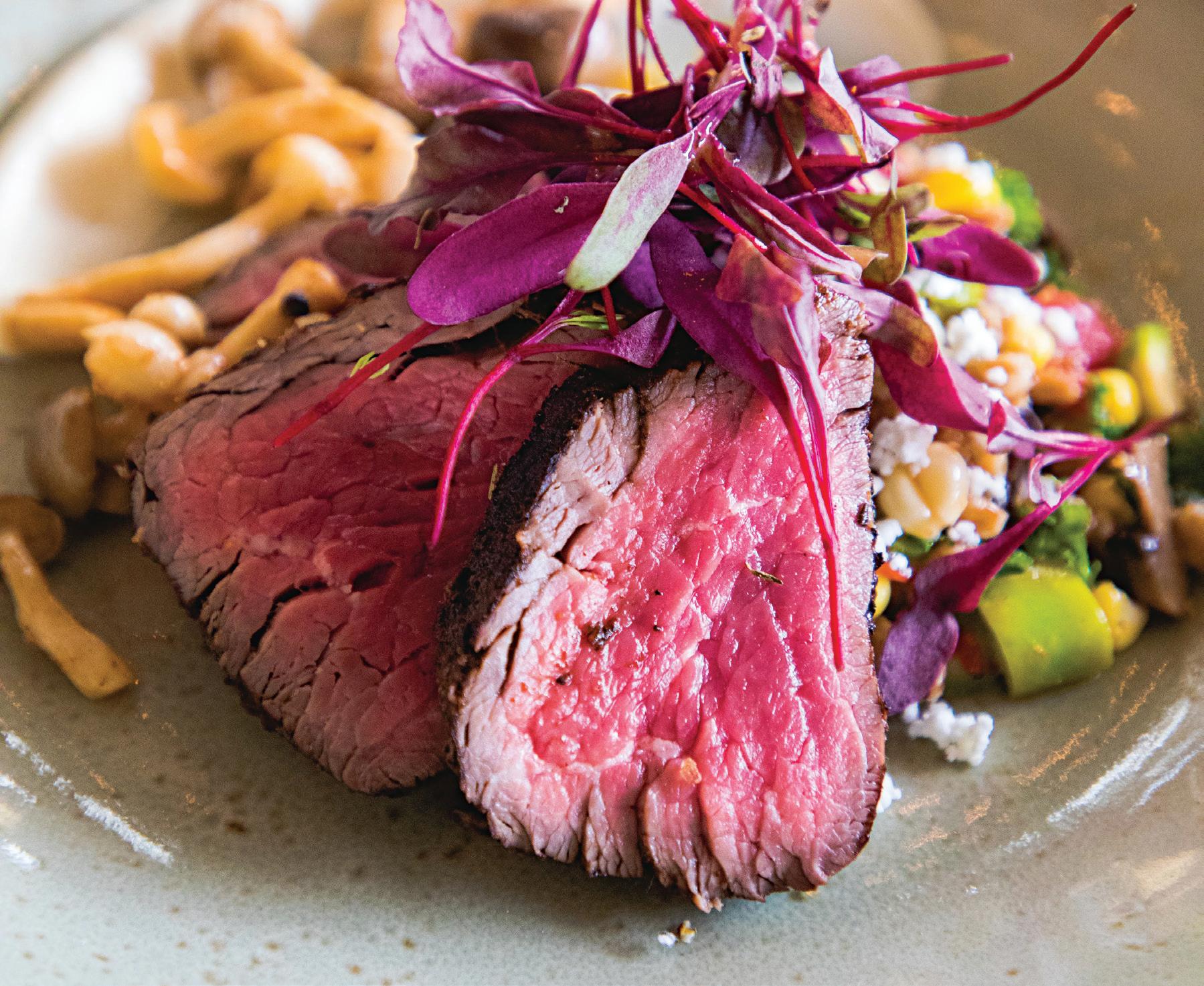

and essential fatty acids—just a 3.5–4-ounce portion packs a powerful punch when it comes to wellness,” Smith says. “I celebrate that it’s raised sustainably without antibiotics and hormones.”
While consumers and nutritionists appreciate grass-fed beef’s health halo, chefs may struggle to consistently find supply, as domestic grass-fed beef is limited in volume and often seasonal. Fortunately, Australia is a world leader in exporting chilled, premium, quality-graded grass-fed beef and has been providing tender, delicious, grass-fed beef to chefs around the globe for decades. Meat Standards Australia (msa), a modern and highly predictive quality grading system built for grass-fed meats underpins that qual-
ity, so buyers know they’ll have satisfied guests when that beef hits the plate. Add in traceability all the way to the farm, thanks to world-class quality systems including Australia’s nationally mandated livestock identification program, and you can tick a lot of boxes to answer consumer and chef needs around beef.
But where does it belong on the menu? “Ground grass-fed beef is naturally lean and delicious and works so well in a burger, meatball, meatloaf, or taco applications, it’s my most used tool in the protein arsenal,” Smith says. “With my menu development leaning towards “delicious wellness” and plant-forward—I often blend the ground beef with roasted ground mushrooms for added flavor and to get more veggies in the mix.”
“Healthy items on the menu have long been a challenge for operators, who often find that guests who say they want healthy choices don’t seem to order them,” Smith says. “Grassfed beef can break through that barrier because it’s got the superpower craveability of beef! It lets the guest know they can feel good about their choice, and not have to sacrifice flavor or satisfaction.” ❖
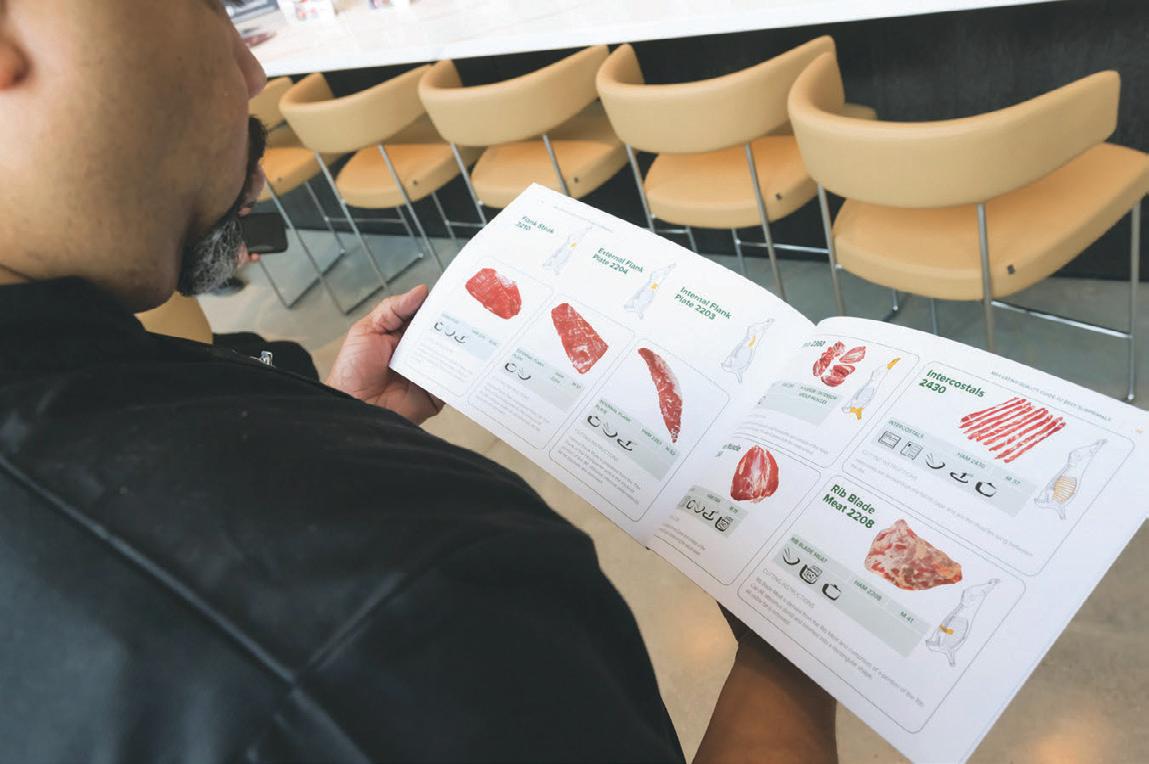

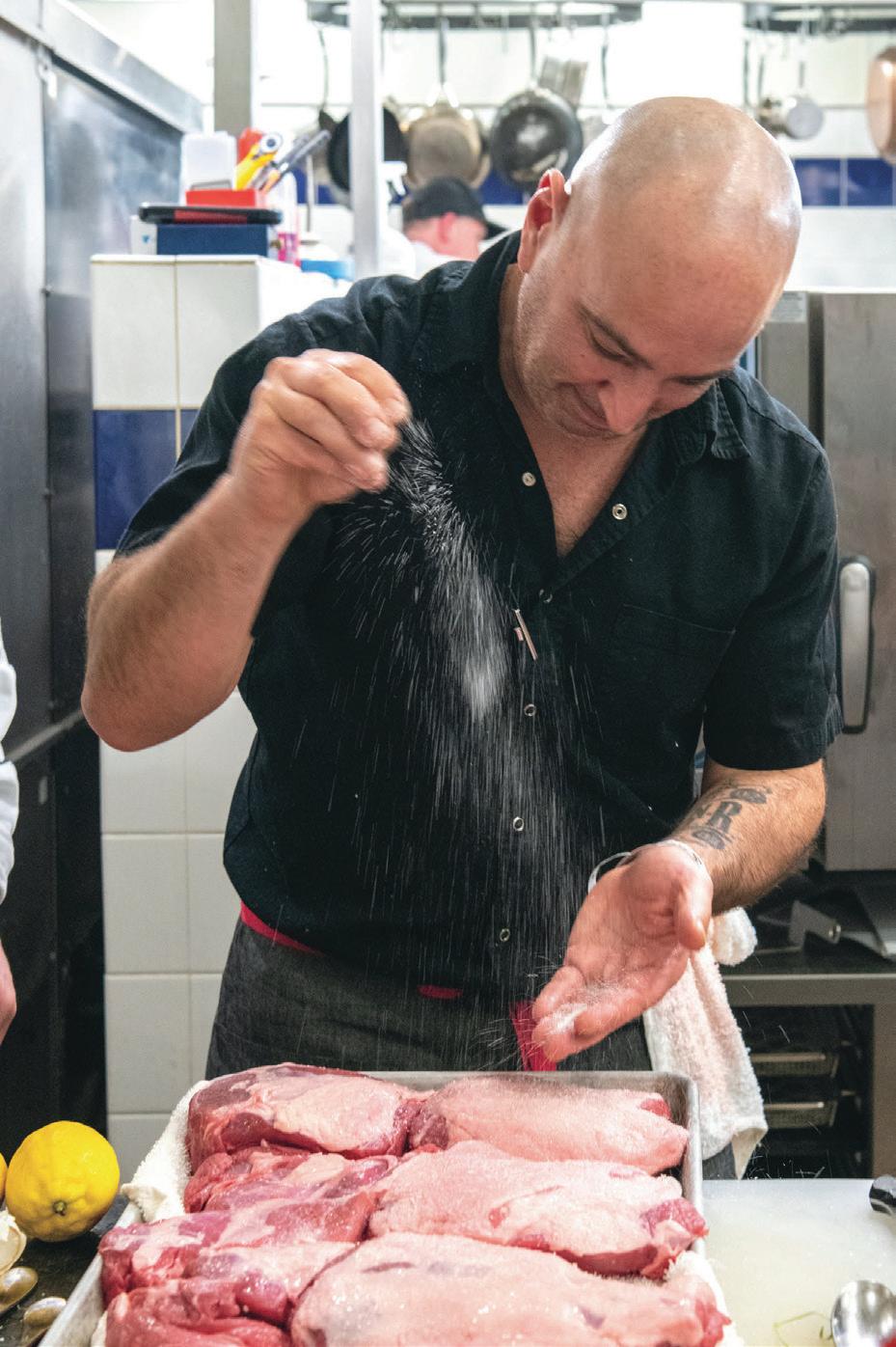

Educational resources and front-of-house staff training
Butchery training & insights

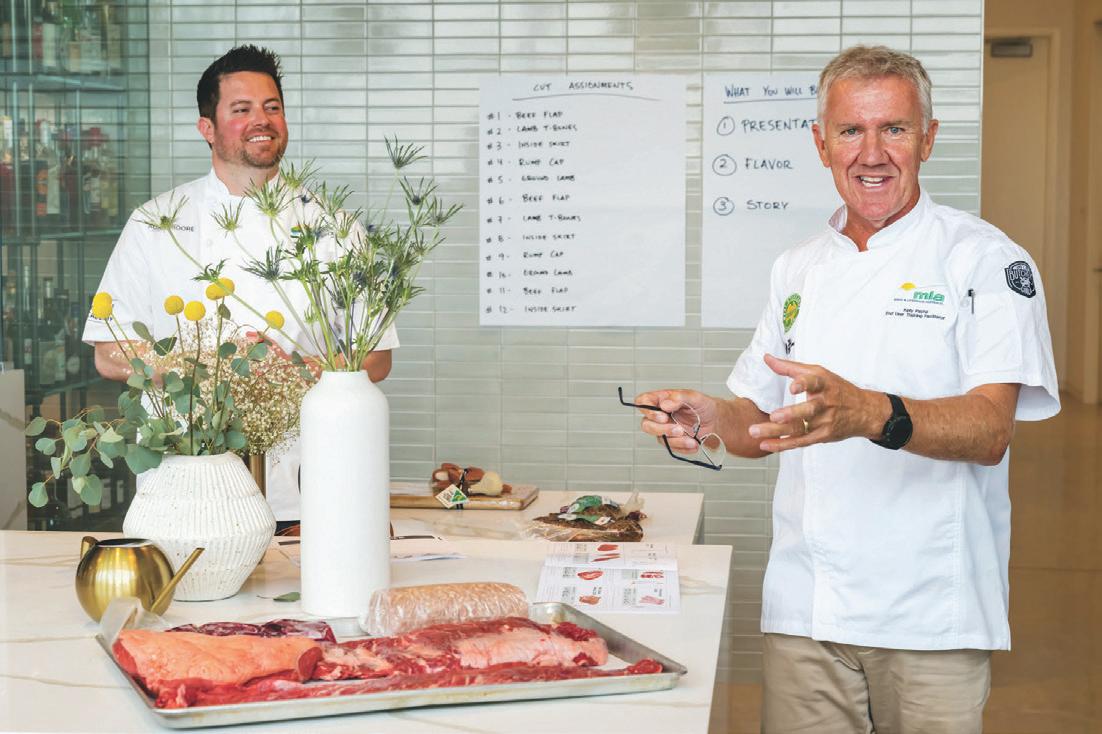



Insights on foodservice and red meat trends from the experts at Menu Matters.




